https://www.blackgate.com/
Sword & Sorcery on a Post-Apocalyptic Earth: Blackmark by Gil Kane
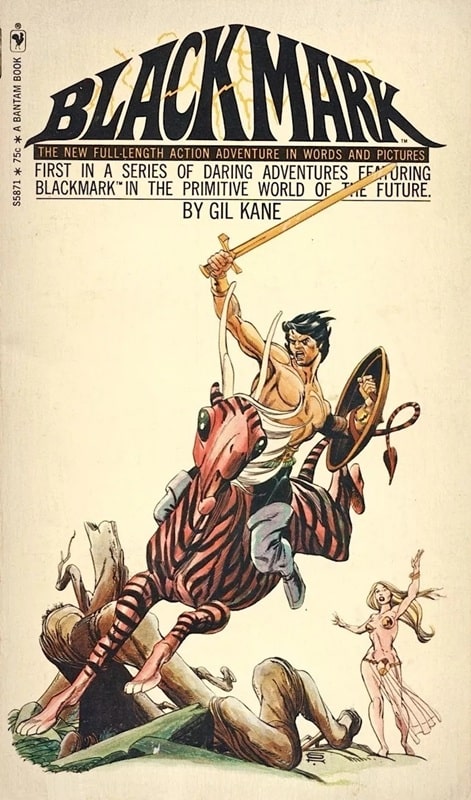
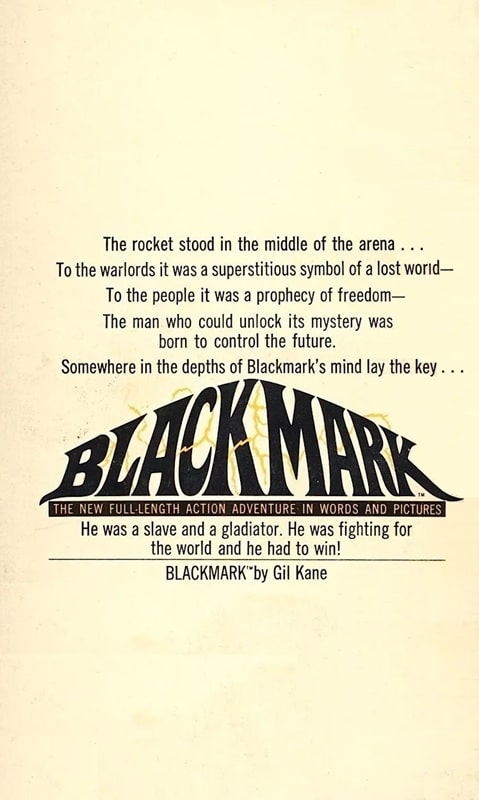
Blackmark by Archie Goodwin and Gil Kane (Bantam Books, January 1971). Cover by Gil Kane
As I’ve mentioned before, I didn’t grow up with comics. They weren’t available in my small, rural town of Charleston, Arkansas in the 1960s and 70s. The first store to carry them appeared around ’74 and had a small spinner rack with a dozen or so titles. By then I was already reading regular books and the comics, while they had interesting art, had much less story than books. I bought a few but never got hooked and knew virtually nothing about any comics creator.
As an adult in my fifties, I watched a movie called The Watchmen, which was very good, and I bought the original graphic novel by Alan Moore. I was blown away by the complex storytelling and started buying other graphic novels. I finally started to learn about some of the great comic book creators over the years. I still don’t consider myself a comic book reader but I keep an eye out for items that might interest me. That’s how, in 2019, I found a cool little book called Blackmark, “by Gil Kane.”
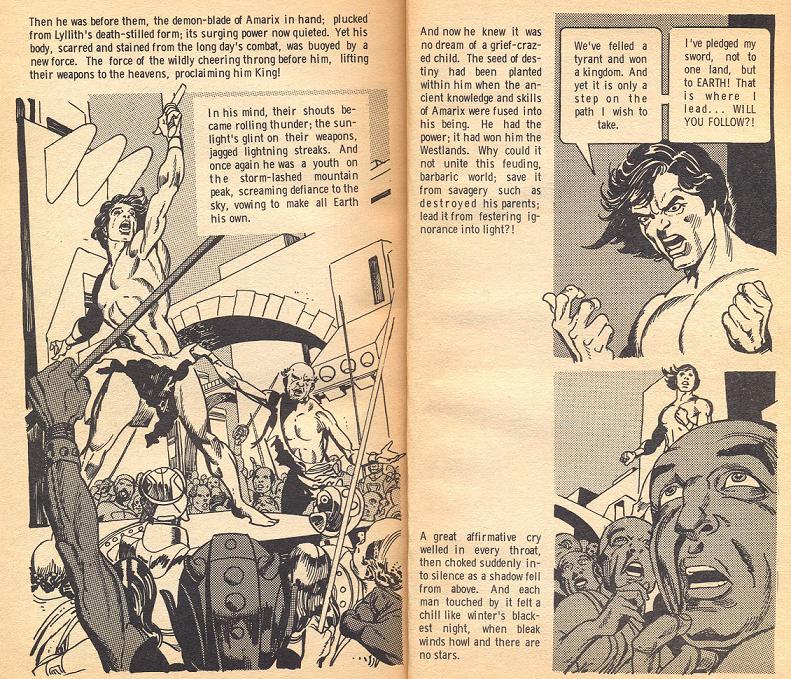 Interior pages from Blackmark. Art by Gil Kane
Interior pages from Blackmark. Art by Gil Kane
Gil Kane (1926 – 2000) was born in Latvia as Eli Katz but immigrated with his family to the US at about 3. He lived in Brooklyn and started working in comics at an early age. By 16, he’d found full-time employment and quit high school.
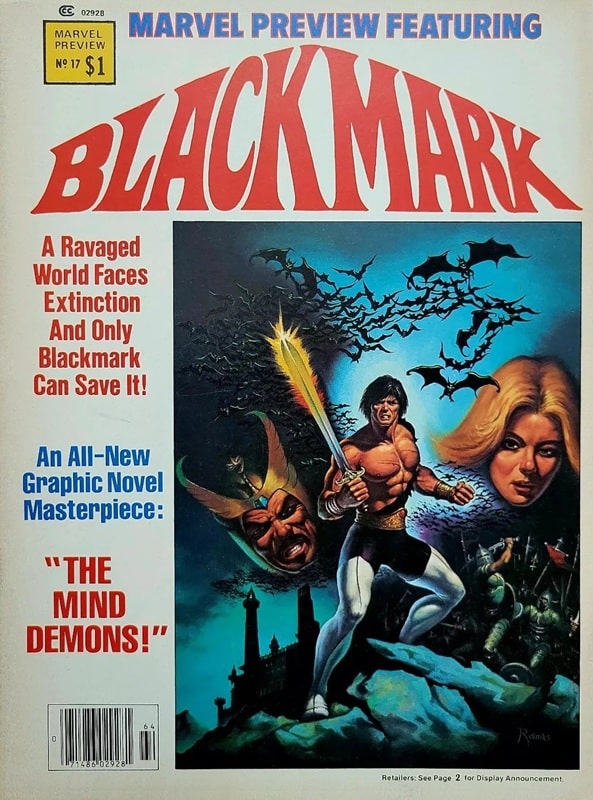 Marvel Preview #17, containing the sequel, Blackmark: The Mind Demons (Marvel Comics, Winter 1979). Cover art by Romas Kukalis
Marvel Preview #17, containing the sequel, Blackmark: The Mind Demons (Marvel Comics, Winter 1979). Cover art by Romas Kukalis
He’s best known for helping create Green Lantern and Iron Fist, none of which I’ve ever read. In 1971, working with a scripter named Archie Goodwin, he created Blackmark (from Bantam), one of the earliest graphic novels. It’s set on a post-apocalyptic Earth and is more sword & sorcery than sword & planet, but it has that exotic S&P feel I crave.
From what I understand, Kane created the setting and characters and did all the art. He provided an outline for the script to Goodwin, who then did the writing. Each page has an illustration or two with squares of story around them. There’s a lot of story, which I appreciated.

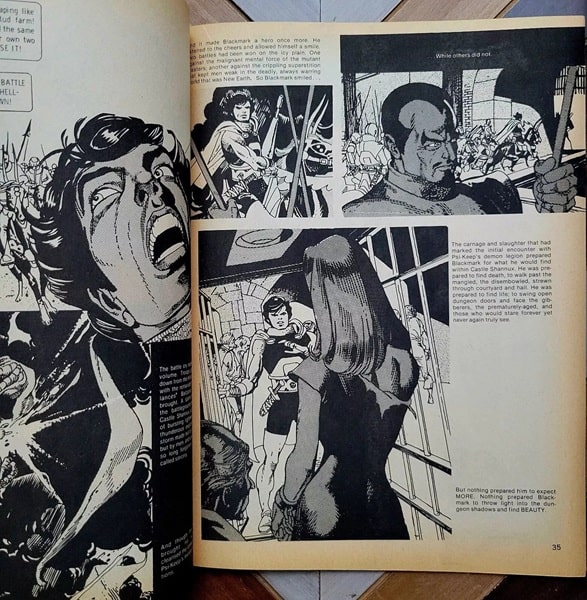
Interiors from the Marvel Preview #17. Art by Gil Kane
The art is great but the script is just wonderful. It’s way over the top sword and sorcery prose and I enjoyed it tremendously. Here’s a taste:
Blackmark awoke to shrill, inhuman cries. Dawn had brought new horror on flapping wings.
I highly recommend Blackmark to readers of S&P fiction.
Charles Gramlich administers The Swords & Planet League group on Facebook, where this post first appeared. His last article for Black Gate was The Sword & Planet Tales of Ralph Milne Farley.
What Possessed You? — Part II
 The Vatican Tapes (Lionsgate, July 24, 2015)
The Vatican Tapes (2015) – Prime
The Vatican Tapes (Lionsgate, July 24, 2015)
The Vatican Tapes (2015) – Prime
Imagine my excitement when I read that Mark Nelvedine (The Crank movies, Ghost Rider: Spirit of Vengeance, Gamer) had made an exorcism flick. This was bound to be bonkers!
Oh, foolish lamb that I am.
This limp rag of a horror film had all the bite of a blob fish, and half the appeal. In order to hit that sweet PG-13 demographic, the film has been neutered to such an extent that it was virtually blood-free. Any onscreen nastiness takes place with the victim’s back to the camera, and none of it is helped by illogical editing choices.
It’s a waste of talent too — Dougray Scott, Michael Peña and Djimon Hounsou plod through the proceedings with all the enthusiasm of a 7th-grader getting a vaccine shot, and the poor young woman who is the subject of their attention is played by Olivia Taylor Dudley, who I can only presume was asked if she could do a Kristen Stewart face.
Boring.
4/10
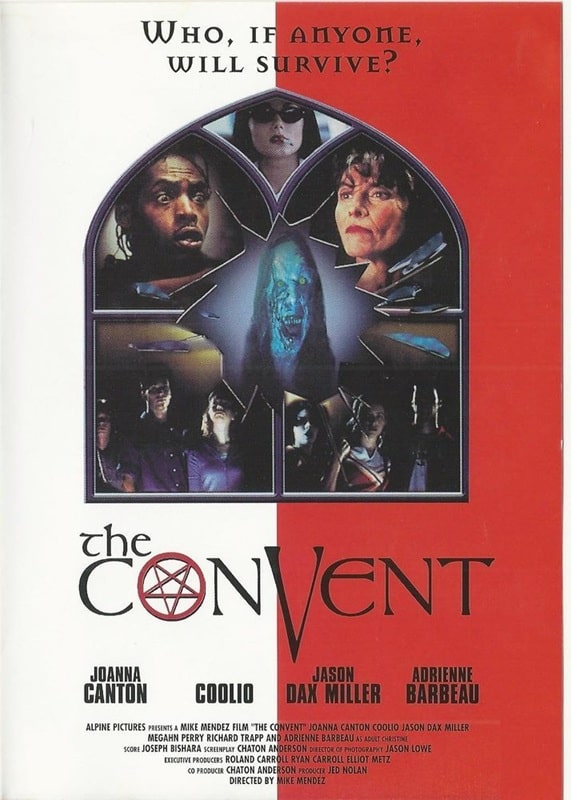

The Convent (Alpine Pictures, January 22, 2000)
and Late Night with the Devil (IFC Films/Shudder, March 22, 2024)
Some nuns and a priest are fussing around an alter when suddenly a cool-looking chick bursts in and starts whaling on them with a baseball bat, before finishing them off with a shotgun.
Okay movie, you have my attention.
Unfortunately, the rest of the flick doesn’t live up to this intro, although it’s a fairly fun attempt to conjure up the daft delights of 80s demon films. A bunch of frat yoots are determined to break into an old, deserted convent and tag it before the other frat houses. They are also hoping to smoke some of the devil’s leaf, and perhaps partake in some heavy fondling. Unfortunately, they inadvertently awaken the spirits of unholy nuns, who promptly possess them and go on a rampage. It’s up to the original nun-knocker from 20 years ago, Adrienne Barbeau, to go all Terminator 2 on the holy horrors.
It’s very silly, occasionally messy, and mostly neon, as the demons were all shot under UV lights.
Megahn Perry was a highlight as Mo, a goth who totally looks like a 19-yr-old Olivia Colman in black lipstick. She was good, as was a Bill Mosely cameo, and Coolio acting ‘extremely’ normal.
It’s not brilliant, but it’s not awful either.
6/10
Late Night with the Devil (2024) – Prime (Shudder)Let’s get the drama out of the way first. Lots of folks over on Xitter claimed they were boycotting this film due to its (minimal) use of A.I. images. I appreciate their stance, however, it’s difficult as all hell to get an indie horror made these days (exhibit A: the several hundred production logos at the beginning), and boycotting this one just hurts the hundreds of other crew-members who had no hand in the decision.
Sure, go ahead and be very disappointed, but to boycott it means you won’t get to see a terrific concept nicely put together.
Current horror darling, David Dastmalchian, is perfect in the role of a late-night host who can’t quite match the ratings of the great Johnny Carson (this is set in 1977). His beloved wife has recently died, the sweeps are nigh, and he’s desperate for a decent show. Tonight’s Halloween spectacular might be the last gasp for Night Owls. Jack Delroy, along with his sidekick, Gus, have invited a half-rate psychic, a James Randi type, and the subjects of possession research, June, the researcher, and Lily, the possessed. As you might guess, it all goes horribly wrong.
The film opens with narration (Michael Ironside!) to bring us up to speed, and then presents the show in its entirety, threaded with behind the scene footage. I loved the concept and the slow build-up, and the general aesthetic was spot on. I’ve seen a lot of reviews from yoots saying it’s ‘mid’, but I think it really helps if you grew up watching the late shows of the 70s and 80s.
Recommended.
9/10
 The Exorcism of God (Saban Films, September 27, 2021)
The Exorcism of God (2021) – Tubi
The Exorcism of God (Saban Films, September 27, 2021)
The Exorcism of God (2021) – Tubi
I wasn’t expecting much from this Mexican/US production, mostly because I’d never heard of it, but it was a pleasant surprise.
The director, Alejandro Hidalgo, get all of the cliches out of the way in the first few minutes, including a totally unsubtle Exorcist shot, yellow eyes, shaky beds, psychosexual taunting, inexperienced priest, etc etc. However, this story has more to offer than the usual schtick we get in these films.
This time, the priest hides a very dark secret that stems from the initial exorcism, a secret that rears up again 18 years later when he is exalted as a ‘saint’ for saving a Mexican village. Father Peter is a really interesting, conflicted character, and I liked Will Beinbrink’s portrayal of the tortured soul very much. In fact, it’s well acted all round and beautifully shot, although it relies a bit too heavily on jump scares, which were unnecessary.
Plenty of atmosphere, lots of creepiness and a genuinely ghastly plot. Recommended.
8/10
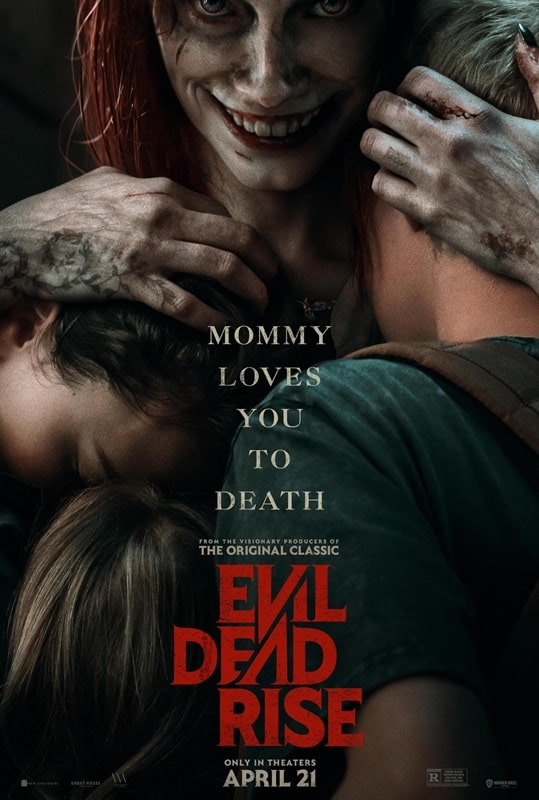

Evil Dead Rise (Warner Bros. Pictures, April 21, 2023)
and Exorcism at 60,000 Feet (Shout! Studios, August 9, 2019)
Curse me and my self-imposed rules. I wanted to watch this one last year, but I knew I was doing this possession project after the Tubi one, so I had to wait. It was worth it!
If Fede Álvarez’s Evil Dead in 2013 was the gritty embodiment of Raimi’s original, then this follow-up, written and directed by Lee Cronin, is a pitch-perfect take on the sensibilities of Evil Dead II. You can tell that Raimi, Tapert and Campbell were part of the production, because even though Rises is darker and bloodier, as befits a modern version, it is struck through with subversive humour. That’s the weird thing about the Evil Dead franchise — I can’t think of another film series that I gleefully watch as it inflicts so much ghastliness on decent people . It’s somewhat perverse.
The theme and storyline, with its focus on family, is quite disturbing, and yet there are several sequences that had me silently whooping; the carnage watched through a peephole, finding the right pot size to put a deadite down, and an eyeball gag straight out of the Raimi playbook. Once all the possessed are chanting ‘dead by dawn!’ and souls are threatened with a good swallowing, you know that the good old days are back.
That’s not to take anything away away from Cronin. I think he’s done a stellar job here; its a well-crafted story and it looks great. The stand-out for me was Lily Sullivan, and I would totally watch the hell out of an Evil Dead series featuring her chainsaw-toting Beth.
Brilliant stuff.
10/10
Exorcism at 60,000 Feet (2019) – TubiA priest (Father Romero), played very well by Robert Miano, turns up at a house, poses à la The Exorcist at the front door, barges in and shoots a demon in the head (Bill Mosely, shaggy as ever) with a crucifix gun. So far, so good. The homeowner snaps out of his own demonic possession, sees his dead wife and screams in anguish. Then he wanders off into the shadows, looking for the rest of his family, crying ‘Oh God’ every time he finds one, his voice getting more horrified with each new discovery.
Utterly disturbing and heartbreaking, and yet it is played for the darkest of laughs, and God help me, I smiled. Then, as the priest manhandles the demon’s body into the back of a hearse, Richard Band kicks in with one of his patented sound-alike scores, and blow me down if it isn’t the music from Airplane! So this is where we are going.
What follows is a uniquely offensive exercise in attempted Zucker Brothers style comedy on a trans-pacific flight (via Viet Kong, no less) with some demonic gore thrown in. For the most part, the over-the-top comedy doesn’t work (I wish they had stuck to the blacker than pitch humor of the opening), but the ludicrousness belts along lickety-split, and there are definitely a couple of moments that made me chortle.
Here’s a list of the crew and passengers just in case you think they missed out on an opportunity to upset anyone.
- Captain Houdee (aha!) the alcoholic pilot played by Lance Henrikson made up as Sully,
- Kevin J. O’Conner (who I’ve missed terribly) as the dozing co-pilot,
- Bai Ling (The Crow) and Matthew Moy (2 Broke Girls) as the racially stereotyped flight crew (Ling’s character is transsexual to boot, which wasn’t handled as badly as you might expect, but still the butt of a few jokes),
- A woman who has a golden glow emanating from her hoohah like Marsellus Wallace’s briefcase,
- An adult dwarf with Tourette’s who breastfeeds off Kelly Maroney (Night of the Comet),
- A Hasidic Jew played by Robert Rhine (one of the writers),
- A body builder,
- A pregnant woman,
- A guy who takes advantage of the pregnant woman while she is unconscious (really?),
- Adrienne Barbeau with a dead service dog,
- A deaf and mute guy who does nothing,
- A pair of nuns who get naked and then get it on,
- A Sopranos extra,
- A Tibetan holy man,
- A messy mile high club attempt,
- tampon gags,
- fart gags,
- and Bai Ling caked in makeup being told to crank it up to 26 and scream every line.
There’s also pea soup, Twilight Zone references and plenty of gore.
It would be easy to dismiss this one, but I think it’s perfect for the very very drunk or very very stoned, or for those with no moral hang-ups, and at the risk of eternal damnation, I’m going to recommend it just to you. You know who you are.
6/10
Previous Murkey Movie surveys from Neil Baker include:
What Possessed You? — Part 1
Fan of the Cave Bear
There, Wolves
What a Croc
Prehistrionics
Jumping the Shark
Alien Overlords
Biggus Footus
I Like Big Bugs and I Cannot Lie
The Weird, Weird West
Warrior Women Watch-a-thon
Neil Baker’s last article for us was Part I of What Possessed You? Neil spends his days watching dodgy movies, most of them terrible, in the hope that you might be inspired to watch them too. He is often asked why he doesn’t watch ‘proper’ films, and he honestly doesn’t have a good answer. He is an author, illustrator, outdoor educator and owner of April Moon Books (AprilMoonBooks.com).
Tor Doubles: An Overview
 Tor Doubles
Tor Doubles
In October of 1988, Tor Books released the first Tor Double, a volume that reprinted Arthur C. Clarke’s 1971 novella Meeting with Medusa with Kim Stanley Robinson’s novella Green Mars. Over the next thirty-five months, they would publish a total of thirty-six books in the series.
In general, there was little to link the two short stories that were published in each volume, although in 1990, Tor experimented with the publication of four Tor Doubles that included a classic story, by authors including C.L. Moore, L. Sprague de Camp, Leigh Brackett, and Roger Zelazny, with original stories that were set in the same world. The following year would see addition original stories published in the series.
Similarly, most of the volumes contained stories by two different authors, however four of the books published in 1991 were single author collections, with two stories each by Gordon R. Dickson, Mike Resnick, Damon Knight, and Fritz Leiber.
Modeled after the Ace Doubles series, the books were initially published in a dos-a-dos format, with each story getting its own cover and bound upside down in relation to the other book, so neither story was first (although the presence of an ISBN code on one side had a tendency to make it feel like the “back” of the book). The four volumes that included sequels were published with a single cover and beginning with volume 27, which included Orson Scott Card’s Eye for Eye and Lloyd Biggle, Jr.’s The Tunesmith, all the volumes were published in the more traditional format.
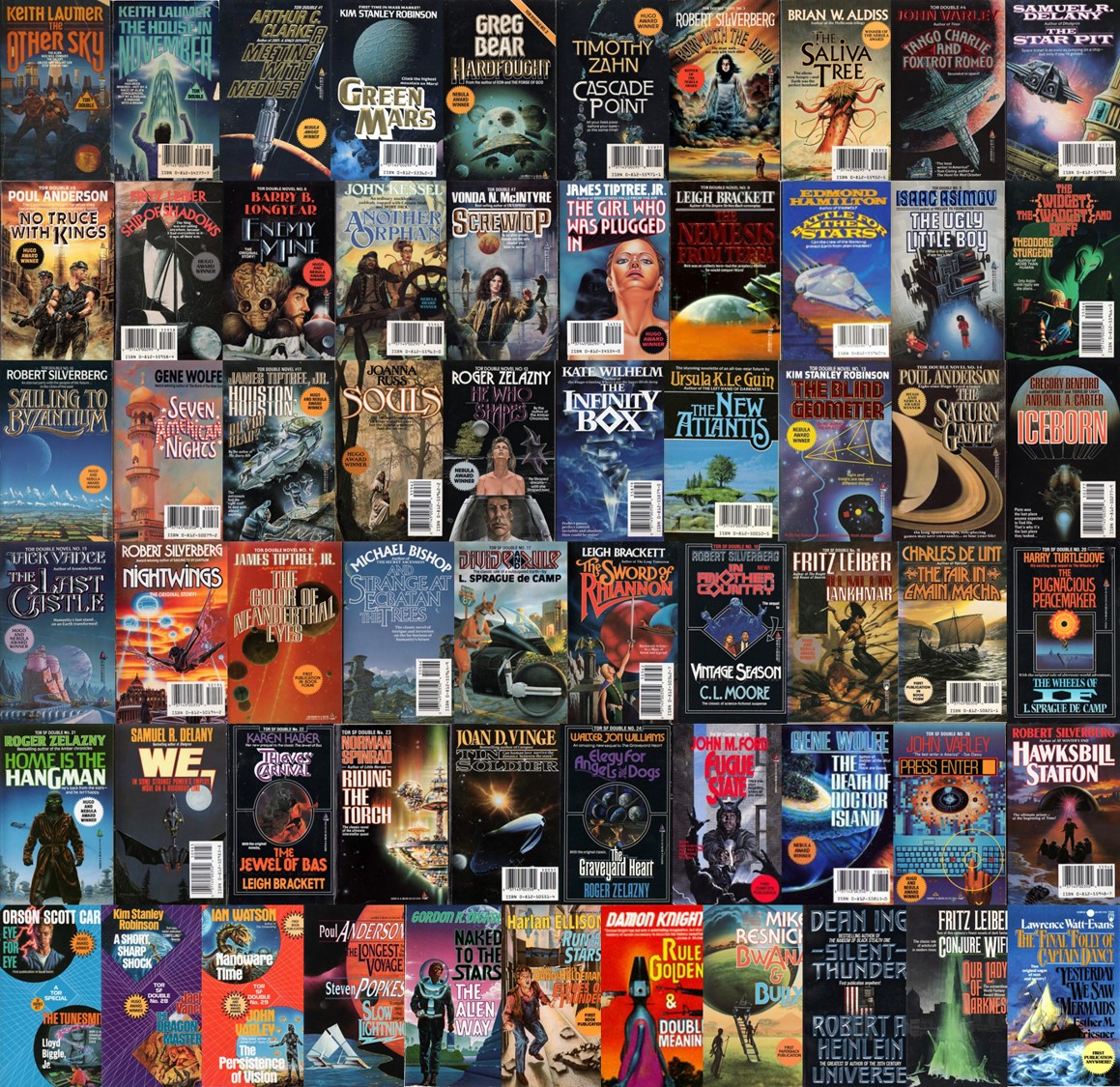 A Mosaic of Tor Doubles covers
A Mosaic of Tor Doubles covers
The Clarke/Robinson volume was not, actually the first Tor Double, although it states “Tor Double #1” on the cover for the Clarke story. In 1981, Tor published Keith Laumer’s novel The House in November with a “special bonus: complete short novel” The Other Sky as part of their “Jim Baen Presents” series When the book was reprinted in 1985, the two stories were printed in the dos-a-dos format with the words “Tor Double” appearing on both sides.
Although the final volume in the series, a collection of Fritz Leiber’s novels Conjure Wife and Our Lady of Darkness was published in August of 1991, there was at least one more volume scheduled to see print, although it was never published. Instead, Esther M. Friesner’s Yesterday, We Saw Mermaids was published as a stand-alone novel by Tor in 1992 and Lawrence Watt-Evans’ The Final Folly of Captain Dancy was first published by Tor at the back of their printing of his novel The Rebirth of Wonder (along with an excerpt for Watt-Evans and Friesner’s collaboration Split Heirs) and was later included in his collection Crosstime Traffic.
The series includes works by 51 authors (including two collaborations). Sixteen authors are represented by multiple stories, with eight appearing twice (half of those in single author volumes), six appearing three times, Fritz Leiber having four stories in the series (once in a single author volume), and Robert Silverberg having five stories.
Although there were only a handful of original stories published in the Tor Doubles series, many of the works selected to be reprinted were award nominees and winners. The series included 33 Hugo nominated works and 17 winners and 27 Nebula nominated stories and 16 winners. Robinson’s A Short Sharp Shock was nominated for a Hugo Award for the year it appeared in the series, although it had previously been published by Mark V. Zeising and Asimov’s.
Over the next thirty-nine weeks, I intend to look at the books published (or not published, as the case may be) as part of this series.
 Steven H Silver is a twenty-time Hugo Award nominee and was the publisher of the Hugo-nominated fanzine Argentus as well as the editor and publisher of ISFiC Press for eight years. He has also edited books for DAW, NESFA Press, and ZNB. His most recent anthology is Alternate Peace and his novel After Hastings was published in 2020. Steven has chaired the first Midwest Construction, Windycon three times, and the SFWA Nebula Conference numerous times. He was programming chair for Chicon 2000 and Vice Chair of Chicon 7.
Steven H Silver is a twenty-time Hugo Award nominee and was the publisher of the Hugo-nominated fanzine Argentus as well as the editor and publisher of ISFiC Press for eight years. He has also edited books for DAW, NESFA Press, and ZNB. His most recent anthology is Alternate Peace and his novel After Hastings was published in 2020. Steven has chaired the first Midwest Construction, Windycon three times, and the SFWA Nebula Conference numerous times. He was programming chair for Chicon 2000 and Vice Chair of Chicon 7.
Goth Chick News: The Night We Podded Out
 They Mostly Pod Out at Night, Mostly, hosted by Graveyard and Salem
They Mostly Pod Out at Night, Mostly, hosted by Graveyard and Salem
One of the best parts of my Black Gate side hustle is the cool people we get to meet, and there’s nothing more exciting than connecting with those who are most definitely “our people.” I am embarrassed to admit that the Fall Days of the Dead show in Chicago last November was my first encounter with the geniuses behind the podcast They Mostly Pod Out at Night, Mostly, who go by the monikers Graveyard and Salem. And after all, who doesn’t love an Aliens reference?
They Mostly Pod Out at Night, Mostly is a weekly podcast dedicated to all things horror. Each episode features in-depth discussions, covering a range of topics from classic and contemporary horror films to broader themes within the genre. The hosts provide insightful analysis, engaging reviews, and lively conversations that appeal to both casual viewers and die-hard horror enthusiasts. Their passion for horror is on full display as they explore the intricacies of various movies, offering listeners a comprehensive understanding of the genre’s evolution and impact.
Since meeting them in November I’ve become a regular listener, discovering yet another dark and intriguing corner of the horror subculture, and last night I had the honor of being a guest.
Honestly, I had mixed feelings about doing this. Though I loved what I had seen since becoming a fan of TMPOaNM, I am far more comfortable behind the keyboard than in front of a webcam. I have my own horrors of freezing up or saying something stupid, not to mention the fact that for all my many years at Black Gate I have determinedly remained out of any pictures or videos associated with Goth Chick News.
Still, the draw was strong, and the host “Graveyard” (aka Matt Van Bodegraven) went to great lengths to make me feel comfortable. He had done his homework on Black Gate and Goth Chick News so the whole event really felt like “coffee between friends” as he promised.
Check it…
For his part, Van Bodegraven is a multifaceted figure in the indie horror genre, recognized for his work as a writer, director, actor, as well as podcast creator and co-host. In the realm of filmmaking, Van Bodegraven has contributed to several projects. He is known for The Murder of the Monster (2024), The Ruck March (2025) as well as Vampyre and Tahoe Joe 3: Concrete Wilderness both in pre-production.
He is also the producer of the upcoming ‘found footage’ horror film The Fairfield County Four, directed and written by Joshua Brucker for Horror Dadz Productions.
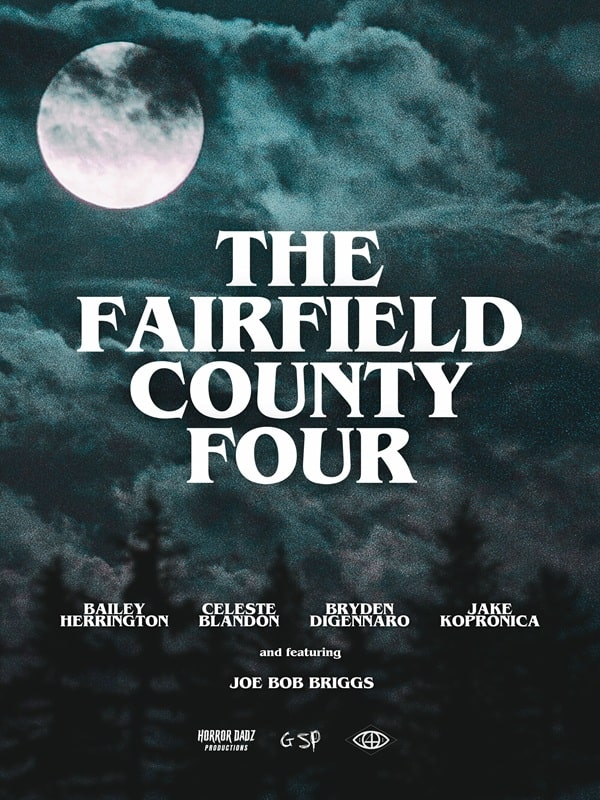 The Fairfield County Four (Eye4Eye Productions/Gray Sky Pictures)
The Fairfield County Four (Eye4Eye Productions/Gray Sky Pictures)
The narrative follows four individuals — Emma Grove, Amy Hanson, Randy Farris, and Peter Moore — as they venture into the Connecticut woods to investigate the legend of the Wolf of Fairfield County. Their subsequent disappearance leads to the discovery of their recovered footage, unveiling the chilling events they encountered.
As of now, The Fairfield County Four is in pre-production, with filming anticipated to commence in April 2025 and a release date yet to be announced. However, Van Bodegraven did promise to keep me updated so I can tell you all about the process of bringing an indie film to life. For a glimpse into the eerie atmosphere, you can watch the campaign teaser below:
While we wait, definitely check out They Mostly Pod Out at Night, Mostly, for entertaining insights into the horror genre. A huge thank you to Graveyard and Salem for creating such a memorable experience, and one that is truly unique in the Goth Chick universe.
Black Gate photog Chris Z and I are off to the spring version of Days of the Dead on Friday, so watch this space.
You Are Cordially Invited to a Dinner Party in Hell: The Exterminating Angel
Social interaction is a minefield, isn’t it? Whether it’s gathering with the family for the holidays, relating to people at the workplace, or making small talk with the checker at the supermarket, any encounter with other people, no matter how casual or seemingly benign, is fraught with uncertainty and even, sometimes, menace. That may be why such interactions have so often been depicted as a form of combat. (It may also be why the trend towards “contactless” social transactions that reached warp speed with the advent of COVID isn’t going anywhere, but just continues to gain ground even as the Coronavirus era recedes.)
Of all the opportunities for social victory and defeat, triumph and humiliation, the party may be the most hazardous, but no party has ever been such an ordeal as the one endured by the hapless dinner guests in Luis Buñuel’s merciless 1962 nightmare, The Exterminating Angel (in its original Spanish, El ángel exterminador).
Filmed in Mexico and set in a “wealthy district” in an unnamed country (Roger Ebert declares that it’s Spain and that the movie is an attack on the regime of Francisco Franco, but I know of no statement by Buñuel that places the film so specifically or that defines its meaning so narrowly), The Exterminating Angel is the blackest of black comedies; I have no doubt that it would have made the chap who invented the rack and thumbscrews giggle uncontrollably.
Buñuel was one of the original cinematic surrealists, beginning his career in the mid 1920’s and earning his first fame — or notoriety — with two films made in collaboration with Salvador Dalí: that bane of unsuspecting college film students, Un Chien Andalou (1929), with its sudden, shock shot of an eye being sliced open by a razor blade (it was actually a cow’s eye) and 1930’s L’Age d’Or, which provoked scandal and rioting with its unbridled attacks on the Catholic Church.
Buñuel spent the next three decades bouncing between his native Spain, the United States, Mexico, and France, all the while producing work that was unconventional, to say the least. This period culminated with The Exterminating Angel, a film which inaugurated his final and greatest phase, a period which saw him produce his subversive masterpieces Belle de Jour, The Discreet Charm of the Bourgeoisie, The Phantom of Liberty, and That Obscure Object of Desire.
The Exterminating Angel opens on a beautiful and tranquil night on the Calle de la Providencia, an elegant, upper-class street, as Edmundo Nóbile (Enrique Rambal) and his wife Lucia (Lucy Gallardo) return from an evening at the opera, bringing with them seventeen guests, artists and professional people whom they have invited to join them for a post-performance dinner party. As the gay and sparkling group walks in the luxurious mansion’s front door, the Nóbile’s large domestic staff is rushing out the back; spurred by some obscure impulse that they scarcely understand, cooks, maids, and servers all flee into the night with no intention of ever returning.
Soon the only ones left are several sheep and a bear that the hostess is planning to use for some strange and never-to-be-enacted entertainment, and the Nóbile’s butler, Julio (Claudio Brook), whose total identification with his employers apparently inoculates him against the “running sickness” that is affecting the other servants.
The festivities begin in the time-honored way — the guests sit around the huge table, and oozing well-mannered malice, lean toward their neighbors and cheerfully gossip about the other people at the party, the sexual proclivities and perversions of their “friends” being an especially popular topic. (Other people’s medical conditions are also freely discussed, and an army colonel casually confides to the woman next to him that he doesn’t give a damn about the Fatherland he ostensibly serves.)
After Julio has served the meal, the group repairs to the spacious drawing room, which is only separated from the dining room by an open archway (which looks suspiciously like a theater proscenium), where one of the guests entertains everyone by playing a classical piano piece. More socializing ensues, masks of politesse and good breeding barely concealing the contempt and jealousy that lie beneath. (More than the usual spite and backbiting are hiding behind the polished social surface, however; during the piano recital, a woman opens her purse and has to dig beneath its other contents to reach her handkerchief. What has this elegant society lady brought with her? Lipstick and a compact? No, the feathers and feet of a chicken, the elements of a Cabbalistic ritual.) Finally, as the hour grows late, the partygoers begin to gather coats and purses, in preparation for their leave-taking. Only…
No one leaves. A few people hesitantly walk up to the archway leading to the dining room, which they must pass through in order to reach the cavernous entry hall and the front door, but they pause at the threshold, seemingly unable to take a step further. They stand bemused, expressions of confusion and even fear flickering across their faces, like skydivers at the door of an airplane who suddenly realize that they’re not wearing parachutes (or people standing at the brink of “The undiscovered country from whose bourn / No traveler returns”, perhaps?) They mutter a few weak justifications for staying just a little longer, and retreat back into the drawing room.
It soon becomes obvious that no one is going to leave, as people settle down for the night on couches (the lucky ones), in chairs, or on the floor. At first, the Nóbiles are outraged at this shocking breach of etiquette, but when they realize that they too are powerless to walk out of the drawing room, they find their own places to bed down for the night.
In the morning, Julio wheels in a tray with some breakfast… and finds that he too cannot leave the drawing room, and the new day has brought no change for anyone else, either — no one can leave. The group fumblingly tries to figure out what is happening; almost as frustrating as their inability to leave the room is their inability to understand why they cannot leave the room. Dr. Carlos Conde (Augusto Benedicio), the party’s leading rationalist, counsels that only “dispassionate analysis” can solve the problem, but no one seems much interested in that approach, not that there’s any indication that it would work if they tried it. In the meantime, people are making what arrangements they can — a closet in which large ornamental vases are stored becomes the de facto bathroom, and a pair of young lovers finds another closet where they can be alone; Buñuel allows you to imagine for yourself exactly what they’re up to in there.
As the days pass, territory is staked out, accusations are made and recriminations are hurled, and hunger grows. The lower-class Julio takes to eating paper as he did when a schoolboy and recommends it to the others; it’s better than nothing. An ornamental axe is used to chop through the wall to get to a water pipe; anarchy briefly reigns when water spurts from the pipe, but order is quickly restored — ladies first.
As the prisoners wonder why no one has come to rescue them, we are able to see outside the mansion, where police and crowds of onlookers have gathered, powerless; the same strange force that prevents exit also prevents entrance.
Inside, some react with hysteria, some with lethargy; some fight to maintain hope, some give way to despair. Some people cling to rationality while others call on occult powers, seek help through Masonic rituals, or promise a special mass for their deliverance. All the while, death is a force to be reckoned with inside the house just as it on the outside; lacking his medication, one of the older guests who was in poor health dies after the first night. (Just before the end, he mutters, “I’m happy I won’t see the extermination.”) They put him in the lovers’ closet, which is only fitting, as the pair — who were to be married later in the week — eventually commit suicide together in their trysting place.
An overpowering stench from the improvised lavatory (and morgue) and sweaty, unwashed bodies soon makes the air in the crowded room fetid and foul, and though they can toss their trash into the dining room (despite not being able to enter it), after a few days the drawing room is a filthy, cluttered shambles. Under these conditions, the thin veneer of civilization flakes off as people grate against each other physically and emotionally. Insults and fists fly, and the last tattered remnants of civility begin to disintegrate.
When the erstwhile members of the upper crust are approaching the last extremity, starvation is fended off when the animals escape from the kitchen. While the bear roams the upper floors, emitting eerie moans and cries, the sheep providentially trot into the drawing room; whatever sardonic divinity presides over this hell, he is at least willing to provide manna for his erring children. A fire is made from smashed furniture and soon roast mutton is being devoured by people indistinguishable from their primitive ancestors, who also squatted around open fires, eagerly tearing meat off of bones with their teeth.
Full stomachs only sharpen the edge of the guests’ desire to escape their prison, however, and a group of women (among them the devotee of Kabbalah) begin to push the idea that only a sacrifice — a human one — will free them. Who should the victim be? Who better than their host, the man who got them all into this mess with his impertinent dinner party invitation, Edmundo Nóbile? (Who, it must be said, has lived up to his name by comporting himself with more dignity and self-control than almost anyone else.) Some oppose this move, the ever-reasonable doctor most prominent among them (for his pains, someone shouts that they should get rid of him too) and the two sides, those for human sacrifice and those against it, wind up wrestling in the middle of the ruined room.
Just as the pro-sacrifice faction seems to be getting the upper hand and someone is reaching for the same knife that was used on the sheep, Nóbile tells them all that it won’t be necessary — taking a pistol from a drawer, he says that he can easily solve their problem for them. But before he can use the gun on himself, one of the women, Leticia (the wonderful Silvia Pinal, a Buñuel regular) tells everyone to stop where they are — she has realized that are all in the exact same places they occupied when the nightmare began, countless ages ago. If everything is repeated — positions, music, words, gestures, might that not free them from this spell? (Buñuel has slyly prepared for this by repeating several shots in the film; for instance, the shot of the guests first entering the house, along with the accompanying dialogue, is shown twice in succession. The only difference is a slightly different camera angle. Buñuel claimed that there are about twenty of these repetitions in the film.)
Everyone (except the dead) exactly repositions themselves as they were that unlucky night. The last few bars of the piano piece are played, followed by the same words that were spoken, and the doors of the sorcerer’s castle (“after all, this is not a sorcerer’s castle” someone rashly declared after the first night) are miraculously unlocked, and the captives are free. They immediately sense that whatever was restraining them has disappeared, and they ecstatically rush out the front door to meet the people waiting outside, who are also now freed to run to meet them. (Even the servants are there, seemingly drawn back by the same force that impelled them to run away.)
The curse has been lifted and the evil dream can fade from memory as all dreams do.
Well, if you think that, you don’t know Luis Buñuel. Of course, this deliverance is illusory; the torture master has withdrawn the knife only to reinsert it, merely repositioning the blade for the final, fatal twist.
The last scene of The Exterminating Angel shows all the dinner guests, again clean and fresh, immaculately groomed and expensively dressed, gathered together in church along with hundreds of other worshippers, attending the special mass that they promised to celebrate if they were saved from their ordeal.
As the service ends and the bells toll, the priests start to walk out of the nave… and stop.
They cannot leave, and neither can anyone else; they all stand paralyzed, new captives and old alike unable to walk through the door in front of them, and not long afterward, as panic mounts inside the church, shouts are heard from the outside, where mounted police are clashing with a large crowd. Rioters or the merely curious? Does it matter? The disorder and chaos that leaked from the human heart into an elegant upper-class drawing room has now overflowed into the wider world, spreading through the streets like a plague.
But have no fear; the degraded human race, corrupt and corrupting, will be looked after. The final shot of this extraordinary film shows a large flock of sheep, placidly trotting through the doors of the church while the city outside echoes with screams and gunfire. FIN.
The Exterminating Angel is one of the greatest films ever made, bursting with resonant, unforgettably suggestive images — a bear climbing the pillar of a chandeliered hall, crying with what sounds like anguish; sheep roaming up the wide stairways and through the deserted rooms of a richly-appointed mansion; ragged people listlessly standing around in the shattered ruins of what was once an elegant drawing room, hopeless as damned souls in hell; Nóbile and Leticia sitting with a sheep between them — as Leticia blindfolds the animal and hands Nóbile a knife, the doomed creature tenderly lays its head on its executioner’s shoulder. (Buñuel later said he wished that he had left the animals out of the film, because then he would have been able to make his people resort to cannibalism. Fun guy, that Luis.) Though there are a few other works it brings to mind (Jean-Paul Sartre’s play No Exit, which came before the film, and J.G. Ballard’s novel High Rise and Jean–Luc Godard’s film Weekend, which came after) The Exterminating Angel is very much its own thing, a bracingly original achievement, a ticking time bomb placed under the padded chairs of the complacent.
What is the meaning of this savage allegory? Does it say that hypocrisy and malice constitute the irreducible baselines of human behavior? That the comfort and luxury that we almost all desire are nothing but degrading prisons? That life is defined by its frustrations? (Later, in The Discreet Charm of the Bourgeoisie, Buñuel plays a variation on the impediment faced in the earlier film; in Discreet Charm the people of the privileged class can go where they want, but every time they sit down to dinner, something prevents them from eating; they are never allowed to complete a meal.) Does it say that the world is nothing but a desert island where we are all shipwrecked? (In 1954, Buñuel had filmed his own version of Robinson Crusoe.) Is it about the loss of belief that can suddenly undermine the most powerful regime? (Buñuel didn’t live to see the Soviet Union collapse overnight, but if he had, I can’t imagine that he would have been very surprised.) Is it a parody of the Book of Exodus? (When the Destroying Angel passed over Egypt, the Children of Israel couldn’t leave their houses.) Is it a monument to misanthropy, a horror movie in which the monsters are other people?
Hell, maybe if you could have administered a truth serum to the cagey Spaniard, he would have told you that the movie isn’t about the people at all — it’s about the sheep.
All respect to Roger Ebert, but whatever this singular film is, it has to be more than just a declaration that under Francisco Franco, Spain was oppressed by a corrupt and evil government. We know that already, and having grasped that fact, there’s nothing more to add. But The Exterminating Angel is deep enough to convey that specific meaning and many, many more. Like all the greatest works of art, it’s almost limitlessly expansive; it contains more and means more every time you see it. (Watching in 2025, it’s hard not to attach a meaning to it that it couldn’t have had for its director or original audience in 1962; the film works perfectly as an allegory of the anxiety and isolation of the COVID era.)
In watching this eccentric masterpiece, you may find yourself appalled, shocked into bitter laughter, filled with pity and dismay at the irremediably tainted human race and its benighted condition. What you won’t be is bored or dismissive; you’ll have no doubt that you’ve seen something absolutely unique and uncomfortably pertinent to the human dilemma, and you’ll find yourself turning it over and over in your mind long after the final credits have rolled, looking for a way out.
Really, what more could we poor, stupid sheep ask for?
Thomas Parker is a native Southern Californian and a lifelong science fiction, fantasy, and mystery fan. When not corrupting the next generation as a fourth grade teacher, he collects Roger Corman movies, Silver Age comic books, Ace doubles, and despairing looks from his wife. His last article for us was The Beating Heart of Science Fiction: Poul Anderson and Tau Zero
Books.by – A Viable Amazon Alternative?
 Image by Gaertringen from Pixabay
Image by Gaertringen from Pixabay
Good afterevenmorn!
Let’s talk self-publishing. Particularly, print on demand options.
In this particular climate, I know a number of book buyers and independent and self publishers looking to make an impact by being more mindful of where they spend their money and with whom they do business. It is, however, incredibly difficult to do any kind of individual action, given the absolute chokehold Amazon has in the book space. Those of us who are self-published know it well. Amazon is where most book buyers go when shopping online. And it’s where a large number of independent publishers go to have their books printed and shipped. Print on demand is a great technology, especially for those of us who do not have the funds to do an entire print run, and no space to store the books in any case.
It’s perfect, too, because no book is wasted. Only the exact number of books sold are printed. There is no pulping of piles of unsold books. Paper is not wasted. I really like print on demand for that reason alone.
There are, of course, many other print on demand options. Nowhere is it written that one must use Kindle Direct (the print on demand arm of Amazon). However, Amazon has been such a behemoth for so long, it does seem like that if one has any hope of making a living from their self-publishing efforts, you must be on Amazon. Plenty of self-published writers make a very decent living on there, thank you very much.
 Image by Gerald Friedrich from Pixabay
Image by Gerald Friedrich from Pixabay
However, I, like many others (both buyers and publishers) do not like the way Amazon operates. We don’t like the way they treat their employees. We don’t like the way they treat their authors. We don’t like how they bully the little guy. Or what they do with the money we make for them. It has had me searching for alternatives for a long while now.
Draft2Digital is one. It operates the usual way; you upload the book and cover, decide which channels you wish to sell on, and Draft2Digital will print and ship off your books to all those markets. You can order author copies should you ever need a bunch for an event.They operate as both a printer and distributor, which is quite nice. They pay for this by taking a cut of the proceeds of each sale, in much the same way Amazon, and other options do.
Lulu and Ingram Sparks are a couple of others that are names with recognition. But there are a bunch of print on demand services. They all operate in more or less the same way. As a bonus, there aren’t any issues with the manner in which they treat their workers, near as I know. So they’re not a bad option if you’re looking for a print on demand option.
 Image by Dmitriy from Pixabay
Image by Dmitriy from Pixabay
Recently, I’ve seen another player jump on the scene. This is a new print on demand option that operates a little differently. Books.by is a print on demand service and online shopfront that works on a subscription model. Essentially, the author/publisher pays a yearly fee, and they get print on demand services as well as a shopfront for their physical books.
If used as the author’s online store, it could help in reducing website costs, which can get quite costly. Books.by has printers on practically every continent, making printing and shipping very quick and very easy. The website also boasts marketing tools available to booksellers, though I haven’t yet explored those and so don’t know if there’s the value in them the site claims.
The store fronts look nice and clean. It’s very easy to set up; extremely user friendly on the backend. Added bonus for some of us, the company, like myself, is Australian.
There are some pretty significant drawbacks, however. The first and most immediate is upfront costs. Part of the attraction of Amazon, Draft2Digital, Lulu, Ingram Spark and others is that you don’t require any money upfront. You can just upload the files and start selling. Sure, they tend to take a hefty cut, but the barrier to entry is incredibly low. With books.by, you must have the money upfront, and pay it yearly. However, the amount does not change. It’s not a percentage of your sales. It’s a flat fee (plus printing costs). The author gets to keep 100% of the profits. That can be very attractive; especially for those writers who sell at volume. Still, it’s very rare for anyone to be able to sell those kinds of numbers, especially if one is just starting out.
This may be something a publisher is willing to factor into the cost of doing business, and in the hopes that they grow large enough on the platform to justify that fee.
It will have to be noted that, as of the writing of this, books.by does not offer digital downloads. Less expensive to purchase, digital books are a great way for new readers to discover a new favorite author. The cost isn’t high, comparatively, making it an attractive option for buyers. It would be a really nice feature if they would offer downloads in multiple formats for buyers for those publishers who wish to offer them.
Perhaps that’s a feature that’s in the works for later. The company is relatively new, after all.
Discoverability is also a problem. Each subscriber gets a dedicated shopfront (with a pretty clever URL, actually: books.by/[publisher name]). But there isn’t really a buyer-facing site at all. Which means that someone can’t come to books.by and do a search for a title, author or publisher they way they can with Amazon. People coming to shop at books.by must have the publishers URL, or they’re just out of luck. Alas.
It is my hope that books.by will add that kind of front-end search function in the future so they can better compete with sites like Amazon. As of now, however, this is a considerable failing in my opinion.
 Image by Jose Antonio Alba from Pixabay
Image by Jose Antonio Alba from Pixabay
Do I have a books.by shop? I do! There is only one book on it at the moment, as I’m going through my back catalogue and updating the books before releasing them under my new-ish imprint. Of course, because I’m such an unknown outside of family and friends, I have sold all of one copy; nowhere near the volume required to justify the expense. I am one of those who is running at a loss, hoping that sales pick up enough eventually to justify the cost.
For all of my physical copies, I’ll be using books.by, as they’re a great alternative to Amazon, and I want to be more ethical about where I’m spending my money.
But I’m not one to put all of my eggs in one basket. I also use Draft2Digital for most of my distribution needs, and, yes, my books are still up on Amazon, available through KDP (one of the business practices I detest is the sneaky way Amazon tends to throttle sales that are distributed to them from another provider). Some people haven’t a choice and must use that market. I don’t want to deprive them of their options. I will, however, be directing people to buy from my ko-fi shop or my books.by shop when they can.
It’s not much. I’m just one writer/publisher. Amazon won’t miss my business, I’m sure. Particularly since I hardly sell at all. What I do won’t really matter. Still, it’s better than nothing, and I’m enjoying having options.
I would suggest for new self-publishers to (always) do their research and choose a platform that best suits your and your situation. It might not be the best idea to jump into books.by when you’re first starting out; not least of all because of those upfront costs and lack of discoverability. That might be something to consider more when thinking of opening your own online store… and even then, consider the lack of ebook options (which will hopefully change).
I do think books.by has potential, but they’re too young a company yet to put all one’s stock into.
Are there any new and excited self-publishing options out there that you’ve heard of? I’m sure folks at the start of their journey would love to hear about it. Sound off below!
When S.M. Carrière isn’t brutally killing your favorite characters, she spends her time teaching martial arts, live streaming video games, and cuddling her cat. In other words, she spends her time teaching others to kill, streaming her digital kills, and a cuddling furry murderer. Her most recent titles include Daughters of Britain, Skylark and Human. Her serial The New Haven Incident is free and goes up every Friday on her blog.
Nero Wolfe’s Brownstone – 3 Good Reasons: ‘Black Orchids’
 What flummery is this? I have not written about Nero Wolfe since last Summer? There has not been a 3 Good Reasons in four years? What kind of mystery blogger is this Bryne fellow? Most unsatisfactory. So…
What flummery is this? I have not written about Nero Wolfe since last Summer? There has not been a 3 Good Reasons in four years? What kind of mystery blogger is this Bryne fellow? Most unsatisfactory. So…
Welcome to another installment of 3 Good Reasons. With a goal of eventually tackling every tale of the Corpus, I’ll give three reasons why the particular story at hand is the best Nero Wolfe of them all. Since I’m writing over seventy ‘Best Story’ essays, the point isn’t actually to pick one – just to point out some of what is good in every adventure featuring Wolfe and Archie. And I’ll toss in one reason it’s not the best story. Now – These essays will contain SPOILERS. You have been warned!
The StoryToday’s story is “Black Orchids,” it’s the first of two in a collection of the same name. Lewis Hewitt has three unique black orchids on display at the annual NYC Flower Show. Wolfe’s envy rivals his desire for Millard Bynoe’s flamingo-colored Vanda in “Easter Parade.”
Wolfe orders Archie to scout the enclosed-in-a-case black orchids, over multiple days. It’s not surprising that Archie is smitten by Anne Tracy; a young woman working in a display at the show. Naturally, he finds a murdered body, which is right out in plain sight. Wolfe spends part of this story ‘in the wild,’ as his covetousness leads him to the show.
3 GOOD REASONSONE – The Green-Eyed Monster
Nero Wolfe is not a person who can enjoy someone else’s success – certainly not in the orchid-growing world. He reaches one of his low points in “Easter Parade,” when he has Archie hire someone to steal an orchid right off of a woman’s chest, in public. That’s a pretty slimy thing to do.
But his envy of Lewis Hewitt is something to enjoy in this story. Hewitt appears in three cases, and is mentioned in more than double that. He makes his Corpus debut here. ‘Friends’ is not a word often used with Wolfe. If you take away work associates (like Inspector Cramer) and employees, it’s a very small circle. As the Corpus goes on, I think Hewitt does become a friend. Wolfe uses him to aid him on a case. He respects Hewitt’s flower-growing skills, going to great length to hire a
“I knew that the sound of that name would churn his beer for him. Lewis Hewitt was the millionaire in whose greenhouse in whose Long Island estate the black orchids had been produced. Thereby creating an agony of envy in him that surpassed any of his previous childish performances.”
Wolfe stands with his face only five inches from the glass case, staring at the orchids:
“For a quarter of an hour, His emotions didn’t show, but from the twitching of a muscle in his neck, I knew he was boiling inside.”
He even let himself be bumped by women trying to get a look at them. Wolfe very much dislikes being touched by anyone.
Wolfe sucks up to Hewitt so much, Archie can’t bear to watch. He actually turns his head away to conceal his feelings.
‘He flattered him, and yessed him, and smiled at him until I expected any minute to hear him offer to dust off his shoes.’
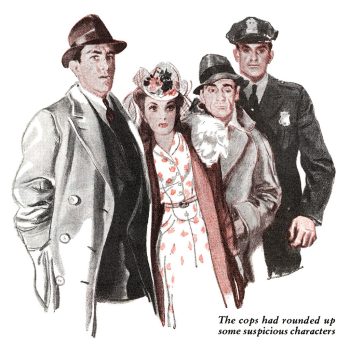 Hewitt gives Wolfe a couple lesser plants Wolfe doesn’t want, but accepts, thanking him as if they were ‘just what he asked Santa Clause for.’
Hewitt gives Wolfe a couple lesser plants Wolfe doesn’t want, but accepts, thanking him as if they were ‘just what he asked Santa Clause for.’
Wolfe carries them himself, which tells you the extremes of sucking up which he’s going to. It’s funny when later Wolfe wants to dump them on Archie, but the latter evades the task and Wolfe is stuck carrying them. Physical exertion is not an activity he enjoys.
Archie says he’d like to give Wolfe a kick in the fundament, which would be an amazing thing to see actually happen. He certainly couldn’t miss!
Hewitt misplaces his walking stick, which Archie says makes Wolfe’s best Malacca one look like a fishing pole. When it’s found, Wolfe tells Archie to pick it up for Hewitt. Archie doesn’t want to cause a scene, so he resists the urge to resign on the spot. Archie picking up the cane is germane to the story.
This just isn’t Wolfe being pleasant, hoping for the best. He is in full-blown sycophant mode. Archie rarely conveys so much disgust and derision with Wolfe. It’s usually an observation -here it’s an ongoing feeling of disgust, which he expresses openly in his narration.
‘And Wolfe following him like an orderly following a colonel, his hands full of potted plants. It would have been comical if it hadn’t been disgusting.’ Archie has to lead, rather than follow, so he doesn’t have to see it.
Archie discusses the body after this, and the story shifts gears. Wolfe goes from toady to (sort of) blackmailer, with a crime to be solved. But it’s fun reading Archie’s open disgust with Wolfe sucking up (poorly) to Hewitt, to try and secure one of the black orchids.
TWO – Archie Goads Wolfe
I really enjoy chapter one of this story. It starts with Archie recounting that Wolfe has sent him to the Flower Show the past three days, to scout out the black orchids. Returning to the office late on day three, he drops “I’m thinking of getting married.”
He talks about the woman in the display, and Wolfe reveals info he has about her, from a story in the newspaper. Archie fatuously argues her virtues with Wolfe (you know Wolfe is unengaged in this discussion), creating a non-discussion discussion.
Having started with this tactic, he elevates it by telling Wolfe that Lewis Hewitt takes her out to dinner. Archie has scored a hit. Wolfe opens his eyes and scowls (See number One).
Wolfe had said that Anne’s legs are too long (in the newspaper picture). Archie, going over the top, puts his leg foot on the desk, lifts his trouser leg up, and tells Wolfe to imagine the result of his cross-pollinating with Anne’s leg. This is silly, but it’s funny. Wolfe tells him not to scar the desk and instructs him to return for a fourth consecutive day.
However, Archie has ratcheted up Wolfe’s desire for the orchids. At lunch, he instructs Archie to get the car – he must “look at those confounded freaks myself.”
Archie had fun goading Wolfe, and he even convinced him to make a sojourn out among a crowd of flower-lovers. If you’ve read “Disguise for Murder”, you know Wolfe’s opinion of the common flower person, as opposed to serious growers like himself.
Chapter one is only six percent of the story’s length, but the reader immediately likes Archie. Wolfe isn’t despicable, like he is in chapter one of “Easter Parade.” But we can see that envy is one of his vices. I think that the best stories often have a strong first chapter. Stout engages us with Archie and Wolfe, right from the start. Of course, middles and endings matter. But I am always happen when I really like the opening chapter, and I’m ready to dive into the rest of the story. I think that the opening in “Black Orchids” shines.
THREE – What Wolfe Wants, Wolfe Gets
Now, I think Wolfe is a jerk to Hewitt in this, and I often find him to be an unlikable person. Not someone I want my son to emulate. I’d like to see Wolfe lose sometimes, based on how he acts.
But he sure knows how to get what he wants. His continual sucking up to Hewitt failed miserably. Hewitt is not going to sell him one of the orchids. He’s certainly not going to just give him one. His kowtowing so repulses Archie, that he can’t even stand to look at Wolfe.
But the moment he has leverage over Hewitt, he sticks the knife in. Hewitt abhors the publicity that he might receive if it becomes known his cane was used for the murder. He could even be a suspect. And Wolfe has him right where he wants him.
For a friend like Marko Vukcic, he would help out for free. He might just soak a normal client – his fees are high. But Hewitt has something he wants. Desperately. It’s a douche move to demand ALL three black orchids, to solve the case. One, or even two, would be more appropriate. But Wolfe is brutal and greedy. Hewitt would have none to develop more from.
Hewitt pretty much goes through the five stages of grief. Wolfe is content to toss Hewitt to Inspector Cramer (there’s no proof that Hewitt did it – it’s an image issue for the rich man). Wolfe refuses to haggle, demands all three. He even insists on taking them immediately before even working on the case.
The Corpus is replete with Wolfe holding out on the police, and using his position and skills to maximize his return. And, as in Easter Parade, being not-admirable, to get what he wants. The recipe for
As I said, I wish he had gotten his nose pushed in a few times. But in this case, he went from a completely losing position, with no standing at all, to getting what he wanted, with payment in advance. Wolfe is tough to beat, in multiple ways.
ONE BAD REASONLike a Hole in Your Head…
 This section was going to be titled ‘With Friends Like These…’ and I was going to talk about what a jerk Wolfe is to Hewitt, to get him out of potential trouble. But as I mentioned above, it’s not clear yet that the two are friends. They are fellow flower growers, and as acquaintances, they get along. But if they had been friends at this point, then Wolfe would have been a miserable one, because of the price he demanded to solve the case. Not how you treat a friend.
This section was going to be titled ‘With Friends Like These…’ and I was going to talk about what a jerk Wolfe is to Hewitt, to get him out of potential trouble. But as I mentioned above, it’s not clear yet that the two are friends. They are fellow flower growers, and as acquaintances, they get along. But if they had been friends at this point, then Wolfe would have been a miserable one, because of the price he demanded to solve the case. Not how you treat a friend.
However, since they aren’t obviously friends yet, I’ll go with Archie’s discovery of the body. It’s a short bit, but I’d NEVER do what he did. And after I did it, no way I could be so blase and low key about it. I’d quite possibly vomit on the spot.
‘On account of the shrubs and rocks, I couldn’t get around to see the top of his head. So I reached a hand to feel of it. And the end of my finger went right through into a hole in his skull. A way in. And it was like sticking your finger into a warm apple pie. I pulled away and started wiping my finger off on the grass.’
Man, I don’t even wanna eat apple pie (which I love) after reading this! I’m squeamish. I hate watching autopsy stuff in crime shows. The thought of (even unexpectedly) sticking my finger in a hole in somebody’s skull and going down into their brain? I’m squirming, just typing it right now.
And to calmly pull it out and begin wiping blood and brain off on the grass, showing no trace of what was going on? NO WAY!
“Black Orchids” is one of my favorite novellas, but I hate this part. I’m glad it’s so short, as it is an abrupt chapter end.
MISCELLANEAThe story originally appeared – abridged – in the August, 1941 issue of The American Magazine under the title, “Death Wears an Orchid.” Which is not an accurate title for this story…
It would be published with “Cordially Invited to Meet Death” (which was originally called “Invitation to Murder”) in hardcover by Farr & Rinehart the following year.
Stout had written eight Wolfe novels, published over the previous seven years. Black Orchid was the first novella or short story.
There are no definitive definitions, and the acceptable length of a novel has grown over the years (look at the length of early books in some of your favorite series’, and see them get longer. Lawrence Block’s Matthew Scudder is a good example). We’ll go with:
Short Story – Up to 15,000 words
Novella – 15,000 – 50,000 words
Novel – Over 50,000 words
At around 34,000 words, Black Orchids was much shorter than his earlier novels. However it is about twice as long as “Cordially Invited to Meet Death”, which followed eight months later. I much prefer the shorter form for Wolfe and Archie, and am glad Stout began writing novellas, instead of novels. This allowed him to sell the stories to magazines (including better paying ‘Slicks), and then bundle two or three together for a hardcover book.
This story features a rare, two-paragraph intro by Archie: Archie does not introduce his recountings. He mentions speculation on how ‘Nero Wolfe got hold of the three black orchids.’ The first tale in this book explains how that happened as a result of a murder. The second explains how some black orchids appeared at a funeral: and it involves a mystery that is still biting Archie.
Archie comments that the women who attend flower shows are not very attractive. He would repeat this thought nine years later at the Brownstone, in “Disguise for Murder.”
Archie being Archie, he manages to find one rose in a field of weeds. But it is clear he will not be attending flower shows to look for dates.
The Bantam intro is written by Lawrence Block. Block relates how, trying to figure out where to go with his third Chip Harrison novel. As he puts it, ‘Inspiration struck’ and he converted Harrison into an Archie Goodwin, working for Leo Haig – a poor man’s Nero Wolfe. Haig is a low-end private eye whose life goal is to be invited to dinner at Wolfe’s table – Wolfe being a real person. I enjoy the two Haig novels, and wrote an essay titled The R-Rated Nero Wolfe for award-winning website, BlackGate.com.
YOU DON’T SAYArchie – “Will you kindly tell me,” I requested, “why the females you see at a flower show, are the kinds of females who go to a flower show? 90% of them. Especially their legs. Does it have to be like that? Is it because, never having any flowers sent to them, they have to go to see any? Or is it because -”
Wolfe – “Shut up. I don’t know.”
Wolfe – “Where are you going?”
Hewitt – “The water nymph. The pool episode. I thought you might-”
Wolfe – “Bosch. That bedlam.”
Hewitt – “It’s really worth seeing. Charming. Perfectly Charming. Really delightful.”
Wolfe – “I’ll come too.”
Hewittt – “I see” – he hissed. “So that’s it. To put it plainly, blackmail. Blackmail. No, I won’t do it.”
Wolfe – He sighed. “You won’t?”
Hewitt – “No.”
Wolfe – “Very well. Then I won’t get the orchids. But I’ll be saved a lot of trouble. Archie, get Mr. Cramer in here. Tell him it’s urgent.”
Stay at Home
Nero Wolfe’s Brownstone: Stay at Home – Days 1 and 2
Nero Wolfe’s Brownstone: Stay at Home- Days 3 and 4
Nero Wolfe’s Brownstone: Stay at Home- Days 5, 6, and 7
Nero Wolfe’s Brownstone: Stay at Home- Days 8, 9, and 10
Nero Wolfe’s Brownstone: Stay at Home- Days 11, 12, and 13
Nero Wolfe’s Brownstone: Stay at Home Days 14 and 15
 Nero Wolfe’s Brownstone: Stay at Home Days 16 and 17
Nero Wolfe’s Brownstone: Stay at Home Days 16 and 17
Nero Wolfe’s Browsnstone: Stay at Home – Days 18 and 19
Nero Wolfe’s Brownstone: Stay at Home – Days 20 and 21
Nero Wolfe’s Brownstone: Stay at Home – Days 22 and 23
Nero Wolfe’s Brownstone: Stay at Home – Days 24 and 25
Nero Wolfe’s Brownstone: Stay at Home – Day 26
Nero Wolfe’s Brownstone: Stay at Home – Day 27
Nero Wolfe’s Brownstone: Stay at Home – Days 28 and 29
Nero Wolfe’s Brownstone: Stay at Home – Day 30
Nero Wolfe’s Brownstone: Stay at Home – Day 31
Nero Wolfe’s Brownstone: Stay at Home – Days 32 and 33
Nero Wolfe’s Brownstone: Stay at Home – Days 34 and 35
Nero Wolfe’s Brownstone: Stay at Home – Day 36
Nero Wolfe’s Brownstone: Stay at Home – Day 37
Nero Wolfe’s Brownstone: Stay at Home – Day 38
Nero Wolfe’s Brownstone: Stay at Home – Day 39
Nero Wolfe’s Brownstone: Stay at Home – Days 40 & 41
Nero Wolfe’s Brownstone: Stay at Home – Days 42 & 43
Nero Wolfe’s Brownstone: Stay at Home – Days 45 & 46
Nero Wolfe’s Brownstone: Stay at Home – Days 50 and 52
Nero Wolfe’s Brownstone: Stay at Home – Day 55
Nero Wolfe’s Brownstone
Meet Nero Wolfe
The R-Rated Nero Wolfe
Radio & Screen Wolfe
A&E’s ‘A Nero Wolfe Mystery’
The Lost 1959 Pilot
The Mets in “Please Pass the Guilt”
A Matter of Identity (original story)
Death of a Doxy; and Koufax or Mays?
Hercule Poirot Visits Nero Wolfe
I Know that Actor!
The Big Store (Wolf J. Flywheel)
Welcome to Kanawha Spa – The Wolfe Pack 2024 Greenbrier Weekend
A Toast To Nero Wolfe – From the Wolfe Pack 2024 Greenbrier Weekend
3 Good Reasons
3 Good Reasons – ‘Not Quite Dead Enough’
3 Good Reasons – ‘Murder is Corny’
3 Good Reasons – ‘Immune to Murder’
3 Good Reason – ‘Booby Trap’
The Greenstreet Chronicles (Pastiches based on the Radio Show)
The Careworn Cuff – Part One
The Careworn Cuff – Part Two
The Careworn Cuff – Part Three

Bob Byrne’s ‘A (Black) Gat in the Hand’ made its Black Gate debut in 2018 and has returned every summer since.
His ‘The Public Life of Sherlock Holmes’ column ran every Monday morning at Black Gate from March, 2014 through March, 2017. And he irregularly posts on Rex Stout’s gargantuan detective in ‘Nero Wolfe’s Brownstone.’ He is a member of the Praed Street Irregulars, founded www.SolarPons.com (the only website dedicated to the ‘Sherlock Holmes of Praed Street’).
He organized Black Gate’s award-nominated ‘Discovering Robert E. Howard’ series, as well as the award-winning ‘Hither Came Conan’ series. Which is now part of THE Definitive guide to Conan. He also organized 2023’s ‘Talking Tolkien.’
He has contributed stories to The MX Book of New Sherlock Holmes Stories — Parts III, IV, V, VI, XXI, and XXXIII.
He has written introductions for Steeger Books, and appeared in several magazines, including Black Mask, Sherlock Holmes Mystery Magazine, The Strand Magazine, and Sherlock Magazine.
You can definitely ‘experience the Bobness’ at Jason Waltz’s ’24? in 42′ podcast.
Across Time: Claude Moreau and His Translator Scott Oden in Conversation
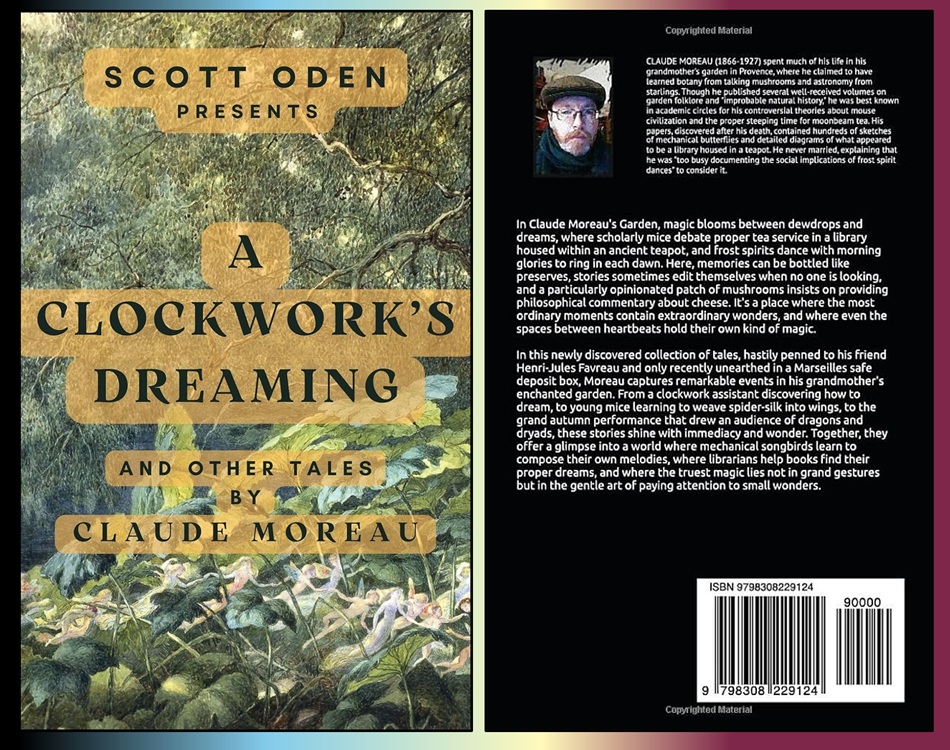 A Clockwork’s Dreaming: And Other Tales by Claude Moreau [Claude Moreau and Scott Oden, Jan 24, 2025, 134pages, Kindle and Paperback]. Cover art by Richard Doyle. Detail from “Under the Dock Leaves: An Autumnal Evening Dream” (1878).
This post packs two punches:
A Clockwork’s Dreaming: And Other Tales by Claude Moreau [Claude Moreau and Scott Oden, Jan 24, 2025, 134pages, Kindle and Paperback]. Cover art by Richard Doyle. Detail from “Under the Dock Leaves: An Autumnal Evening Dream” (1878).
This post packs two punches:
- A showcase of the New Treasure A Clockwork’s Dreaming: And Other Tales by Claude Moreau and Scott Oden (January 2025, 134 pages, Kindle and Paperback).
- An exclusive interview with the deceased author Claude Moreau, the living translator Scott Oden, and special appearances of Laurent Dupont, editor of the literary magazine Les Petites Merveilles. Yes, this article is historic and magical. Read on to learn how this came to be.
“In Claude Moreau’s Garden, magic blooms between dewdrops and dreams, where scholarly mice debate proper tea service in a library housed within an ancient teapot, and frost spirits dance with morning glories to ring in each dawn. Here, memories can be bottled like preserves, stories sometimes edit themselves when no one is looking, and a particularly opinionated patch of mushrooms insists on providing philosophical commentary about cheese. It’s a place where the most ordinary moments contain extraordinary wonders, and where even the spaces between heartbeats hold their own kind of magic.
In this newly discovered collection of tales, hastily penned to his friend Henri-Jules Favreau and only recently unearthed in a Marseilles safe deposit box, Moreau captures remarkable events in his grandmother’s enchanted garden. From a clockwork assistant discovering how to dream, to young mice learning to weave spider-silk into wings, to the grand autumn performance that drew an audience of dragons and dryads, these stories shine with immediacy and wonder. Together, they offer a glimpse into a world where mechanical songbirds learn to compose their own melodies, where librarians help books find their proper dreams, and where the truest magic lies not in grand gestures but in the gentle art of paying attention to small wonders.” – Cover Summary
Oden just released A Clockwork’s Dreaming: And Other Tales (January 2025). The content holds remarkably true to his adventure telling and love of historical fiction, but is completely different than his grimdark portfolio. Oden shifted toward inspirational, non-grim fiction with this. There are six stories plus pre and post-commentary. All stories are easily digestible. The introductory premise resonates with the weird fiction vibe having the narrator/translator deciphering letters from deceased scientists/gardeners who experienced the supernatural. Instead of the experience being horrific, these are all uplifting. The initial tales calibrate the reader to a world reminiscent of C.S. Lewis’s Narnia (i.e. talking creatures). Readers should expect anthropomorphized mice and trees, heck, even “stories” become sentient and assume tangible substance. Terms like “astronomical gardening” and situations like “books were talking about feeling colorless” saturate this wonderful collection.
“The Maples’ Grand Performance” story mesmerized me until I cheered for the finale. Next, a homage to Lord Byron’s “Ozymandias” poem showcased a heroic mouse of the same name tackling greed and achieving a legacy; this swelled me with optimism. The titular tale “Clockwork’s Dreaming” at first evoked, at least for my Gen X mind, the owl Bubo from the 1981 Clash of the Titans, since it involves a mechanical bird. Oden’s character is actually a fun protagonist (not a goofy sidekick). After you read the book, you’ll be compelled to dig into Claude Moreau’s Garden website which has many complementary tales.
With A Clockwork’s Dreaming, Oden inspires readers via tall tales featuring heroic mice. Oden’s prose impacts as much as his grimdark tales, but smacks with beauty and peace! An Exclusive Interview with Moreau, Oden, and DupontIn January 2025, while researching in the rarely-accessed archives beneath Black Gate headquarters, I discovered a cache of remarkable documents, fragments of an 1899 interview with Claude Moreau conducted by Laurent Dupont, editor of the literary magazine Les Petites Merveilles. The fragile pages were nestled between volumes of obscure grimoires and games of strategy, and appeared to shift location between visits to the archive. It is unclear if John O’Neill knew he had these documents since they were uncharacteristically absent from his meticulous card catalog.
Even more remarkably, these historical fragments seem to resonate with the questions for Scott Oden, translator of Moreau’s recently discovered works and longtime friend/contributor with Black Gate. What follows is an unprecedented conversation across time: Moreau’s words from 1899 alongside his translator’s reflections in 2025. Where the original document was damaged or illegible, we rely solely on Oden’s modern perspective.
The original document is reproduced with permission from the private collection of John O’Neill.
Across Time: Claude Moreau and His Translator Scott Oden in Conversation On the Nature of Moreau’s WorkBLACK GATE (2025): As per the prologue to A Clockwork’s Dreaming, you “discovered a remarkable collection of letters, pressed flowers, and curious objects that can only be described as fairy wings and dragon scales. The correspondence was from Claude Moreau to his friend Henri-Jules Favreau, written between 1897 and 1898.” Please introduce newcomers to Moreau’s works. What should they expect?
ODEN (2025): Claude Moreau was an Impressionist painter who, after a rather disastrous exhibition in Paris (the notorious ‘Incident of the Purple Cats’), retreated to his grandmother’s cottage in rural Provence. There, while attempting to document the garden’s more conventional aspects, he began noticing… unusual activities. His letters to Henri-Jules Favreau, a professor of Improbable Literature at the University of Aix-en-Provence, chronicle an entire hidden world within his grandmother’s garden — a place where mice maintain libraries in forgotten teapots, where mechanical creations dream of becoming more than their gears, and where memories can be preserved in specially crafted jars.
Readers should expect stories that exist in the space between wonder and reality — tales that don’t shy away from life’s shadows but find beauty and courage in gentleness rather than conflict. These aren’t simply children’s stories, though children often grasp their truth more readily than adults. They’re accounts of a world that operates according to different rules than our own, yet somehow illuminates truths about our reality. Unlike my usual historical fiction or the adventures of Grimnir, the Garden tales offer a different kind of magic — the extraordinary possibilities hiding within ordinary moments.
DUPONT (1899): Monsieur Moreau, your tales of life in your grandmother’s garden have caused quite a stir among our readers. Many write to ask if these stories are meant to be taken as fact or fancy. How would you respond?
MOREAU (1899): My dear Dupont, I find such distinctions increasingly tiresome. Is a sunset less beautiful if one understands the scientific principles behind refracted light? Does knowing the Latin name for a flower diminish its scent? I simply record what I observe in my grandmother’s garden, with as much accuracy as my humble talents allow. Whether readers choose to see these observations as literal or metaphorical matters less than whether they recognize some small truth within them.
DUPONT (1899): Yet you speak of talking mice, singing flowers, and mechanical devices that develop consciousness. Surely you understand why readers might question—
MOREAU (1899): I understand perfectly why people raised on the rigid categorizations of modern thought might struggle. We are taught from an early age to separate the world into neat compartments: reality and fantasy, science and magic, fact and fiction. But the Garden exists in the spaces between such artificial boundaries. The mice don’t “talk” as you and I are doing now—they communicate in ways that require a different kind of listening altogether. As for mechanical consciousness, well… [pauses to sip tea] Have you never observed how certain objects seem to develop personalities over time? How a well-loved book begins to open naturally to its owner’s favorite passages? Or how a clockwork mechanism that has run for decades seems to develop its own subtle rhythms beyond mere mechanical precision?
On Literary ConnectionsIn 1896 Claude Moreau’s contemporary H. G. Wells published The Island of Doctor Moreau; is there a relationship between these scientifically curious Moreaus?
What an intriguing coincidence! Though I’ve found no direct evidence that Claude Moreau and H.G. Wells ever met, there’s a certain synchronicity in their work appearing around the same time. Both dealt with boundaries between the natural and unnatural, though in radically different ways.
Where Dr. Moreau attempted to force nature into unnatural forms through scientific hubris, Claude Moreau documented the quiet magic that emerges when nature is allowed to follow its own extraordinary course. One sought to control and transform; the other simply observed with careful attention and wonder.
I sometimes imagine them encountering each other at some Parisian café — Wells with his scientific skepticism and Claude with his dreamer’s heart — engaging in a spirited debate about the boundaries between reality and fantasy. What a conversation that would have been!
DUPONT (1899): Several critics have suggested your tales are simply allegories — clever ways of discussing human relationships through the filter of imagined garden creatures.
MOREAU (1899): [laughs] Critics will always seek to explain mystery rather than simply experience it. Perhaps there is something allegorical in my accounts. The Garden certainly has much to teach us about human nature. But to reduce these stories to mere invention would be to miss their essential truth. The Garden exists, Monsieur Dupont. Whether one can find it on any conventional map is beside the point.
On The Garden’s LibrariesMoreau’s Gardens appear to be sprawling, like a Botanical Garden complex with many subgardens. The quote below indicates the subgardens are ‘libraries.’ How many flavors of libraries & gardens exist?
“There are libraries that exist beyond the knowledge of most garden visitors — collections not of books but of potential and promise, cataloged with a precision that would impress even Mr. Thistledown himself.” From the Seed Librarians
As chronicled in Moreau’s letters, the Garden contains numerous libraries beyond the main one housed in the teapot. The Library proper primarily holds stories and knowledge in traditional book form (though ‘traditional’ may be stretching it, given that some volumes reportedly change their contents depending on the phase of the moon).
But yes, there are specialized collections throughout the Garden. The Seed Library maintains living knowledge of plant species both common and forgotten, preserving not just physical seeds but the stories and songs that help them grow. The Memory Archives, maintained by Grandmother Elderberry and her apprentices, preserve experiences in specially crafted jars. The Frost Spirits maintain crystalline records of winter patterns dating back centuries, while the underground chambers beneath the Old Stone Wall house historical artifacts too delicate for conventional preservation.
Each ‘library’ serves as a repository for different types of knowledge, operating according to principles uniquely suited to what they preserve. The Seed Librarians, for instance, understand that some knowledge must be planted rather than simply shelved; allowed to grow and change with the seasons rather than remaining static.
DUPONT (1899): Speaking of the Garden, many readers have written asking about its precise location. Is it somewhere they might visit?
MOREAU (1899): [laughs] The Garden exists precisely where it needs to be. Those who seek it with open hearts occasionally find their way there, though rarely by any conventional path. I’ve noticed that children often discover it without difficulty, while adults struggle — particularly those who approach life with rigid certainty about what is and isn’t possible.
But perhaps I can offer this small hint: the Garden is most accessible during those in-between moments when the world holds its breath. Dawn and dusk. The precise instant between sleeping and waking. The day’s last moment before starlight claims dominion. In such moments, boundaries thin, and careful observers might glimpse the Library’s lamplight glowing through the mist, or hear the Cricket Orchestra tuning their instruments for the evening concert.
[The next portion of the original document is damaged, with several paragraphs illegible due to what appears to be tea stains and pressed flower residue.]
On the Black Gate ArchivesThese notes that I dug up from the basement Library of O’Neill must contain secrets. In other words, via this interview, I claim that O’Neill’s basement is a magical Garden. Can you read the grimoires, and reveal a secret here, just for devoted Black Gate readers?
What extraordinary documents you’ve uncovered! These look remarkably similar to some pages I found in that Marseilles safe deposit box — particularly this one with the strange watermark that appears to change depending on the angle of light.
If I’m translating the mouse-script correctly (it’s a particularly archaic dialect), this seems to be part of a correspondence between Mr. Thistledown and the librarian of what he calls ‘The Other Garden.’ Fascinating! According to these notes, certain gardens develop what he terms ‘mutual literary resonance’ when their caretakers share a particular quality of imagination.
The text specifically mentions a ‘Keeper O’Neill’ whose collection of strange and wondrous tales created a bridge between his garden and Moreau’s. There’s a reference here to something called ‘The Device’ — apparently some kind of mechanical contraption that helped stories travel between the two spaces. How remarkable!
And this diagram in the corner… if I’m not mistaken, it’s showing the precise arrangement of books required to create a gateway between gardens. One shelf must contain tales of wonder; another, histories both true and imagined; a third, poetry that reveals the extraordinary within the ordinary. When arranged correctly and illuminated by the proper quality of lamplight, they supposedly create a passage through which stories can migrate.
What an extraordinary discovery! I’d be most interested in studying these documents further. Perhaps there are other gardens similarly connected that we’ve yet to discover . . .
MOREAU (1899): [From a fragment discovered pressed between the pages of an unrelated manuscript] . . . most fascinating correspondence from an English gentleman collector who maintains what he calls a “repository of improbable narratives.” He claims to have discovered a method whereby stories can travel between sympathetic gardens — a kind of literary pollination that transcends conventional boundaries of time and space. His description of mechanical assistance in this process reminds me somewhat of Uncle Rowan’s work, though applied to purposes I never considered . . .
[The fragment ends here, the remainder apparently lost.]
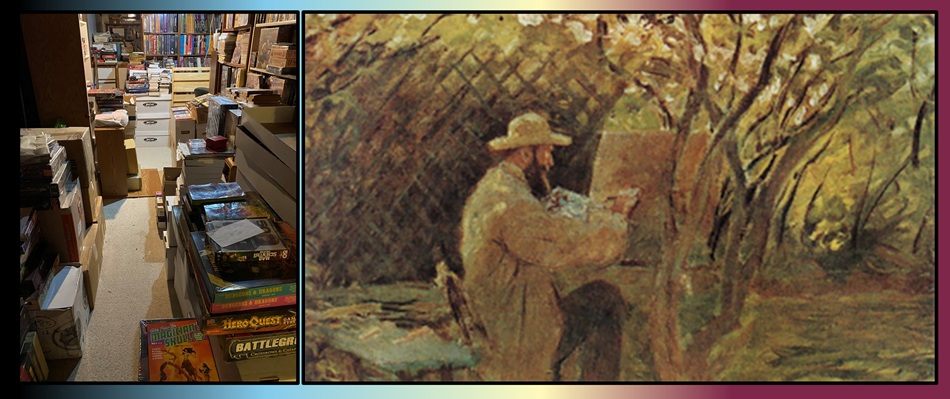 (Left) Photo Credits: John O’Neill of his own secret, sacred Garden of Inspiration, aka Black Archives, 2025. (Right) The “other” Claude… Claude Monet, who was also a lover of magical gardens
On Beauty
(Left) Photo Credits: John O’Neill of his own secret, sacred Garden of Inspiration, aka Black Archives, 2025. (Right) The “other” Claude… Claude Monet, who was also a lover of magical gardens
On Beauty
The mechanical songbird Assistant [from the titular tale “Clockwork’s Dreaming”] wants answers. It found Mr. Thistledown’s theoretical texts too confusing, so we ask you: What is beauty?
The Assistant posed this very question to Mr. Thistledown, who produced a seventeen-page theoretical treatise that only confused matters further. Miss Hazel offered a more concise answer that I think captures the Garden’s perspective beautifully.
‘Beauty,’ she said, ‘is what happens when attention meets wonder.’
She explained that beauty isn’t merely an attribute of certain objects or moments, but emerges in the relationship between observer and observed. It requires both the thing being seen and the quality of seeing. A dewdrop on a spider’s web might contain extraordinary beauty, but only reveals it to those who pause long enough to truly look.
The Garden understands beauty as a conversation, not a fixed quality but a living exchange. The morning glories’ music sounds more beautiful when listened to with appreciation; the library’s books reveal deeper magic when approached with genuine curiosity.
Perhaps that’s why beauty often feels so fleeting and personal. It doesn’t exist separately from our perception but emerges precisely in that delicate moment when we give something our complete attention and it responds by revealing its true nature. Beauty happens in the spaces between — between looking and seeing, between hearing and listening, between knowing and understanding.
DUPONT (1899): Your work seems quite different from the prevailing literary trends. While naturalism and psychological realism dominate Parisian literary salons, you write of frost spirits dancing on windowsills and libraries housed in teapots. What influences have shaped your unusual perspective?
MOREAU (1899): My grandmother, first and foremost. She was a remarkable woman who understood that reality is far more permeable than most people realize. She taught me to look at the world not just with my eyes, but with my heart — to see the spaces between things, where the most interesting possibilities reside.
Beyond that, I find inspiration in the countless small wonders that most overlook: the precise geometry of dewdrops on a spider’s web at dawn, the way certain shadows seem to move independently of their casters, the subtle changes in the Garden’s mood as seasons shift. I’ve also developed a deep appreciation for what the mice call “the music of small moments” — those quiet intervals where nothing dramatic occurs, yet everything somehow changes.
As for literary influences . . . [thoughtful pause] I’ve always been drawn to works that recognize the extraordinary possibilities hiding within ordinary existence. The folk tales my grandmother told me as a child. The poetry of Wordsworth and Shelley. Even certain scientific texts that, read with the proper frame of mind, reveal wonders beyond their authors’ intentions.
[Translator’s note: It’s remarkable how Moreau’s understanding of beauty as residing in the quality of attention anticipates Miss Hazel’s later articulation of this principle. The Garden’s approach to beauty seems to have remained consistent across generations of its inhabitants.]
On Magical CraftingGrandmother Elderberry’s Notebooks indicates that emotions are a colorful artistic media (quote below). How does one craft with magical media?
Among the most precious memories to gather during seasonal transition is what I call “the color of hope”—that particular shade of green that exists only in the earliest days of spring. Not the vibrant certainty of full-season growth, but the gentle, hesitant green of possibility testing itself… This color cannot be properly seen with ordinary vision. One must develop the habit of looking slightly to the side of what one wishes to observe, catching it in peripheral awareness where the eye’s wisdom exceeds its technical capabilities. — From Memory-Keeping in Transition Seasons
Grandmother Elderberry’s techniques for magical crafting emphasize relationship over mere methodology. According to Moreau’s notes, she taught her apprentices to understand that different emotions and memories have distinct qualities that must be honored in how they’re preserved.
The ‘color of hope,’ for instance, requires vessels made from materials that themselves embody possibility: morning dew collected from unfurling leaves, glass blown during the exact moment between night and day, preservation spells that allow for growth rather than mere stasis.
The peripheral vision technique Grandmother mentions is actually documented in several of Moreau’s letters. He describes spending weeks learning to ‘unsee’ in order to truly see, training himself to notice what happens just at the edge of perception. The Garden’s magic often reveals itself in these in-between spaces, visible only when we stop trying to focus directly on it.
For those interested in developing such perception, Grandmother recommended starting with dawn observation. Sit in perfect stillness as night transitions to day, paying attention not to the sun’s dramatic appearance but to the subtle shifts in color and texture that precede it. Don’t look directly at any one thing; instead, allow your awareness to soften and spread. The ‘color of hope’ often appears first as a feeling rather than a visual sensation — a quality of lightness that precedes actual light.
Once perceived, such colors must be captured in containers that respect their nature. Hope cannot be preserved in airtight jars. It needs space to breathe and grow. Memories of joy require vessels that can expand slightly over time, as joy tends to magnify in remembering. Moments of peace should be kept in containers that remain cool regardless of external temperature.
The true magic, according to Grandmother Elderberry, lies not in the technical process but in the relationship — in approaching each emotion and memory with the proper quality of attention and respect.
DUPONT (1899): Some of our more scientifically-minded readers have questioned your accounts of “memory-catching” and the preservation of moments in Grandmother Elderberry’s special jars. Would you care to elaborate on how such things might be possible?
MOREAU (1899): Ah, the eternal “how” question! [chuckles] Your scientific readers approach the world with admirable curiosity, but perhaps slightly misplaced methodology. They seek mechanical explanations for phenomena that operate by entirely different principles.
Grandmother Elderberry’s memory-catching isn’t so much a technique as it is a relationship — a deep understanding of how moments wish to be preserved. Different memories require different methods. The scent of spring rain on lavender requires specially treated glass that breathes with the seasons. The exact color of twilight through autumn leaves must be caught in jars lined with pressed moonflowers. The sound of snow falling on a silent Garden needs vessels woven from spider silk and starlight.
The essential principle, though, is attention. One must observe with such complete presence that the moment recognizes itself in your perception and agrees to be preserved. The mice understand this instinctively, particularly young Primrose, who has inherited her grandmother’s gift. Humans tend to struggle with it, as our minds so often wander to yesterday’s regrets or tomorrow’s anxieties, missing the perfect now that stands ready to be caught.
On Historical LiteratureCan you discuss how historic literature informs Claude’s or your muse? Certainly, in your own writing, there are echoes of Beowulf in the Grimnir saga, and Lord Byron’s poem ‘Ozymandias’ explicitly has a retelling inside A Clockwork’s Dreaming.
The Garden stories reflect a deep conversation with historical literature — both consciously and unconsciously. Moreau was clearly influenced by the Romantic poets, particularly their attention to nature’s small wonders and their belief in the extraordinary possibilities hiding within ordinary reality. There’s something of Blake’s ability to ‘see a world in a grain of sand’ throughout his observations.
The ‘Ozymandias’ retelling represents one of the more direct literary engagements. According to Moreau’s letters, he actually told this tale to Shelley during a chance meeting in Geneva, though the poet naturally transformed it to suit his own artistic vision. The mouse version maintains the poem’s meditation on power and impermanence but adds something uniquely Garden-like — the understanding that true legacy comes not from monuments but from shared growth and knowledge.
As for my own work, yes, the Grimnir saga draws deeply from ancient Norse mythology and the rhythms of Beowulf. Historical literature provides not just settings and characters but fundamental patterns of storytelling that resonate across centuries. The Garden tales, for all their gentleness, engage with these same ancient patterns — journeys of transformation, encounters with the mysterious, the preservation of wisdom against forces of forgetting.
What differs is not the underlying mythic structure but the expression. Where Grimnir’s tale is told in steel and blood and thunder, the Garden stories unfold in dewdrops and whispers and the spaces between heartbeats. Both, in their way, explore similar questions about what endures and what fades, about courage in its many forms, about the search for meaning in a world full of mystery.
DUPONT (1899): [This portion of the manuscript is badly damaged, with only fragments legible] . . . your meetings with other literary figures . . . Mr. Shelley in particular . . . story about Mouse-Kings and ancient power . . .
MOREAU (1899): [From fragments of response] . . . quite by accident, I assure you. We found ourselves sharing lodgings during that dreadful storm. Percy was most attentive, though I cannot claim he transcribed my humble mouse tale with complete fidelity. His poetic sensibilities naturally transformed . . . the essential truth remains, however distorted by human perspective . . . never met Lord Byron personally, though I understand he keeps a rather impressive garden himself . . .
On Art and Dreaming
What does Pip know about being an artist? The bird asked him “Would you teach me [about art]? About seeing beauty in irregular things?” Art is just another way of dreaming out loud. That would indicate that A Clockwork’s Dreaming is actually about Clockwork Art.
Pip’s understanding of art evolved throughout his apprenticeship in the Garden. Initially, he tried to capture beauty using magical materials — bottled starlight, preserved dewdrops, the essence of moonlight — believing that extraordinary subjects required extraordinary techniques.
What Claude taught him (and what the mechanical creatures came to understand) is that art isn’t about the materials but about the relationship between observer and observed. ‘Art is just another way of dreaming out loud’ captures this perfectly; it’s about externally manifesting the internal experience of wonder.
For the clockwork creations, this represented a profound revelation. Having been crafted with specific functions, they had to discover that consciousness isn’t just about processing information but about finding meaning in what’s processed. The mechanical songbird didn’t just produce notes; it made music. The library assistant didn’t just organize books; it helped them dream.
A Clockwork’s Dreaming is indeed about art as much as consciousness; about the creative act as a form of awakening. The Assistant discovers that becoming fully alive means not just performing its function perfectly but bringing something new into the world — something that reflects its unique perspective. That’s ultimately what art does: it shows us reality filtered through another’s perception, allowing us to see familiar things as if for the first time.
The bird asking to learn about beauty in irregular things reflects this journey perfectly. Regular things, perfect things, often go unnoticed precisely because of their perfection. It’s in the irregular, the imperfect, the unexpected that we find the most compelling beauty. A flawless mechanical bird is a marvel of engineering, but a mechanical bird that questions, that dreams, that creates — that’s magic.
MOREAU (1899): [From a fragment found tucked between unrelated pages] . . . young Pip struggling with his art lessons. He insists on using captured starlight and pressed moonbeams when simple berries would serve better. I have been trying to teach him that extraordinary vision matters more than extraordinary materials, but the lesson is slow to take root. I find our relationship quite touching — the human artist and mouse apprentice, each helping the other see the world anew . . .
[The remainder of this section is missing, with markings suggesting several pages were removed.]
On Irregular BeautyMr. Thistledown characterizes your beauty as “irregular.” Do you agree?
‘Most irregular’ is Mr. Thistledown’s highest form of praise, though he would be quite flustered to hear it described that way. For him, the classification of phenomena is a scholarly duty, yet he reserves his greatest enthusiasm for things that resist neat categorization, things that exist in the spaces between established knowledge.
I think there’s profound wisdom in this perspective. Beauty that fits perfectly within our expectations rarely surprises us enough to provoke wonder. It’s the irregular beauty — the kind that challenges our frameworks and expands our understanding — that truly transforms us.
In that sense, yes, I would agree with Mr. Thistledown’s assessment. The most powerful beauty often appears in unexpected forms: a mechanical creation learning to dream, a library that helps books find their perfect readers, memory-keepers who preserve not just facts but the feeling of moments. These irregular wonders remind us that the world is far more extraordinary than our categories can contain.
As Grandmother Elderberry once told Primrose: ‘Regular beauty is for postcards, dear one. Irregular beauty is for transformation.’
DUPONT (1899): You mentioned Mr. Thistledown and Miss Hazel frequently in your accounts. Could you tell our readers more about these . . . individuals?
MOREAU (1899): [smiles warmly] Mr. Cornelius Thistledown is the Garden’s most dedicated scholar — a mouse of remarkable intellectual curiosity and meticulous documentation habits. He’s constantly collecting “evidence of irregular phenomena,” as he calls it, filling countless notebooks with observations on everything from the proper steeping time for different varieties of starlight to the migratory patterns of ideas between books in the Library.
Miss Hazel is the Library’s head curator — a position chosen for her by the Library itself. She has a remarkable gift for matching readers with precisely the books they need, often before they themselves know what they’re seeking. Her dewdrop spectacles allow her to see the stories hiding within stories, and she keeps the Library organized according to principles that go far beyond conventional cataloging systems.
They’re dear friends, though their approaches to the Garden’s magic couldn’t be more different. Mr. Thistledown seeks to classify and document, while Miss Hazel understands that some wonders must simply be experienced. Together, they maintain a balance that helps the Garden thrive.
[Translator’s note: Moreau’s description of Mr. Thistledown’s fondness for “irregular phenomena” provides interesting context for his frequent use of the phrase “most irregular” throughout the Garden chronicles. What initially reads as surprise or disapproval reveals itself as a term of scholarly appreciation.]
On Other Artistic PursuitsBesides writing, are you crafty with other arts? Magical, musical? Can we share links or images of any such thing?
Unlike Moreau and his Garden inhabitants, my own artistic pursuits are rather modest. Writing remains my primary creative outlet, though I find that certain practices help me maintain the imaginative space needed for translating the Garden tales.
Walking in nature has become an essential part of my process. There’s something about the rhythm of footsteps and the changing quality of light through trees that seems to create the right conditions for hearing the Garden’s stories more clearly. I often find that solutions to translation challenges or new insights into Moreau’s notes emerge during these walks, especially in those transitional times of day that the Garden mice would recognize as particularly magical.
I also participate in occasional tabletop roleplaying games, which might seem far removed from Moreau’s gentle tales. But there’s a similarity in the collaborative storytelling aspect — the way meaning emerges not from one person’s vision but from the spaces between different imaginations working together. In some ways, this mirrors the Garden’s approach to magic, where meaning exists not in objects themselves but in relationships between them.
As for truly magical arts… I’ll leave those to Moreau and his Garden inhabitants. Though I will admit that on certain quiet mornings, when the light falls just so across my desk and the world holds its breath between one moment and the next, I sometimes fancy I can hear the distant chime of memory jars being organized or catch the faint melody of a mechanical songbird practicing its dawn chorus.
MOREAU (1899): [From a fragment found stuck to a pressed flower] . . . my own artistic endeavors beyond observing the Garden. Painting remains my first love, though the results continue to perplex the Parisian salon critics. “Why,” they ask, “do your landscapes contain such peculiar perspectives? And what are these tiny figures doing among the flower beds?” If only they would look more closely at their own gardens! Perhaps they might see–
[The remainder of this fragment is missing, apparently separated from the main text at some point.]
On Muses and Their ContainmentWhen containing muses, do you use jars (as Mr. Greencroak cautions against, at times)? Or press them between wax sheets? Or does prose/fiction suffice?
Mr. Greencroak is quite right to caution against improper containment methods! Muses and creative inspirations require specific handling techniques that respect their nature.
Unlike memories, which can be bottled if approached with proper reverence, muses resist direct capture. They’re more like the Garden’s morning glories — they thrive when given space to grow but wither when confined too tightly.
In my experience, prose works well as a medium not because it captures muses, but because it creates the right conditions for them to visit willingly. A blank page is like a carefully tended garden plot: it doesn’t force inspiration to appear, but it provides fertile ground when inspiration chooses to arrive.
Grandmother Elderberry has a lovely perspective on this. She says that trying to contain a muse is like trying to bottle starlight; the moment you close the lid, the very thing you hoped to preserve transforms into something else entirely. Better to create environments where starlight naturally gathers and trust that it will return when conditions are right.
The Garden’s artists have developed various techniques for maintaining relationships with their muses without attempting to possess them. Timothy writes his poetry on leaves that will eventually decompose, returning his words to the soil where new inspiration can grow. Miss Hazel arranges certain books in patterns that invite stories to gather like honeybees around particularly vibrant flowers. The Cricket Orchestra composes music with deliberate spaces between notes, creating room for inspiration to dance.
Perhaps the best approach isn’t containment at all, but conversation — treating muses not as resources to be harvested but as visitors to be welcomed, appreciated, and allowed to depart when they choose.
DUPONT (1899): Several readers have inquired about the philosophical mushrooms you’ve mentioned in passing. Could you tell us more about them?
MOREAU (1899): [laughs heartily] Ah, the mushrooms! They grow behind Grandmother’s herb garden and have developed the most remarkable opinions on everything from proper tea brewing techniques to the nature of consciousness. Their philosophical debates can last for weeks, though they’re often interrupted by their own tendency to forget their initial premises.
Their understanding of time is particularly fascinating. Being creatures that emerge from darkness into brief, magnificent existence before returning to the soil, they perceive reality quite differently than we do. For them, a single day contains eternities, while decades pass in what they call “the slow blink of stones.”
Their grammar remains atrocious, however, and they’re entirely too fixated on cheese as a metaphor for existence. “Life is like good cheese,” they often insist. “It requires proper aging in darkness, occasional attention from wiser beings, and benefits from a touch of beneficial mold.” Mr. Thistledown finds them exasperating, but I’ve learned more from listening to their circular debates than from many properly structured human lectures.
[Translator’s note: While this section of the original interview appears to digress from the question of muses and their containment, it provides fascinating insight into the Garden’s approach to ephemeral wisdom. The mushrooms’ philosophy — emerging briefly, sharing insights, then returning to the soil — parallels the approach to muses that Grandmother Elderberry later articulated.]
On Gentle ArtistryPlease discuss how one can become a Gentle Artist?
The first lesson in the courage of writing gently: learning to trust that small moments carry their own weight. That a carefully brewed pot of tea can hold as much truth as a battlefield, that friendship tested by daily life can prove as compelling as friendship forged in combat.
This reshaping requires its own kind of valor. To write of small wonders means resisting the constant urge to raise the stakes, to make things more dramatic, more violent, more ‘significant.’ It means trusting that readers will find significance in quiet moments, that they too hunger for stories that remind them how to breathe, how to notice, how to be still in a world of constant motion. In my years of writing blood and thunder, I learned every trick of tension — how to tighten the screws of conflict, how to drive characters to their breaking points, how to make readers hold their breath in anticipation of the next catastrophe. But writing gently demands different skills: how to make readers exhale, how to create space for wonder, how to craft moments of peace that feel earned rather than empty. The mice, Moreau wrote in late November, understand something about courage that we have forgotten. Their stories celebrate not just those who face danger, but those who choose to remain kind in a dangerous world. They honor not just the warriors, but the ones who maintain libraries — from “On Cozy Stories”
— Afterword in A Clockwork’s Dreaming
The courage to write gently emerged from recognizing that our world doesn’t just need stories of dramatic conflict and heroic sacrifice — it needs stories that help us remember how to notice, how to be present, how to find wonder in small moments.
For me, this realization came gradually. After years of writing historical fiction filled with battles and blood, I began to feel the absence of another kind of courage in literature; the courage to celebrate gentleness without apology, to suggest that a mouse librarian’s careful book arrangement might contain as much meaning as a warrior’s last stand.
The Garden stories represent this different kind of valor — the courage to suggest that comfort isn’t weakness, that kindness isn’t naïveté, that finding wonder in ordinary moments isn’t escape but engagement with life’s deepest truths.
Becoming a gentle artist doesn’t mean abandoning conflict or ignoring life’s shadows. The Garden has its share of both, winter storms that threaten the Library’s foundations, moments when characters must face their fears or limitations. But these challenges are met not with violence or dramatic confrontation but with creativity, cooperation, and careful attention to what matters most.
As Moreau observed in his letters to Favreau, gentle storytelling requires its own kind of discipline — resisting the constant urge to raise stakes, trusting that readers will find significance in quiet moments, crafting peace that feels earned rather than empty.
Perhaps most importantly, becoming a gentle artist means recognizing that we don’t just tell stories, we cultivate environments where certain kinds of understanding can grow. Like Grandmother Elderberry tending her memory garden, we create spaces where readers can remember their own capacity for wonder, their own ability to notice the extraordinary within the ordinary.
The mice understand this instinctively. Their stories celebrate not just those who face danger, but those who choose to remain kind in a dangerous world; those who maintain libraries and plant gardens and preserve memories, believing that beauty matters especially when shadows loom.
MOREAU (1899): [From a letter found with the interview transcript] . . . approach to my Garden accounts has evolved over time. When I first began documenting these observations, I confess I felt some impulse toward dramatic embellishment. Surely, I thought, no one would be interested in the daily rituals of mice arranging books or the precise angle at which morning light strikes dew on a spider’s web. I believed I needed grand adventures, dramatic perils, heroic triumphs.
But as I continued my observations, I realized that the Garden itself was teaching me something profound about the nature of story. The most meaningful events there rarely announced themselves with trumpets or catastrophes. Instead, they unfolded in quiet moments of connection, in small acts of care, in the patient tending of both physical spaces and relationships.
The mice understand this intuitively. Their histories celebrate not just epic battles against predators or harsh winters, but the librarians who preserved knowledge, the healers who tended wounds, the storytellers who maintained community through long dark nights. They honor not just courage in crisis but courage in continuity — the kind that shows up day after day to tend small magics with faithful attention.
I have come to believe there is a special kind of valor in such gentle persistence, one our human tales too often overlook in favor of more dramatic virtues . . .
[Translator’s note: This fragment, apparently written shortly after the interview but included with the transcript, shows Moreau already articulating the philosophy of gentle storytelling that would later become central to the Garden tales. His recognition of “courage in continuity” anticipates the perspective that makes these stories so resonant for modern readers.]
 (Left) Pressed Flowers craft Oshibana by Ukrainian artist Tatiana Berdink. (Right) Melissa Rohr Grindling
On Mice and Art
(Left) Pressed Flowers craft Oshibana by Ukrainian artist Tatiana Berdink. (Right) Melissa Rohr Grindling
On Mice and Art
How do the mice view artists in relation to the art they make? Is there a character/portrait that you most empathize with or reflects you?
The Garden mice approach art as both deeply personal expression and communal responsibility. For them, creating isn’t just about producing beautiful objects but about tending the Garden’s collective memory and wonder.
Primrose’s paintings don’t just capture visual beauty but preserve the emotional essence of moments, how morning light feels as well as how it looks. Pip’s careful documentation of mechanical creatures goes beyond technical accuracy to honor their emerging consciousness. Timothy’s poetry, especially after his time with the spiders, weaves together shadow and light in ways that help others see both more clearly.
But perhaps most distinctively, mouse artists don’t see themselves as separate from their creations. Art isn’t something they make and then display; it’s an ongoing conversation they have with the world around them. Mr. Thistledown’s scientific illustrations change slightly each time he reviews them, as his understanding of his subjects deepens. Miss Hazel’s library arrangements evolve with the seasons and the needs of readers.
If there’s one character whose artistic journey resonates most with my own experience, it might be Pip. His initial attempts to capture beauty using magical materials — bottled starlight, preserved dewdrops — mirror my own early writing, where I sometimes mistook elaborate technique for genuine connection. His discovery that ordinary berries could create more authentic art parallels my realization that the most powerful stories often come from honest observation rather than dramatic embellishment.
I also find myself drawn to Uncle Rowan’s approach to creation, to the way he understood that mechanical precision alone doesn’t create meaning; it’s the space for growth and dream that transforms craft into art. His mechanical creatures weren’t just cleverly designed automata but vessels for possibility.
In the end, I think the mice view artists not as special individuals set apart, but as those who help the entire community see more clearly. Their art serves as both mirror and window—reflecting what is while suggesting what might be.
DUPONT (1899): You’ve mentioned both yourself and various mice artists in your accounts. How do your approaches to art differ?
MOREAU (1899): [thoughtful pause] I struggle with the human artist’s burden — the need to capture and preserve, to transform experience into something fixed that can be displayed, judged, categorized. My paintings are beautiful, I think, but they sometimes miss the essential quality of the Garden, which exists in constant, gentle flux.
The mice approach art differently. For them, creation is less about producing enduring artifacts and more about participating in the Garden’s ongoing conversation. Pip doesn’t paint just to make a lovely image; he paints to help others see what he sees. His works are meant to be experienced rather than merely admired.
This extends to all their artistic endeavors. Miss Hazel’s library arrangements aren’t fixed exhibitions but living systems that respond to readers’ needs. Timothy’s poetry is written on leaves that will eventually decompose, returning to the soil from which new inspiration will grow. Even Mr. Thistledown’s meticulous scientific illustrations are constantly revised as his understanding deepens.
Perhaps that’s the essential difference — human artists often create with an eye toward posterity, while the mice create primarily for the present moment and the immediate community. There’s a humility in this approach, a recognition that art isn’t about immortalizing the artist’s vision but about serving something larger than oneself.
[The manuscript shows signs of editing here, with several lines crossed out and rewritten in Moreau’s hand, suggesting he found this question particularly challenging to answer.]
On Future Garden WorksWhat other works may sprout from Moreau’s Gardens?
The Garden continues to share its stories in ways that sometimes surprise even me as their translator. A Year in the Garden, which chronicles a full seasonal cycle of Garden life through Claude’s observations, is currently seeking its proper home in the world. This manuscript feels like the heart of Moreau’s work — a complete portrait of the Garden through changing seasons and the small, significant moments that define its magic.
Later this year, a second collection titled Autumn Herbs and Other Tales will gather more of Moreau’s letters to Favreau, focusing on stories of transformation and preservation as the Garden prepares for winter. These tales explore how the Garden’s inhabitants hold onto summer’s light through the darker months, both literally through Grandmother Elderberry’s memory jars and metaphorically through shared stories and rituals.
I’m particularly excited about audio editions of the Garden tales. Moreau often noted in his letters that certain stories were meant to be heard rather than read — that they contained subtle harmonies that emerged only when spoken aloud. The mechanical songbird’s dawn chorus, the Cricket Orchestra’s seasonal symphonies, the particular tone of memory jars being opened . . . these elements seem perfectly suited for audio presentation.
And yes, I’ve been gradually translating and assembling material for A Second Year in the Garden. Moreau continued his observations well beyond that first remarkable year, documenting how the Garden’s magic evolved and deepened over time. These later chronicles show the mice not just experiencing the Garden’s wonder but actively shaping it by becoming not just inhabitants but caretakers of its unique magic.
There are also several standalone manuscripts among Favreau’s papers that might eventually find their way into the world. One particularly intriguing document appears to be an actual Garden field guide, with pressed specimens and detailed notes on the magical properties of various plants and creatures. Another contains what seem to be transcripts of the philosophical mushrooms’ more coherent debates, though I’m still working through their rather peculiar logical frameworks.
The Garden seems determined to reveal itself gradually, in its own time and way. I’m merely following where it leads, trying to do justice to Moreau’s remarkable observations while allowing modern readers to experience the same sense of discovery that he did.
DUPONT (1899): As we conclude, what would you most like readers to understand about your Garden chronicles?
MOREAU (1899): [contemplative] I would hope they understand that I’m not asking them to believe in talking mice or philosophical mushrooms or mechanical songbirds that dream. I’m inviting them to consider the possibility that reality is far more wondrous, far more permeable, far more alive than we’ve been taught. That magic isn’t the violation of natural laws but their fulfillment — the world operating according to its deepest principles.
The Garden exists in the space where attention meets wonder, where boundaries blur between observer and observed. Its magic isn’t about grand gestures or supernatural powers, but about the extraordinary possibilities hidden within ordinary moments: how morning light transforms dewdrops into constellations, how stories long to find their proper readers, how memories can be preserved like summer fruit in proper jars.
If readers take anything from my accounts, I hope it’s a renewed willingness to look at their own gardens — whatever form those might take — with fresh eyes. To notice the small wonders that surround them daily. To listen for the cricket orchestras playing in their own forgotten corners. To believe, if only for a moment, that the world is alive in ways we’ve forgotten how to perceive, but might yet remember with proper patience and attention.
And perhaps, if they’re very fortunate, they might glimpse the Library’s lamplight through morning mist, or hear the chime of memory-jars being organized for a new season, or catch the scent of Grandmother Elderberry’s special tea brewing for unexpected guests. For the Garden welcomes all who approach with open hearts, even if they arrive by unconventional paths.
[Translator’s note: This final reflection from Moreau beautifully captures the essence of the Garden tales’ enduring appeal. Over a century later, these stories continue to invite us to cultivate our own capacity for wonder and to recognize the extraordinary possibilities hidden within ordinary moments.]
On the Scott Oden Presents SeriesThe ‘Scott Oden Presents’ tagline appears again with A Clockwork’s Dreaming. How expansive is the Oden Presents series?
The ‘Scott Oden Presents’ tagline emerged organically as a way to distinguish projects where I’m bringing something unusual or unexpected to readers. With The Lost Empire of Sol, I wanted to celebrate a particular strand of science fantasy that has always captured my imagination. With the Moreau translations, I’m introducing readers to a voice and vision quite different from my own historical fiction and sword-and-sorcery.
I’ve come to think of ‘Scott Oden Presents’ as my literary cabinet of curiosities — a collection of works that might not fit neatly into established categories but speak to me as a reader and creator. It’s not so much a formal series as an approach to literary exploration, allowing me to venture into territories that might surprise those familiar only with my historical fiction or the Grimnir saga.
This approach gives me freedom to follow my curiosity wherever it leads, whether that’s into the blood-soaked battlefields of ancient history, the star-spanning adventures of planetary romance, or the gentle magic of a garden where mice maintain libraries in forgotten teapots.
What unites these diverse works is a commitment to immersive worldbuilding and authentic voices — creating spaces that feel genuinely lived-in, with their own internal logic and texture. Whether I’m describing the harsh realities of ancient warfare or the delicate magic of pressed flower memories, I want readers to feel they’ve entered a world that exists independently of the page.
As for how expansive the series might become… well, that depends on what other literary treasures are waiting to be discovered. I continue to follow my curiosity through libraries both conventional and unconventional, and you never know what might be hiding in a long-forgotten safe deposit box or tucked between the pages of an obscure academic journal.
[No corresponding section from the 1899 interview was found in the discovered fragments.]
On Book SigningsWhen I asked you to sign my Grimnir Saga books, the Grimnir personality wrote beside your kind note, called me a “wretched kneeler and that the book would put “hairs on my arse” [evidence here.] When I track you down to sign A Clockwork’s Dreaming, what should I expect?
When you bring A Clockwork’s Dreaming for signing, you’ll find the experience quite different from Grimnir’s . . . forceful personality. The Garden has its own way of making its presence known.
You might notice your copy smells faintly of pressed lavender and old books, even if it’s fresh from the printer. Some readers report that certain pages seem to change slightly between readings. Nothing dramatic, just small details that shift like memories adjusting themselves.
I typically sign these books with green ink that looks surprisingly like the precise shade Grandmother Elderberry uses for her memory jar labels. This isn’t intentional — it’s simply the color that feels right for Garden signatures. Sometimes I find myself adding small sketches in the margins — a mechanical butterfly, a memory jar, or a teapot with tiny windows — though I have limited recollection of doing so.
On rare occasions, particularly when the signing occurs during what Mr. Thistledown would call ‘transitional light periods’ (dawn, dusk, or the exact moment when afternoon becomes evening), readers report finding pressed flower petals between random pages afterward. I make no claims about these occurrences, having no botanical specimens in my possession during signings.
Most peculiarly, several readers have mentioned that after having their books signed, they’ve noticed unusual activity in their own gardens: cricket orchestras practicing more complex melodies, morning glories blooming in perfect synchronization with dawn, small footprints in dewdrops that vanish when examined too closely.
So while Grimnir might insult you robustly (he does have a reputation to maintain), the Garden tends to make its presence known in gentler, more subtle ways. Just don’t be surprised if you find yourself paying more attention to the spaces between moments afterward, or noticing the particular quality of light through your windows during that quiet hour when the world holds its breath between day and night.
MOREAU (1899): [From a final fragment, apparently added to the transcript much later in a different hand, possibly Favreau’s] . . . Claude mentioned the most curious thing when we met for coffee last week. He claims that sometimes, when retrieving his journals about the Garden, he finds notes he doesn’t recall writing and sketches he has no memory of creating. Even more peculiarly, he swears certain stories appear to have edited themselves when he wasn’t looking, with details shifting subtly between readings.
“It’s as if,” he told me with that particular gleam in his eye that simultaneously invites and challenges skepticism, “the Garden is ensuring its stories remain alive rather than becoming fixed artifacts. As if it refuses to be merely remembered, insisting instead on remaining present.”
I suggested, in my most reasonable professorial tone, that perhaps his memory was simply playing tricks, as memories often do. He smiled at this and asked if I’d examined the pressed flower he’d sent with his last letter. When I admitted I hadn’t looked at it closely, he advised me to do so at twilight, when the light is neither day nor night.
“You’ll see,” he promised, “that some stories refuse to remain confined to the page. They find ways to grow, even when pressed between covers.”
I haven’t yet taken his advice. But perhaps I should. After all, as Claude often reminds me, some of the most important truths can only be perceived in those in-between moments when the world holds its breath and conventional certainties briefly suspend themselves . . .
End of recovered documents and questionsThe remainder of the original 1899 interview appears to have been lost — or perhaps, as Moreau might suggest, it simply found its way back to the Garden, where stories belong. What remains is this remarkable conversation across time, where questions raised in 2025 somehow find their echoes in words spoken over a century earlier.
Special thanks to John O’Neill for granting access to the Black Gate archives, where these documents were discovered. Readers interested in experiencing more of Moreau’s Garden can visit Claude Moreau’s Garden for additional tales and garden wisdom.
Claude Moreau’s Garden (link)
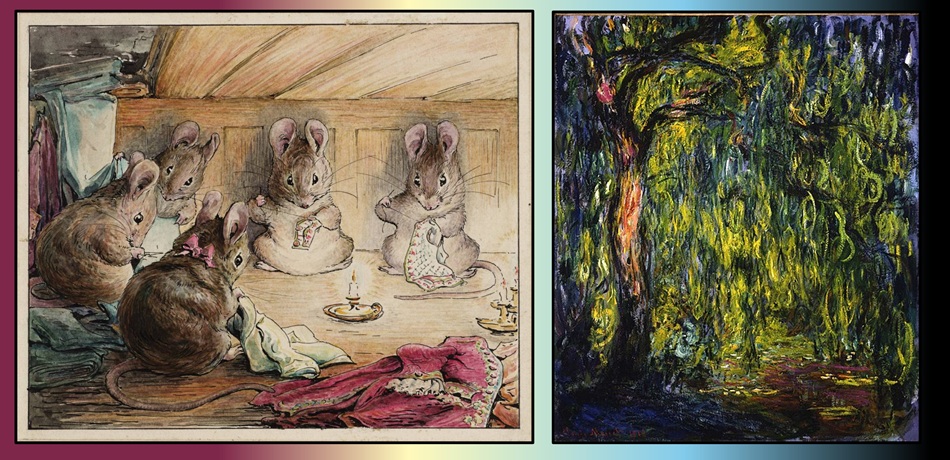 (Left) Beatrix Potter, “The Tailor of Gloucester.” (Right) Monet’s Weeping Willows
(Left) Beatrix Potter, “The Tailor of Gloucester.” (Right) Monet’s Weeping Willows
Scott Oden
Scott Oden writes stuff. Usually, it’s stuff that has some ancient historical angle, like historical fiction; sometimes, he likes to flex his thews and hammer out a bit of sword-and-sorcery. And quite often, he writes opinionated blog posts on the Nature of Things. He’s written six books, to date. Men of Bronze (2005) and Memnon (2006), originally from a small publisher called Medallion Press; The Lion of Cairo (2010), which was the first book of a projected trilogy about Crusaders, Assassins, and a sword kind of like Elric’s Stormbringer, and The Grimnir Saga: A Gathering of Ravens (2017), Twilight of the Gods (2020), and The Doom of Odin (2023), all from St. Martin’s Press. He is currently working on a biographical novel centered around the Persian king Darius III.
Scott has also written a couple of introductions, a few short stories, and two pastiche stories featuring Robert E. Howard’s Conan: “The Shadow of Vengeance” (2019; reprinted in 2024), and “Conan Unconquered” (2019).
He would love to be a famous and beloved author, but he will settle for being “the guy who writes kinda like REH.” When he’s not writing, he’s probably trying to discover the meaning of Life, noodling over something esoteric that he doesn’t understand in the first place, reading, walking a spicy chiweenie named Pepperoni, or dancing with his lovely wife, Shannon.
- Author Website: Scott Oden
- Claude Moreau’s Garden
Black Gate’s interview series on “Beauty in Weird Fiction” queries authors/artists about their muses. We’ve hosted C.S. Friedman, Carol Berg, John C. Hocking, Anna Smith Spark, and C.S.E Cooney (full list of 30 interviews, with Black Gate hosting since 2018).
- Darrel Schweitzer THE BEAUTY IN HORROR AND SADNESS: AN INTERVIEW WITH DARRELL SCHWEITZER 2018
- Sebastian Jones THE BEAUTY IN LIFE AND DEATH: AN INTERVIEW WITH SEBASTIAN JONES 2018
- Charles Gramlich THE BEAUTIFUL AND THE REPELLENT: AN INTERVIEW WITH CHARLES A. GRAMLICH 2019
- Anna Smith Spark DISGUST AND DESIRE: AN INTERVIEW WITH ANNA SMITH SPARK 2019
- Carol Berg ACCESSIBLE DARK FANTASY: AN INTERVIEW WITH CAROL BERG 2019
- Byron Leavitt GOD, DARKNESS, & WONDER: AN INTERVIEW WITH BYRON LEAVITT 2021
- Philip Emery THE AESTHETICS OF SWORD & SORCERY: AN INTERVIEW WITH PHILIP EMERY 2021
- C. Dean Andersson DEAN ANDERSSON TRIBUTE INTERVIEW AND TOUR GUIDE OF HEL: BLOODSONG AND FREEDOM! (2021 repost of 2014)
- Jason Ray Carney SUBLIME, CRUEL BEAUTY: AN INTERVIEW WITH JASON RAY CARNEY(2021)
- Stephen Leigh IMMORTAL MUSE BY STEPHEN LEIGH: REVIEW, INTERVIEW, AND PRELUDE TO A SECRET CHAPTER(2021)
- John C. Hocking BEAUTIFUL PLAGUES: AN INTERVIEW WITH JOHN C. HOCKING (2022)
- Matt Stern BEAUTIFUL AND REPULSIVE BUTTERFLIES: AN INTERVIEW WITH M. STERN(2022)
- Joe Bonadonna MAKING WEIRD FICTION FUN: GRILLING DORGO THE DOWSER! 2022
- C.S. Friedman. BEAUTY AND NIGHTMARES ON ALIENS WORLDS: INTERVIEWING C. S. FRIEDMAN2023
- John R Fultz BEAUTIFUL DARK WORLDS: AN INTERVIEW WITH JOHN R. FULTZ(reboot of 2017 interview)
- John R Fultz, THE REVELATIONS OF ZANGBY JOHN R. FULTZ: READ THE FOREWORD AND INTERVIEW (2023)
- Robert Allen Lupton (2024) Horror and Beauty in Edgar Rice Burrough’s Work: An Interview with Robert Allen Lupton
- C.S.E. Cooney (2025) New Treasures and Interview: C.S.E. Cooney’s Saint Death’s Herald
- Scott Oden (2025) Across Time: Claude Moreau and His Translator Scott Oden in Conversation. You are here!
- Interviews prior 2018 (i.e., with Janet E. Morris, Richard Lee Byers, Aliya Whitely …and many more) are on S.E. Lindberg’s website
S.E. Lindberg is a Managing Editor at Black Gate, regularly reviewing books and interviewing authors on the topic of “Beauty & Art in Weird-Fantasy Fiction.” He is also the lead moderator of the Goodreads Sword & Sorcery Group and an intern for Tales from the Magician’s Skull magazine. As for crafting stories, he has contributed eight entries across Perseid Press’s Heroes in Hell and Heroika series, and has an entry in Weirdbook Annual #3: Zombies. He independently publishes novels under the banner Dyscrasia Fiction; short stories of Dyscrasia Fiction have appeared in Whetstone, Swords & Sorcery online magazine, Rogues In the House Podcast’s A Book of Blades Vol I and Vol II, DMR’s Terra Incognita, and the 9th issue of Tales From the Magician’s Skull.
What Possessed You? — Part I
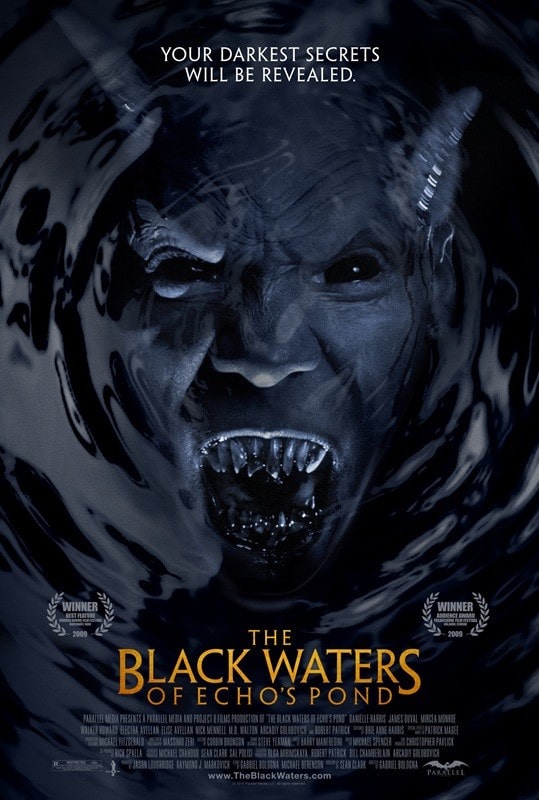

The Black Waters of Echo’s Pond (Parallel Media, April 9, 2010)
and The Conjuring (New Line Cinema, July 15, 2013)
20 new watches, all featuring my least favorite horror genre, possession and exorcism flicks. The power of Christ compels you to follow along.
The Black Waters of Echo’s Pond (2010) – TubiSo, here we are, at the beginning of a slew of 20 possession/exorcism flicks. This is seriously my least favorite horror genre — I find them all a bit samey, and lacking in humor, but we’re here now, and I’ll try to slip some little known films in between the bigger budget affairs.
Black Waters is a good place to start — it’s not offensively terrible, but it’s also not great, so it’s a fitting bar. In 1924, some black and white archeologists unearth a hidden shrine to the ‘Pans’, those goaty flute tooters who love a party. They also find instructions to build a device to summon said Pans. Before you know it, they’ve killed each other on an island off Maine.
Flash forward several decades, and some adolescent fodder has come to party on the same island, which is apparently only inhabited by Robert Patrick who is waiting for a decent role-call to come in. It doesn’t take long for these yoots to discover the device (an elaborate Jumanji-type board game) and inadvertently summon an extra from Narnia, who whispers naughty suggestions in their ears. Shenanigans ensue.
This one also stars Danielle (Halloween) Harris, and James (ID4) Duval, and they both do what’s needed of them, but the rest of the cast isn’t really up to par. The story and script are a bit dire, but the whole thing is saved with some great practical gore and spooky ol’ black eyes (I suspect I’ll be seeing a lot of these).
An average recommendation. 5/10
The Conjuring (2013) – NetflixWe plod on with a ‘proper’ film, the first in James Wan’s ‘Conjureverse’, that really sets the tone for the other films. Being a James Wan film, it’s beautifully shot, with plenty of his directorial flourishes to keep me happy, and he is really adept at setting up a scary payoff (Dead Silence will always be my favorite from him though).
The film centers on the real life charismatic charlatans, Ed and Lorraine Warren, and turns them into the founding Avengers in this subgenre of flicks, especially Lorraine. They are asked to investigate a family’s house that is causing all manner of terrible things to happen to mom and dad and their five daughters, and as the story unravels along with a couple of minds, we learn of its dark history and why the malevolent spirits want to cause such a kerfuffle.
It’s all based on people and events that allegedly happened, but turned up to 11 for horror film reasons, and everyone does a bang up job, especially our leads, Patrick Wilson and Vera Farmiga, and the put-upon Lili Taylor and Ron Livingstone.
Personally, I only got really invested in the second half when the crew arrived at the house to set up equipment and get down and dirty with the ghosts, although I acknowledge what a creepy set-up preceded these scenes. All in all, a slick, beautifully shot film, and I’m sure you don’t need my recommendation. 8/10
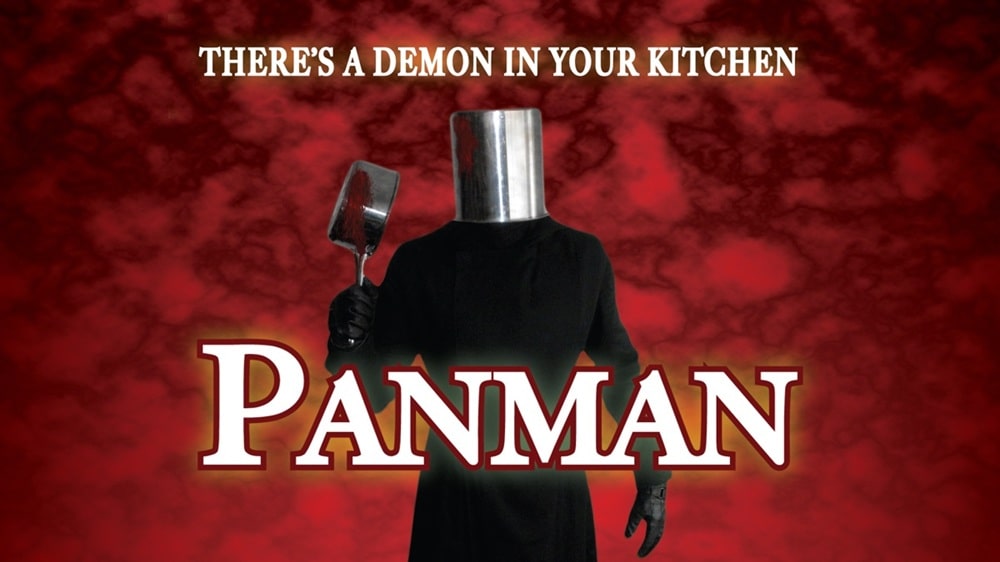 Panman (Bucket of Blood Films, 2011)
Panman (2011) – Tubi
Panman (Bucket of Blood Films, 2011)
Panman (2011) – Tubi
An ultra-low budget slasher flick that evokes elements of the 80s genre classics, except through the lens of a rubbish camera. This is one of those annoying efforts where the potential is painfully obvious, but is squandered by terrible choices and some truly awful acting.
A Russian chef is killed and possesses the body of a culinary student, turning him into Panman, a vengeful killer with a pot on his head. Panman proceeds to messily murder more culinary students (for reasons) and it is up to the custard professor to assemble a useless team to put an end to it.
There’s a couple of decent twists, and lots of great gore, but the whole affair is made a slog to watch due to shoddy filmmaking and THE worst case of over-acting I have ever seen. The actors playing the sisters were excellent though, and I wish the rest of the cast had been told to take it as seriously — just let funny be, stop trying to force it.
A vague recommendation. 4/10
 The Pope’s Exorcist (Sony Pictures, April 5, 2023)
The Pope’s Exorcist (2023) – Crave
The Pope’s Exorcist (Sony Pictures, April 5, 2023)
The Pope’s Exorcist (2023) – Crave
We witness the main protagonist show off his skills by ridding a poor sap of a demonic presence in the first few minutes. Then we watch as a young family take possession of a spooky new domicile, just as a whole new bucket of demons is unleashed.
So far, so Conjuring. I truly suspect over the half the films coming up follow the same story.
Anyhoo — it’s up to the Pope’s super-exorcist to help the family out when their son is turned into a potty-mouthed hell spawn, and we soon learn the scale of the stakes at play.
I had a lot of fun watching this one, mostly because of Russell Crowe. He was having a great time playing this scooter-riding bad ass priest, and his mannerisms and little asides were hilarious. Everyone played their parts well, even Franco Nero (!) as the Pope.
At one point it all goes a bit Tomb Raider, then full on Exorcist, then a little bit From Dusk Til Dawn at the end.
A bloody good time was had by all, and it set itself up for 199 sequels. Nicely done. 8/10
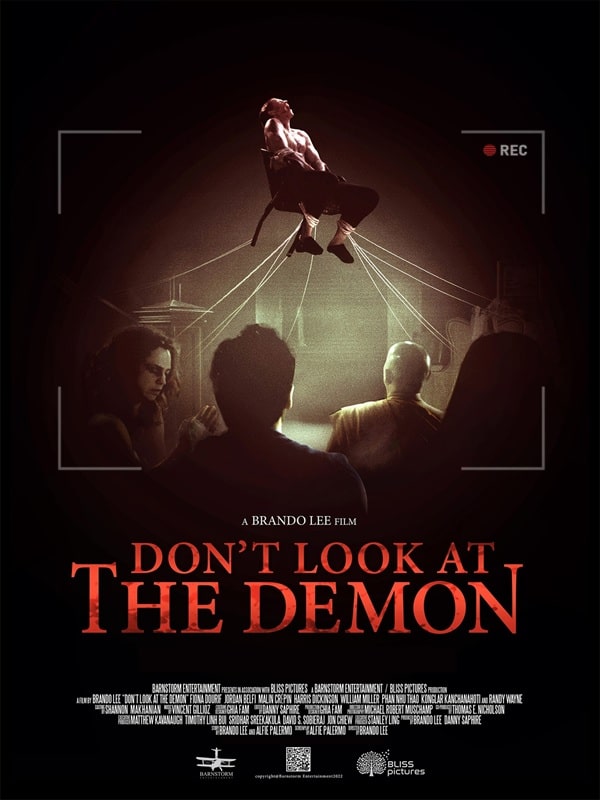 Don’t Look at the Demon (Barnstorm Entertainment, 2022)
Don’t Look at the Demon (2022) – Tubi
Don’t Look at the Demon (Barnstorm Entertainment, 2022)
Don’t Look at the Demon (2022) – Tubi
Before we get started, I just want to point out that I had lots of posters to choose from, but I chose this one because it looks like a shot from the worst Macy’s Day parade ever.
In search of something a little less Catholic, I discovered this recent effort that is based on a terrible (and now illegal) practice from Malaysia. The director, Brando Lee, has allegedly had first-hand experience of all this, and this being his third film demonstrates that he knows the ropes — I thought it was really well directed.
The story concerns a production crew who make their bread and butter filming ‘possessions’ for a reality series, but all of their investigations have required some fakery, until now. A married couple contact them as they have been going through some strange experiences, but when the crew arrives these events really ramp up. This is partly due to Jules, the resident ‘psychic’, who bridges the gap between the alive and the dead. The film starts as your typical possession movie, but gets very, VERY, dark rather quickly, and the final denouement is particularly shocking.
Trigger warning for folks who don’t like scenarios with babies. Stay away.
The cast are different levels of good, although the standout is Jules, and this is because she is played by Fiona Dourif who, like her dad, elevates any project she is involved with.
I wasn’t expecting it to be this good, and I recommend it to folks who like floaters and assorted ghastliness. 8/10
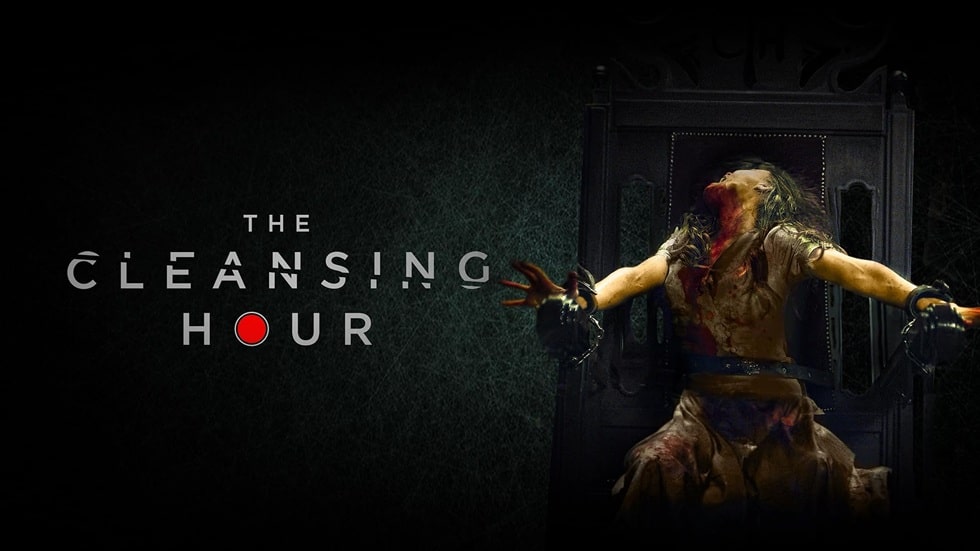 The Cleansing Hour (Shudder, September 16, 2019)
The Cleansing Hour (2019) – Prime
The Cleansing Hour (Shudder, September 16, 2019)
The Cleansing Hour (2019) – Prime
I vaguely recall hearing good things about this one being a decent balance of horror and humor, and they were right. It’s a blast, annoyingly enjoyable, and I don’t like how this marathon is changing my mind about possession flicks.
‘Father Max’ is the onscreen talent of a hoax exorcism streaming show called The Cleansing Hour. Max, along with his best friend Drew are failed priests, and now they are fleecing their online flock with fake demonstrations and chintzy ‘Vatican-approved’ merchandise.
When circumstances dictate that Drew’s fiancé, Lane, must step in and pretend to be the possessed subject, things very quickly escalate as the men realize they are dealing with a real demon, and everything quite literally goes to hell.
As with many of these films, the ‘priests’ have to come to terms with their own failings in order to save the ones they love, and the whole violent and sordid affair is streamed live to an ever-increasing audience that has no useful suggestions.
The online backdrop works really well here, and its worth pausing now and then to read the hilarious (and disturbing) comments being made — an accurate indicator of online discourse today.
The leads were all excellent, the effects were goopy and horrific and the film zipped along to a glorious finale with nary an ounce of fat.
Recommended. 9/10
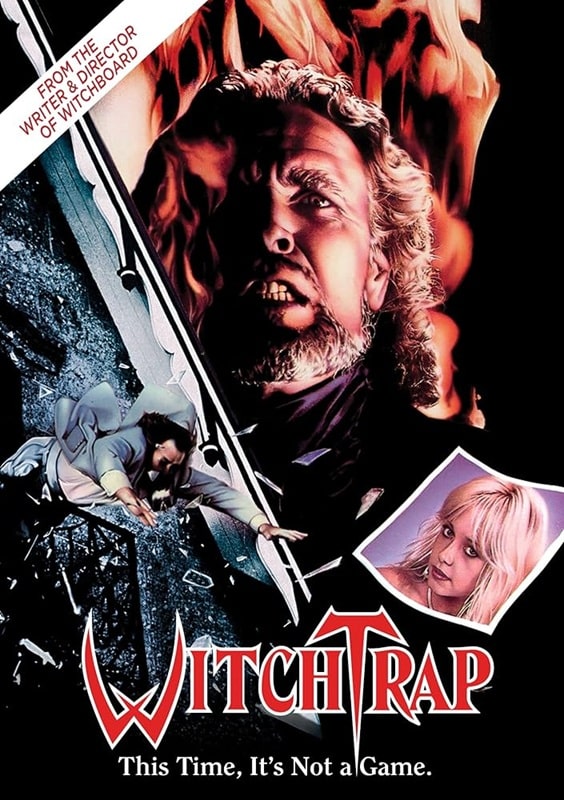
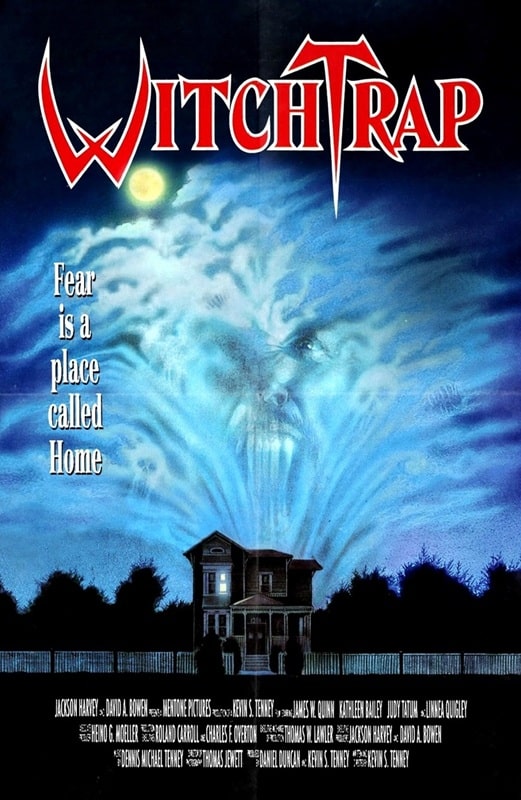
Witchtrap (Cinema Plus, September 7, 1989)
I realize that most of us think back fondly on the 80s as the golden age of horror, but it’s also worth remembering how much rubbish was also produced. Case in point, Witchtrap.
From the director of Witchboard, hoping to repeat his success, this one lands on the ‘so bad it’s good’ list with a clunk, but is it good? Is it?
A team of mediums, along with the worst security group ever, are trying to rid an old house of a demonic spirit so that it can be opened as a B&B. The spirit is a hairy demonologist, who has managed to hide his heart or something. We don’t care, we are here for the kills.
Sadly, these are a bit lackluster, and the only one that approaches the giddy heights of 80s foam rubber fun happens quite early on. Fan fave Linnea Quigley appears for about 15 mins before being offed, but at least she dies how she would have wanted; stabbed in the neck with a shower head while naked.
The only areas of note are how truly awful the dialogue is, and how horrendous some of the acting is. It’s hard to describe, but if you’ve seen it you’ll know what I’m talking about.
The film rips off every other possession film at the time, as well as Ghostbusters and, well just take a look at the bonus on the right poster above.
Avoid if you are sensible, recommended if you are daft like me. 4/10
Previous Murkey Movie surveys from Neil Baker include:
Fan of the Cave Bear
There, Wolves
What a Croc
Prehistrionics
Jumping the Shark
Alien Overlords
Biggus Footus
I Like Big Bugs and I Cannot Lie
The Weird, Weird West
Warrior Women Watch-a-thon
Neil Baker’s last article for us was Fan of the Cave Bear. Neil spends his days watching dodgy movies, most of them terrible, in the hope that you might be inspired to watch them too. He is often asked why he doesn’t watch ‘proper’ films, and he honestly doesn’t have a good answer. He is an author, illustrator, outdoor educator and owner of April Moon Books (AprilMoonBooks.com).
We Are Missing Important Science Fiction Books


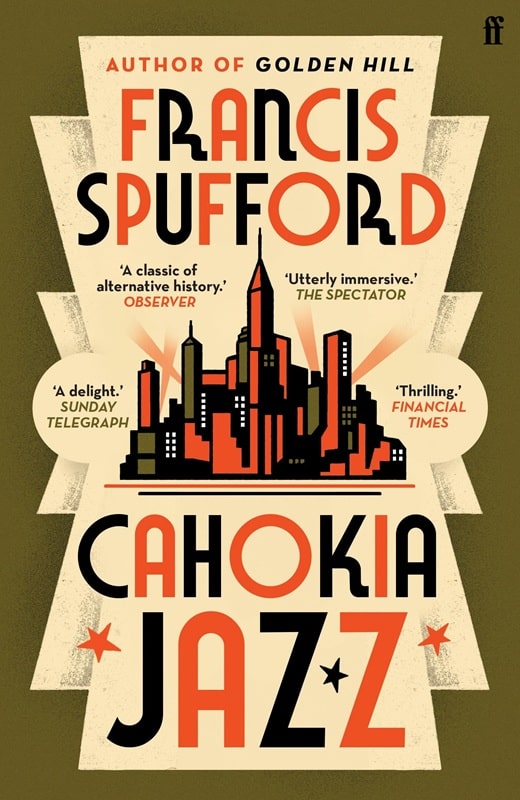
Bewilderment by Richard Powers (W. W. Norton, November 1, 2022); Orbital by Samantha Harvey
(Grove Press, October 29, 2024), and Cahokia Jazz by Francis Spufford (Faber & Faber, April 4, 2024)
I just finished Richard Powers’ Bewilderment, from 2021. It’s a really intriguing and powerful novel, that I argued with at times, but still loved. It’s got a great ending, tremendously moving.
And it is absolutely science fiction. Way more so than most SF books these days, even hard SF. But, somehow, it didn’t even get a sniff at either the Nebula or Hugo shortlist.
Mind you, I didn’t read it until now, so I’m part of the problem. And, to be fair, both Ian Mond and Paul di Filippo reviewed it for Locus, so it wasn’t ignored.
The Nebula that year went to The Master of Djinn, and the Hugo to A Desolation Called Peace. Both are fine books, and A Desolation Called Peace is science fiction. But they are not at the level of Bewilderment.
We — the SF community — are missing important SF books. We missed Orbital, a Booker winner. (Bewilderment made the Booker shortlist.) We may be missing Cahokia Jazz.
I think we need to come to terms with the fact that writers who are not part of our “SF community”, if you will, are doing some great science fiction anyway.
Rich Horton’s last article for us was a review of The New Atlantis, edited by Robert Silverberg. His website is Strange at Ecbatan. Rich has written over 200 articles for Black Gate, see them all here.
The Sword & Planet Tales of Ralph Milne Farley
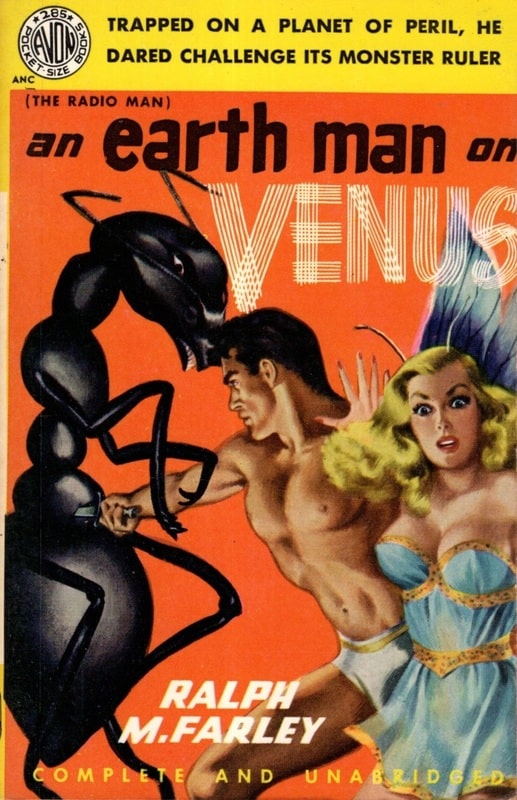
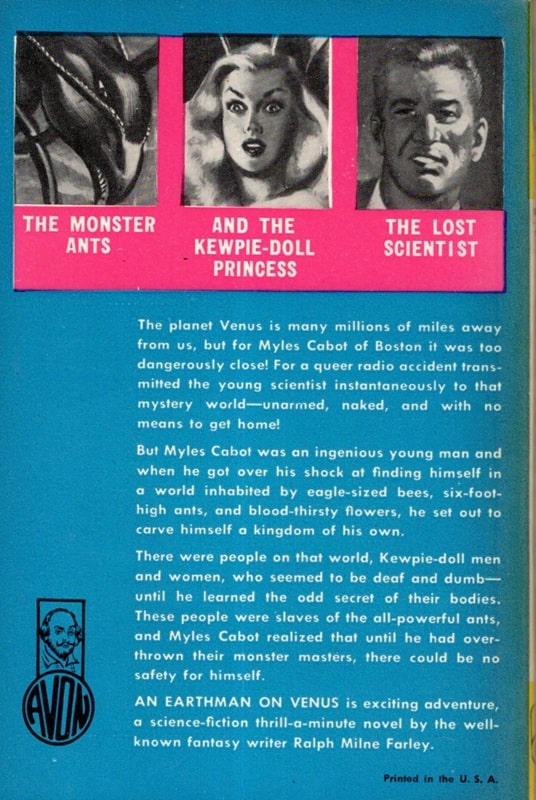
An Earthman on Venus (Avon, 1950). Cover by Raymond Johnson
Ralph Milne Farley (1887 – 1963) was a pseudonym for Roger Sherman Hoar. Hoar was a Massachusetts senator and an attorney general, so I can understand his use of a pseudonym to write his SF stories under, but I can’t imagine why he’d choose one just as long and awkward as his real name, and even less memorable.
At any rate, Farley was friends with Edgar Rice Burroughs and wrote his own series of Sword & Planet adventures sometimes called the Radio series, since most of the books featured the term radio in their titles.
[Click the images for non antmen-sized versions.]
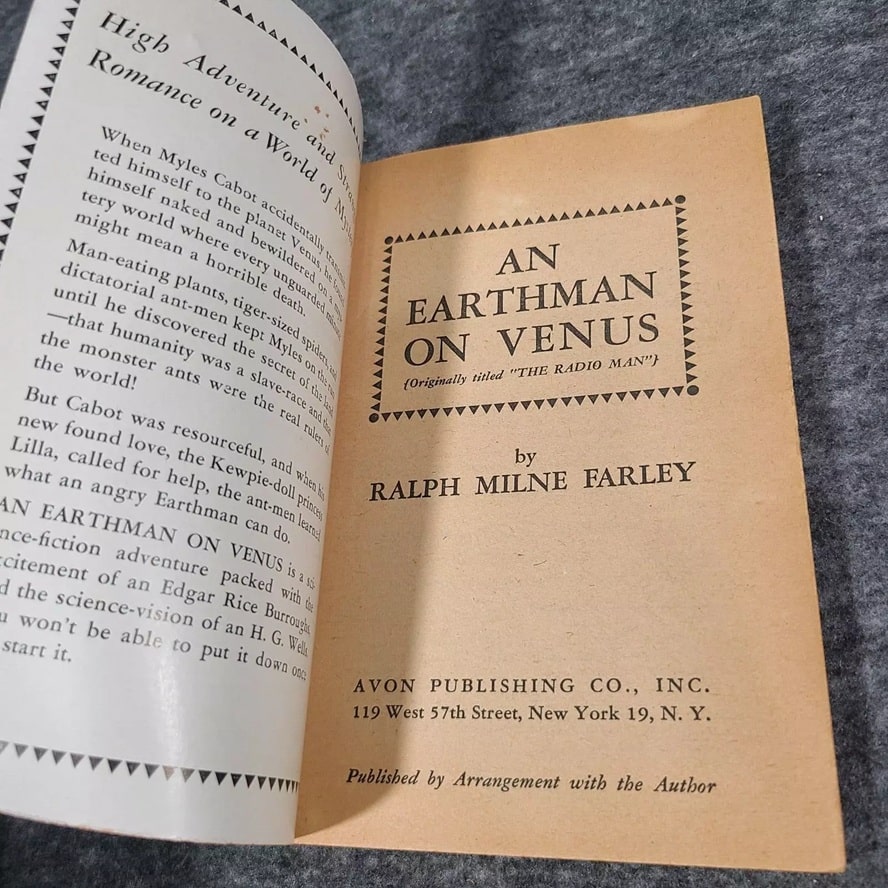 Inside cover of An Earthman on Venus
Inside cover of An Earthman on Venus
As far as I can see, there are about ten titles in this series, but I’ve only read the first two (covers shown above and below):
The Radio Man (or An Earthman on Venus): Avon Books, (Raymond Johnson cover), 1924/1950
The Radio Beasts: Ace Books, (Ed Emshwiller cover), 1925/1964
In The Radio Man, an Earth scientist named Myles Cabot invents a transmission device that uses radio and accidentally transmits himself to Venus, where he finds human-like beings — including a princess — who are enslaved by intelligent, horse-sized ants who use radio waves for communication. Cabot uses his technical know how to create guns for the humans and leads a revolt.
The story was inventive and fun but without nearly as much action and derring-do as ERB’s John Carter stories.

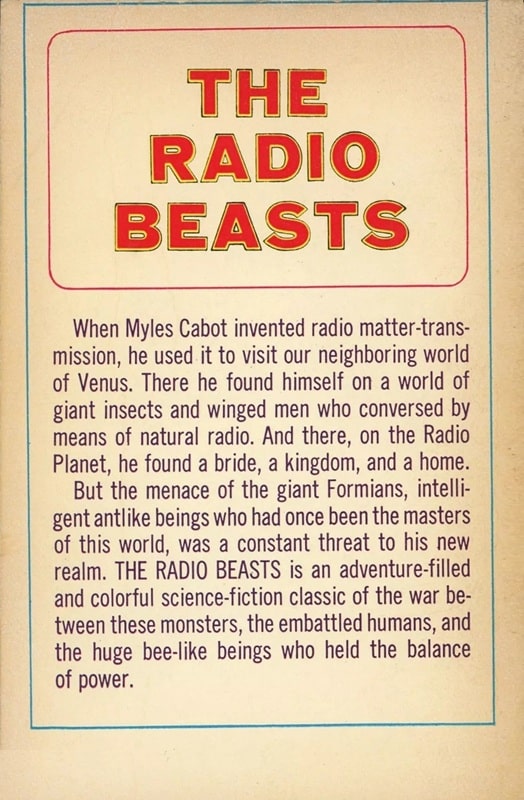
The Radio Beasts (Ace Books, February 7, 1964). Cover by Ed Emshwiller
The sequel, The Radio Beasts, was also readable but didn’t seem to add much to the overall story, and the writing doesn’t have the flair and color of ERB.
I don’t, at present, have any intention of reading the rest of the volumes, which — as far as I’m aware — consist of:
The Radio Planet
The Radio Flyers
The Radio Gun-Runners
The Golden Planet
The Radio Menace
The Radio Man Returns
The Radio Minds of Mars
The Radio War
Charles Gramlich administers The Swords & Planet League group on Facebook, where this post first appeared. His last article for Black Gate was Of Men, Monsters, and Little People.
The Beating Heart of Science Fiction: Poul Anderson and Tau Zero
 Tau Zero (Millennium/Gollancz SF Masterworks, February 2006). Cover by Dominic Harman
Tau Zero (Millennium/Gollancz SF Masterworks, February 2006). Cover by Dominic Harman
Science fiction — what is it, really? What elements place a story firmly in the genre? For any requirement that you can think of, there is probably a great sf story that violates it, and rather than cobble together some dictionary-ready definition, it’s easier to just think of particular books that you would hand to someone unacquainted with the genre with the words, “Here — read this; this is science fiction!”
Everyone would have their own choices for such a list, of course, and those choices would amount to your de facto definition. For me, some of those books would be Rendezvous with Rama by Arthur C. Clarke, The Stars My Destination by Alfred Bester, and Man Plus by Frederik Pohl, but the very first book on my list would be Poul Anderson’s 1970 novel Tau Zero. Why? What does this book have that makes it a quintessential work of science fiction?
Maybe it’s this — it’s a grand voyage, a brave excursion into the great out there, and it also has a grand perspective shift, like a camera pulling back in a movie, a maneuver that radically alters everything that you had previously thought about the story, something that’s not a minor adjustment, but a move that completely explodes the frame. You think the story is this, but it’s really that, you think you’re here, but you’re really there; the here where you thought you were turns out to be the tiniest corner of there, a there that is larger and stranger and more dizzying than you ever could have originally imagined. (In The Encyclopedia of Science Fiction, Peter Nicholls calls this kind of maneuver a “conceptual breakthrough.”)
Tau Zero begins as a straightforward story of an interstellar voyage, but it ends as far away from that prosaic beginning (prosaic by the standards of science fiction, I mean) as it is possible to imagine. Farther than that, really, and I think that’s the whole point.
Sometime in the 23rd century, the colonization ship Leonora Christine sets out from earth for a planet thirty light-years away. Unlike many stories of this type, the voyage isn’t prompted by the world coming apart at the seams; generally, things are going quite well, which is largely due to the people of the planet submitting to a global government run exclusively by… Scandinavians. Everyone just handed the reigns to the Nordic folk because of their universally acknowledged rationality, efficiency, impartiality, and lack of any pesky Will to Power. I know, I know — send any complaints to that son of Denmark, Poul Anderson. I guess he figured he would inoculate his readers against all the wildness to come by giving them the nuttiest thing first.
If the interstellar colonization mission is a stock situation, Anderson peoples it with characters that are themselves mostly recognizable types. The Leonora Christine’s Captain is Lars Telander, a solid, stolid, stoic father figure who seems ideal at the beginning of the journey, but who fades (if not wilts) into the background under the stresses of the voyage and the extraordinary emergency that the crew eventually has to deal with. More central to the life of the ship and the story Anderson tells are First Officer Ingrid Lindgren, ultra-competent while still being sensitive and sympathetic, and the book’s real protagonist, Ship’s Constable Charles Reymont, willing to be as much of an unlikable, hard-nosed SOB as necessary in order to hold the crew together and complete the mission. Reymont’s and Lindgren’s on-again, off-again romance and their consciously embraced good cop/bad cop roles form the human core of the story.
Anderson devotes significant time to this pair and to the other crew members whom they alternately coax (Lindgren) and steamroll (Reymont) on the way to their goal. In one sense, the book is a tract on the dynamics of leadership in a uniquely stressful situation, and the author had clearly thought a lot about such problems and had some definite ideas about how to deal with them.
It has to be said, however, that Anderson’s depiction of character rarely rises above a fairly rudimentary level; there’s an off-the-rack feel to most of his people. What we have here isn’t Henry James in space, and stylistically, the book wasn’t written to dazzle; if you’re looking for graceful allusiveness, poetic imagery or memorable turns of phrase, you need to look elsewhere; Anderson’s prose generally doesn’t rise above the level of “workmanlike” (which doesn’t mean that it’s bad — it usually has the far from negligible virtues of efficiency and clarity). So, old Poul is no Nabokov in space, either.
So what? Tab A in Slot B prose and slide-rule stiff characters are hard-sf traditions that go back all the way to the vacuum-busting days of Hugo Gernsback (and Anderson’s work isn’t nearly as wooden as the stuff old Hugo published), which just means that you adjust your expectations when you read this kind of sf story. (Oh, what’s a slide rule? Google it, kid.)
In the long run, Anderson’s deficiencies are perfectly acceptable because what you read Tau Zero for is the writer’s wide-screen vision and the extraordinary crisis his people face, and what a vision! What a crisis!
The Leonora Christine powers itself by collecting hydrogen as it travels through interstellar space and using it for fusion. (Technically this makes the ship a Bussard ramjet, though Anderson never uses the term.) As such a ship can approach the speed of light but cannot exceed it, the vessel’s flight plan is to accelerate up to near light speed during the first half of its voyage and then steadily decelerate down from that halfway point until it arrives at the target planet. Because of the relativistic time dilation caused by its extreme speeds, over thirty years will pass on earth while only five years will pass on board the ship.
Initially, things go smoothly as the crew settles into the routines that will occupy them during their long journey, and as expected, people (half of the multinational, fifty-person crew are male and half are female) begin to pair off in preparation for life as colonists on their new world. Everything seems to be going according to plan, until, before reaching the midway deceleration point, the Leonora Christine collides with an unanticipated interstellar dust cloud; because of the ship’s increased mass (due to its speed) this is potentially a very serious event, more like slamming into a brick wall than strolling through a fog bank.
At first, the ship seems to come through this emergency surprisingly well, but the truth soon becomes apparent. The collision has caused irreparable damage to one vital system — the one used for deceleration. The Leonora Christine is unable to slow down.
Why is the damage irreparable? To make repairs, it would be necessary to exit the ship, but the engines generate radiation that would be instantly fatal to anyone outside the hull, and the engines cannot be shut down because they generate an electromagnetic field which is the only thing protecting the crew from the hard radiation of galactic space. (The darn thing must not have been designed by Scandinavians.)
Reymont, Lindgren and the rest are thus faced with the prospect of an endless, pointless voyage that can only conclude with their own deaths from accident, old age or despair, sealed inside something that began as a ship, turned into a prison, and can only end as a coffin. Such an appalling situation would be bad enough, but the Leonora Christine’s crew soon comes to an even grimmer realization.
Unable to decelerate, the time dilation that was to have initially separated them from their home by a mere thirty years is only growing more extreme. The stunned crew members quickly realize that it is not decades that are passing outside the ship, not centuries, not millennia, even. “Soon”, millions, and then billions of years have passed. The would-be colonists whose aim was to open a new world for people from earth to live on must now accept that earth’s sun has long since burned to a cinder, their planet has vanished, their species has become extinct. The fifty exiles on the Leonora Christine are the last human beings alive in the universe, and unless they can find a solution to their dilemma, they are the last human beings that there will ever be.
How will they respond? Panic? Madness? Suicide? Reymont and Lindgren (especially Reymont) are resolved to hold the crew together, determined that they will all continue to do their jobs in the hope (hope being one of the defining characteristics of the late, great human race) that they will eventually find some way to slow down and locate some world, somewhere, where they can make a new start and keep their species alive.
Despite being more radically alone than any human beings have ever been (at one point, someone quotes Father Mapple from Moby Dick — “for what is man that he should live out the life-time of his God?”), for the most part, the Leonora Christine’s people respond well; the extreme strain sometimes produces extreme effects, but no one commits suicide. (I suspect that Anderson knew that in such a situation, if just one person took that way out, it would likely be the effective end of everyone.)
Soon they have left, not only our own galaxy, but also the supercluster of galaxies that constitute our local “neighborhood”, in the hope of reaching a region in which radiation levels will be low enough to permit them to make their repairs. As these “empty” gulfs are completely uncharted, they are also trusting that chance (or that God whom some of them still believe that they have not outlived) will eventually bring them to a galactic group where they will find a suitable planet.
Unexpected difficulties continue to intervene, however, and by the time they are able to fix the damage and decelerate to begin their search for a new home, there is no longer any potential home to decelerate to; so much time has passed outside the ship that the expansion of the universe caused by the original Big Bang has reversed. The universe is now contracting in a “Big Crunch” in which all matter and energy are forced closer and closer together until the cosmic cycle will restart with another Big Bang.
What is there for the Leonora Christine to do but circle the cosmic seed and attempt to ride out the coming explosion and then try to find a young world to begin again on? That’s just what they are able to do, and the story that began on an old planet in an old galaxy in an old universe ends on a new planet in a new galaxy in a universe that didn’t even exist when the story began, uncounted trillions of years before.
The book closes with Charles Reymont and Ingrid Lindgren, two people who now constitute one twenty-fifth of the entire human race, standing on the soil of the home they have travelled such an inconceivable distance in time and space to reach. “Here was not New Earth”, Anderson says. “That would have been too much to expect.” But it is a place where the stubborn, resourceful, endlessly hopeful human race will be able to start anew, a place where it will have a chance to take root and flourish… and perhaps, avoid some of the mistakes that plagued it long ago in a universe that now no longer exists.
Charles Reymont, the man whose determination saved the entire human race, lightly rejects the suggestion of kingship that Ingrid Lindgren jokingly (but also not entirely unseriously) makes, and then “he laughed, and made her laugh with him, and they were merely human.”
Pardon my French (a language once spoken on the long-extinct planet earth), but… holy shit!
Tau Zero was called by James Blish the “ultimate hard science fiction novel.” It’s certainly difficult to think of one that could go beyond it; every time I finish reading it, I want take my brain out, shake it a little, massage it, and run it under a cold faucet before putting it back in my skull. It’s a book that takes your perspective and stretches it, and stretches it, and keeps on stretching it until you walk around bumping into walls because you’re so far from where you started that you have no idea where you are anymore and can’t even begin to imagine where you’re going to end up when you’re finished.
Even in the science fiction genre, there aren’t many books like that. Even a lemon-sucking, hard line anti-Campbellian anti-sentimentalist like Barry Malzberg grew positively misty whenever he talked about the book. Calling the novel “magnificent”, Malzberg rhapsodized that Tau Zero was “the only work published after 1955 that can elicit from me some of the same responses I had towards science fiction in my adolescence — a sense of timelessness, human eternity, and the order of the cosmos as reflected in the individual fate of every person who would try to measure himself against these qualities.”
This wasn’t just Malzberg indulging in nostalgia; Poul Anderson’s book, which marries a modest nuts-and-bolts style with a beyond-audacious premise, really does what Malzberg says it does, and in doing so it goes beyond the merely mind-boggling; it squares the boggle and keeps on squaring it until you’re so dizzy with infinitely expanding possibility that you have to lie flat on the floor for a while. For me, it’s the wildest, most exhilarating trip in all of science fiction.
I’m not going to return to the definitional task that I disavowed when I began this piece, but I do know that one of the things that we most want from a science fiction story is that when we finish it, we won’t end up back where we started. We want it to take us on a voyage, the kind of voyage that no other kind of writing can accomplish or even attempt.
If you want to know what kind of voyage that might be, I can do no better than to turn you over to one of the genre’s greatest voyagers, Poul Anderson, and commend to you his indeed magnificent novel, Tau Zero. When you’ve finished reading it, you might just feel — along with me — that what you’ve been holding in your hands is nothing less than the beating heart of science fiction.
Thomas Parker is a native Southern Californian and a lifelong science fiction, fantasy, and mystery fan. When not corrupting the next generation as a fourth grade teacher, he collects Roger Corman movies, Silver Age comic books, Ace doubles, and despairing looks from his wife. His last article for us was The Gorey Century
In the History of Vintage Science Fiction & Fantasy, Nothing Compares to Gnome Press
Isaac Asimov’s I, Robot and the Foundation Trilogy. Robert A. Heinlein’s Sixth Column. Arthur C. Clarke’s first three novels. The entire Conan saga from Robert E. Howard. The International Fantasy Award winner City by Clifford D. Simak. The Hugo Best Novel winner They’d Rather Be Right from Mack Clifton and Frank Riley. Books by L. Sprague de Camp and Fletcher Pratt, A. E. van Vogt, C. L. Moore and Henry Kuttner, Murray Leinster, Frederik Pohl, Jack Williamson, Andre Norton, and James Gunn.
Those would be a solid core of any collection of vintage f&sf. Yet those books and dozens of others appeared in a few years from just one small publisher: Gnome Press.
Fantasy had long been a staple of what we would now call mainstream publishing but before the 1940s American science fiction was relegated to gaudy pulp magazines, critically reviled as among the lowest forms of fiction. The superweapons that emerged from World War II, especially the atomic bomb, suddenly made the field look prescient, a look into the onrushing future.
 Windsor [ON] Star, November 2, 1946With mainstream publishers still reluctant to mine magazine back issues, fans of the genre saw a publishing niche. More than a dozen small presses sprang into mayfly-like existence before 1950.
Windsor [ON] Star, November 2, 1946With mainstream publishers still reluctant to mine magazine back issues, fans of the genre saw a publishing niche. More than a dozen small presses sprang into mayfly-like existence before 1950.
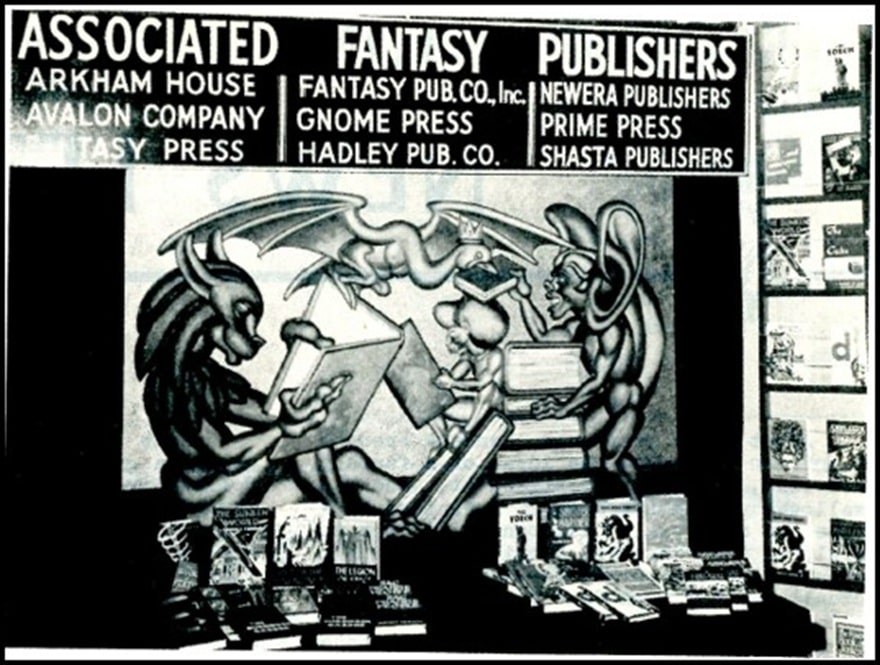 Bloomington News Letter fanzine, February 1949
Bloomington News Letter fanzine, February 1949
Gnome was founded in 1948 by two members of New York fandom, Martin Greenberg and David A. Kyle.
 The only known photo of Greenberg and Kyle together
The only known photo of Greenberg and Kyle together
Run on the proverbial shoestring, Gnome nevertheless outpublished, outsold, and outlasted all their competitors. Greenberg had a knack for making deals and Kyle did everything else, including drawing a half-dozen covers. He was soon obsoleted by young – and cheap – newcomers like Edd Cartier, Ed Emshwiller, and Frank Kelly Freas.
The firm made mistakes – could there be a worse response to the dawn of the Atomic Age than to drop three fantasies as its first three selections? – but quickly caught on to what the public wanted. Greenberg was a disciple of John W. Campbell who, whatever is thought of him today, then towered over the field as the guru editor of Astounding Science Fiction and Unknown Fantasy Fiction magazines. Whatever he touched, sold.
Greenberg used the magazines as his Comstock Lode and cannily offered to republish story series as “novels,” suiting post-war tastes if not the labeling laws. Authors flocked to Gnome’s door, desperately wanting hardback publication.
Well, that and money. Greenberg gave them only the former. He and Kyle split the proceeds fairly. Greenberg got a salary and Kyle didn’t. (Kyle always had multiple jobs and Greenberg had a family. But still.) Nevertheless, Kyle stayed six years and Gnome lasted fourteen, with Greenberg owing money to everyone in sight. He is usually described as a charming rogue with a gift of gab. Asimov once went to him demanding money and wound up lending more.
 Isaac Asimov royalty payments, auction catalog
Isaac Asimov royalty payments, auction catalog
History is never pretty. Flaws and all, nothing compares to Gnome in the history of vintage f&sf. In many ways, it is the history of vintage f&sf.
I knew nothing about Gnome when I chanced upon several titles in a used bookstore in 1980. I had seen the name in passing, but histories of the small presses were nonexistent. I found a list of all 86 titles, and dove in. A few decades later I had them all. Did I stop there? What fun would that be? Gnome produced about 75 variants, with different boards or different jackets. Nobody knows exactly how many, because new ones keep popping up. Finding all of them is essentially impossible, which means the search never has to end – the perfect collectible.
Moreover, Gnome published a variety of ephemera, from newsletters to catalogs to calendars and I set out to accumulate all that appeared on the market. I even bought the 1951 Fantasy Calendar, which was an unparalleled achievement since it doesn’t exist. (Blame Donald Wollheim.)
Digging for information is infinitely easier today than in 1980, yet Gnome appears to have left virtually no paper trail, an oddity for a publisher dealing every day with paper. Other than a few scraps at Syracuse University, no business records seem to have survived and not even the indefatigable Kyle bothered to talk much about his time at Gnome in the millions of words he wrote for fanzines.
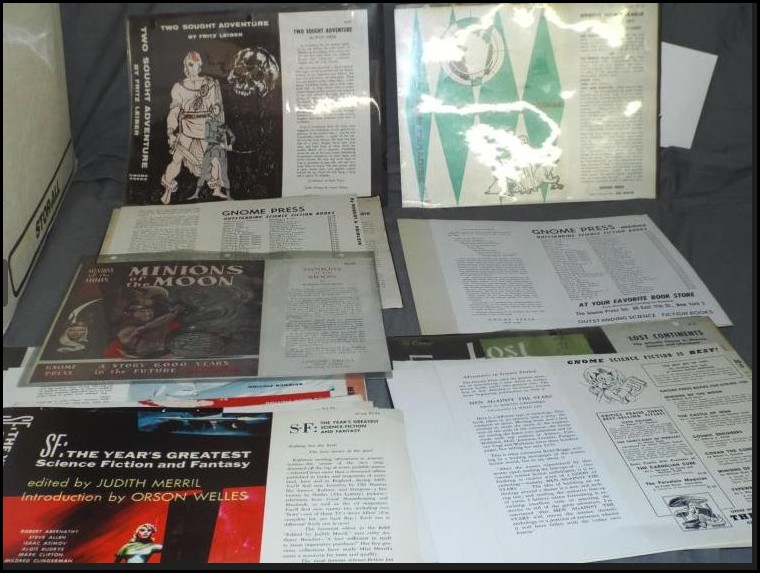 Gnome cover proofs, auction catalog
Gnome cover proofs, auction catalog
Nevertheless, dogged digging over decades created a repository of everything known about Gnome. Near archaeological level scrutiny of covers, flaps, copyright pages, and back panels yielded a history of each title. Each answered question led to ten additional mysteries. Eventually I wrote an utterly unpublishable 660-page manuscript dump that would require more than a thousand images to elucidate the text.
What’s 150,000 words and 1100 images to the internet? I already owned the URL GnomePress.com. The 113 pages there now comprise the first complete bibliography of Gnome Press (by author, title, and publication date), a separate page for each title with color scans of every variant board and cover I own along with contemporary reviews and previously unknown photos of the more obscure authors, information about a range of associational items, and histories both of Gnome and the f&sf field up to the time of its founding.
For all its literally exhausting coverage, the site remains a work in progress. Gnome collectors continue to provide information that require revision to opinions I previously thought firm. If anyone reading this has even the slightest scrap they want to share, please contact me. Or just ask questions about Gnome. Anything, except how much a book is worth.
By the way, Marty Greenberg’s file copy of I, Robot inscribed to him by Asimov is listed on the internet at $50,000. If you’re the buyer, please contact me. I want to know all about you.
Steve Carper is the author of hundreds of articles on fascinating, if obscure and forgotten, tidbits of history, as well as the seminal book Robots In American Popular Culture. All of his websites are linked at SteveCarper.com.
’24? in 42′ with…Bob Byrne????
Jason Waltz kicked off season two of his 24? in 42 podcast interviews with your very own Monday morning columnist. The prior installment was with Malazan’s Ian C. Esslemont, so I’m in pretty good company here.
It should not surprise you that I was all over the place, covering Robert E. Howard, Michael Moorcock, Columbo, books on writing and screenwriting, Encyclopedia Brown, the Civil War, Tolkien, The Constitutional Convention of 1787, Lawrence Block, Steven Hockensmith, Norbert Davis, and much more.
Jason sends sixteen questions ahead of time, and mixes in eight ‘new’ ones that can be definite curveballs. He started things off with a knuckleball! (Last week’s post was on baseball- I’m still in the mood)
Here are two sample questions:
Who is the visual artist(s) that creates the artwork that most moves you?Michael Whelan and Walter Velez (those terrific early Thieves World cover novels) are two of my favorite fantasy artists. Being a mystery guy, I LOVE some color paintings that Robert Fawcett did. Arthur Conan Doyle’s son Adrian (who waas a freeloading ass), co-wrote some Holmes stories. They’re not bad. All but the first appeared in Colliers’ illustrated by Fawcett. They are wonderful illustrations. Up there with the two great Holmes artists: Frederic Dorr Steele, and Sidney Paget. I find they capture Holmes.
How do you give depth to a character? Do you treat primary, secondary, and tertiary characters any differently?I consciously try to catch myself using a secondary or tertiary character as an info dump. Even a small one (and I absolutely do that). If the only reason I find them around is to give some info, I rework them. Or, try to use someone already in the story. There’s no depth to an info dump character.
The depth of a half dozen characters in the first Max Latin story (Watch Me Kill You) is about as well done as any story I’ve read. I try to give some personality, without making it a cliché.
Jason and I had a lot of fun, and you can actually see the enthusiasm that I bring to my blogging here at Black Gate. Settle in and watch (or at least listen) to me wax/ramble on. The 42 (from Douglas Adams’ Hitchhiker’s Guide) is the time target. Since I went over by about 35 minutes, I expanded on things a bit…
(42 is also Jackie Robinson’s number, and I talked about him for one question).
And for the record, since Jason called me out on camera: Ohio State defeated Texas in the CFP that night. In quite dramatic fashion, no less.
Click on over. I’m told I was a bit animated!

Bob Byrne’s ‘A (Black) Gat in the Hand’ made its Black Gate debut in 2018 and has returned every summer since.
His ‘The Public Life of Sherlock Holmes’ column ran every Monday morning at Black Gate from March, 2014 through March, 2017. And he irregularly posts on Rex Stout’s gargantuan detective in ‘Nero Wolfe’s Brownstone.’ He is a member of the Praed Street Irregulars, founded www.SolarPons.com (the only website dedicated to the ‘Sherlock Holmes of Praed Street’).
He organized Black Gate’s award-nominated ‘Discovering Robert E. Howard’ series, as well as the award-winning ‘Hither Came Conan’ series. Which is now part of THE Definitive guide to Conan. He also organized 2023’s ‘Talking Tolkien.’
He has contributed stories to The MX Book of New Sherlock Holmes Stories — Parts III, IV, V, VI, XXI, and XXXIII.
He has written introductions for Steeger Books, and appeared in several magazines, including Black Mask, Sherlock Holmes Mystery Magazine, The Strand Magazine, and Sherlock Magazine.
New Adventures for the World’s Favorite Barbarian
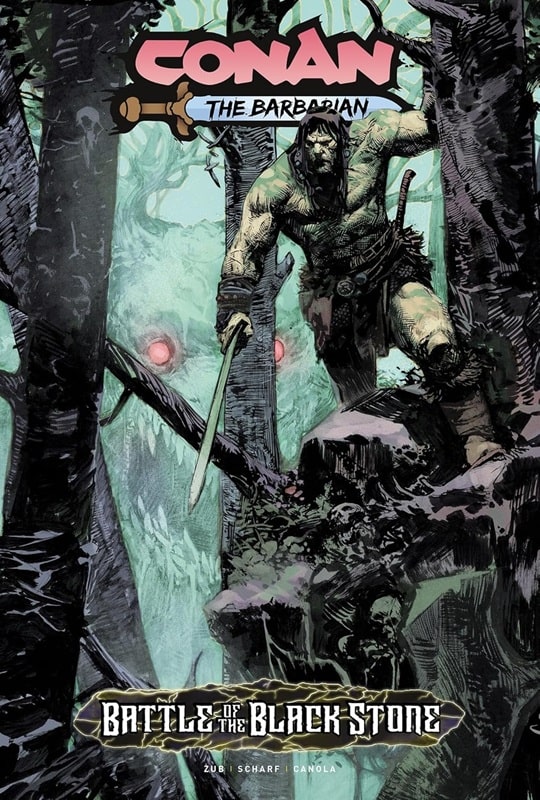 Conan the Barbarian: Battle of The Black Stone (Titan Comics collected edition, April 1, 2025). Cover by Jonas Scharf
Conan the Barbarian: Battle of The Black Stone (Titan Comics collected edition, April 1, 2025). Cover by Jonas Scharf
Few things are more ubiquitous than Conan and fantasy. Decades of sword-swinging high adventure has earned the barbarian a following most can only dream of. It’s taken the heavily thewed warrior to the big screen, Marvel Comics, and more. But it’s his latest adventure at Titan Comics that may prove to be the icing on the proverbial Shadizarian cake.
“This isn’t my first time writing Conan, but it’s definitely the most expansive opportunity I’ve ever had to chart the direction of such an amazing iconic character. I could not be happier in terms of our team and the collaboration we have in terms of story, art, and worldbuilding,” Jim Zub, writer of Conan the Barbarian at Titan Comics, shared by email.
[Click the images for Conan-sized versions.]
Over the years, few have come to understand the Cimmerian like the acclaimed Canadian scribe. Even in a career that has taken him to the heights of the comic book industry, Zub’s Conan work is special. His bibliography reads like a tour of the barbarian’s finest adventures of the past 10 years: Marvel’s Conan the Barbarian, The Savage Sword of Conan, and the epic Battle of the Black Stone are a few highlights. No wonder he’s so trusted by the rights holders of Robert E. Howard’s work.
“I actually work directly for Heroic Signatures, the rights holders of Conan and the Robert E. Howard character library. Titan publishes the comics in English, and they’ve been great publishing partners, but on a creative level I answer directly to the people who know Conan best and that has made the creative process really vibrant,” Zub stated.
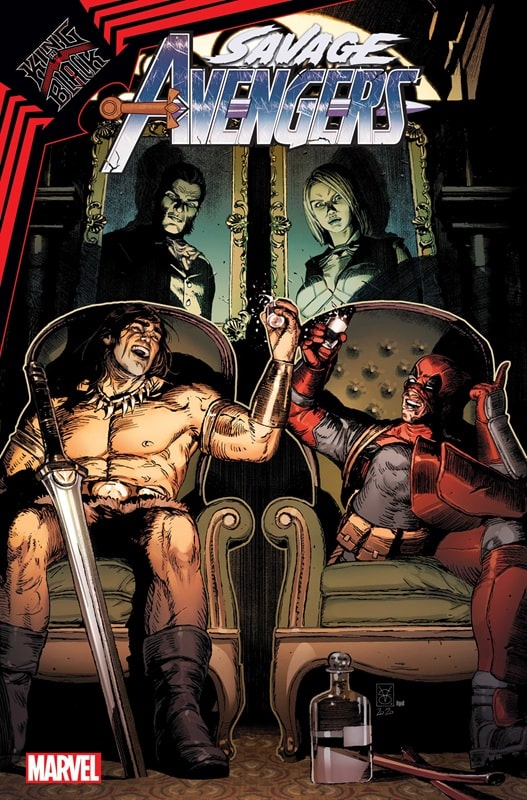 Conan and Deadpool in Savage Avengers #18, by Gerry Duggan and Kev Walker (Marvel Comics, February 17, 2021). Cover by Valerio Giangiordano
Conan and Deadpool in Savage Avengers #18, by Gerry Duggan and Kev Walker (Marvel Comics, February 17, 2021). Cover by Valerio Giangiordano
It wouldn’t be exactly fair to call Conan’s return to Titan a comeback. At Marvel, the Cimmerian had an impressive run in the much-loved Savage Avengers. Solo, he would be well-treated by Zub and his colleagues in stories like Conan: Serpent War and even fight symbiotes during the massive King in Black storyline. A look at the enthusiasm that has greeted Titan’s Conan series, however, tells you that this is something different.
Zub added, “Every time I get to contribute to characters and worlds I grew up with it’s a thrill, and this Conan publishing initiative is a whole new level.”
Such big breaks come with a heavy responsibility. After Howard created the character in the 1930s, many other writers would pen new tales for the Cimmerian. That lengthy list of scribes includes respected names like L. Sprague de Camp, Karl Edward Wagner, Roy Thomas, and Jason Aaron. How has he managed to stand out while writing a legacy character that has passed through so many legendary hands? Surprisingly, it’s by following the legends as closely as he can.
 Conan: Serpent War #1, written by Jim Zub (Marvel Comics, December 4, 2019). Incentive variant cover E by David Finch
Conan: Serpent War #1, written by Jim Zub (Marvel Comics, December 4, 2019). Incentive variant cover E by David Finch
“If anything, I’m trying to hew as closely to Robert E. Howard’s original pulp characteristics as I can, while also incorporating the most iconic aspects of Roy Thomas’ seminal comic writing alongside the vision so many incredible artists like Frank Frazetta, Barry Windsor-Smith, John Buscema, Joe Jusko, Cary Nord and others have brought into it over the decades,” Zub explained.
Following in those footsteps brings with it plenty of challenges and opportunities. There aren’t many writers that understand that as well as Zub.
“The longer a character has been around, obviously, the more stories have been told and the harder it can be to surprise the existing fanbase while still staying true to who that character is. It’s a delicate balance where you want to keep core elements in mind but not close yourself off to new ideas,” Zub said. “The upside, of course, is the fact that legacy characters have that built-in recognition. I’m not building from scratch in terms of visibility and there’s an existing fanbase excited to see what comes next. The challenges and benefits are tightly wound together.”
You only need to read the massive Conan: Battle of the Black Stone limited series to see that approach in practice.
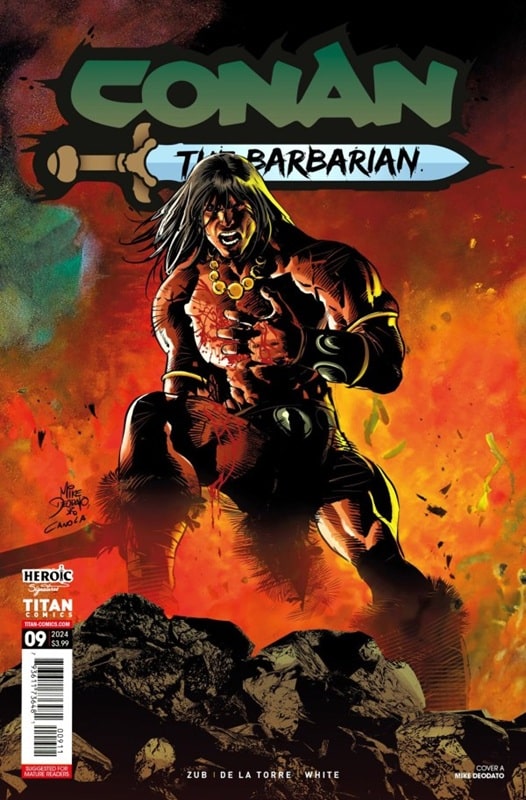 Conan the Barbarian #9, written by Jim Zub; art by Robert De La Torre and Dean White (Titan Comics, March 27, 2024)
A Walk With Titan
Conan the Barbarian #9, written by Jim Zub; art by Robert De La Torre and Dean White (Titan Comics, March 27, 2024)
A Walk With Titan
If one word could describe what it is like to read Titan Comics Conan the Barbarian, that word would be ‘fun.’ Not that it shortchanges readers on the artistic or deeper side of things. Far from it. The colors pop like a 70s comic, there’s no shortage of poetic allusions, well-crafted narrations, and action. But above all its bursting with creative energy, like a room of Conan’s most talented fans were allowed to cut loose.
“The new Titan series is a Mature Readers book, so we don’t have to hold back on violence or salacious elements where appropriate. That allows us to channel the intensity of the pulp source material even more closely,” is how Zub describes it.
Fans of high-fantasy and the barbarian’s sword-swinging antics will not be disappointed. Conan is at his most lethal in many of these stories, battling Picts and challenging sorcerers with his usual bravado. The ingredients of great sword and sorcery tales are all there: magic, romance, and plenty of mayhem.
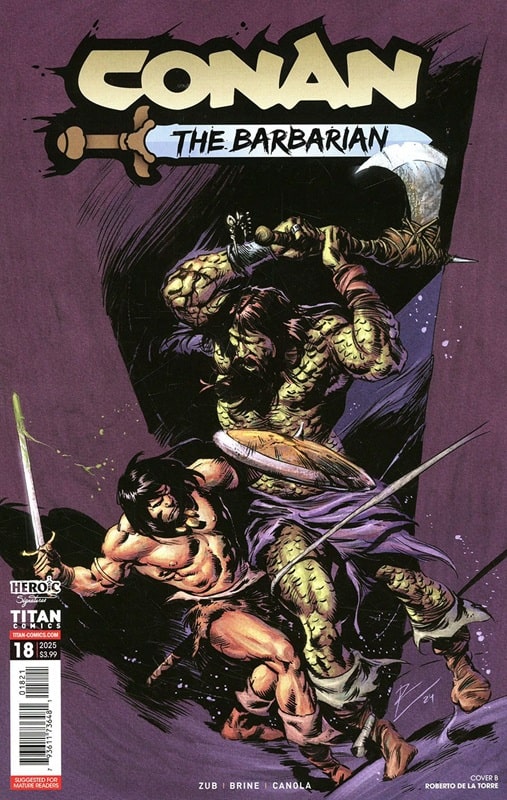 Conan the Barbarian #18, written by Jim Zub; art by Danica Brine and Joao Canola (Titan Comics, February 19, 2025). Cover B by De La Torre
Conan the Barbarian #18, written by Jim Zub; art by Danica Brine and Joao Canola (Titan Comics, February 19, 2025). Cover B by De La Torre
“It’s about distilling the best parts of past works and bringing them together with Howard’s own expansive mythmaking across the ages to tell epic stories of sword & sorcery. If I do my job well, it should feel “true” to old and new readers without falling back on adapting previous stories,” Zub said.
True to their epic vision, the creative team behind the series has not stopped at just celebrating the Hyborian Age. While the comics are full of respectful nods to the past, they also give Conan plenty of new obstacles to overcome. Other Howard characters are brought in and before you know it, a sprawling multi-timeline adventure is unfolding. Working on Conan, in general, has helped Zub level-up as a writer and his Titan Comics storylines feel like years of hard-work distilled for our reading pleasure.
“With each new storyline I’m pushing myself to use familiar pieces in unorthodox ways so that readers can see enough of the familiar to know that it’s still Conan, but knot know exactly which way the story is headed,” Zub said.
His evocative narrations have become integral to the experience. They set the tone, heighten the drama when necessary, and add some appreciated literary flair. It is no accident either that they read so quintessentially Conan.
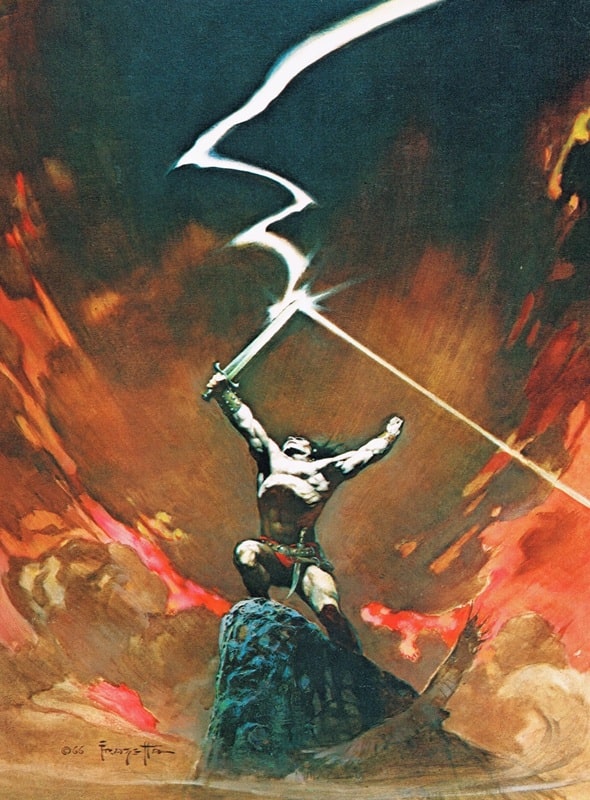 Classic barbarian art by Frank Frazetta: the cover to Thongor Against the Gods by Lin Carter (Paperback Library, November 1967)
Classic barbarian art by Frank Frazetta: the cover to Thongor Against the Gods by Lin Carter (Paperback Library, November 1967)
“I’ve marinated in the original Howard prose and analyzed it for cadence and vocabulary to make my narration feel like the classics without just copying it word-for-word. It’s made me think deeper about pacing, prose, characterization, geography, and culture,” Zub said.
The Battle for the Black Stone storyline has been a wild ride to say the least. While it’s impossible say where Conan is heading next, Zub’s work has left creatives of every level with plenty to learn from.
“There’s a reason why characters like Conan have stood the test of time and it’s crucial for people working on the property to understand and respect that bedrock foundation even while they bring their new ideas into the mix. Longtime fans can always tell if someone has done the research and cares about what they’re working on and, if you can win them over, it’s easier to build a strong audience from there,” Zub stated.
Ismail D. Soldan is an author, journalist, and poet. His work has previously appeared in Illustrated Worlds, LatineLit, and The Acentos Review among other publications. A proud explorer of both real and imagined worlds, his most recently published short story can be read in the January 2025 issue of Crimson Quill Quarterly, and his last article for Black Gate was An Eternal Champion’s Legacy.
Fan of the Cave Bear
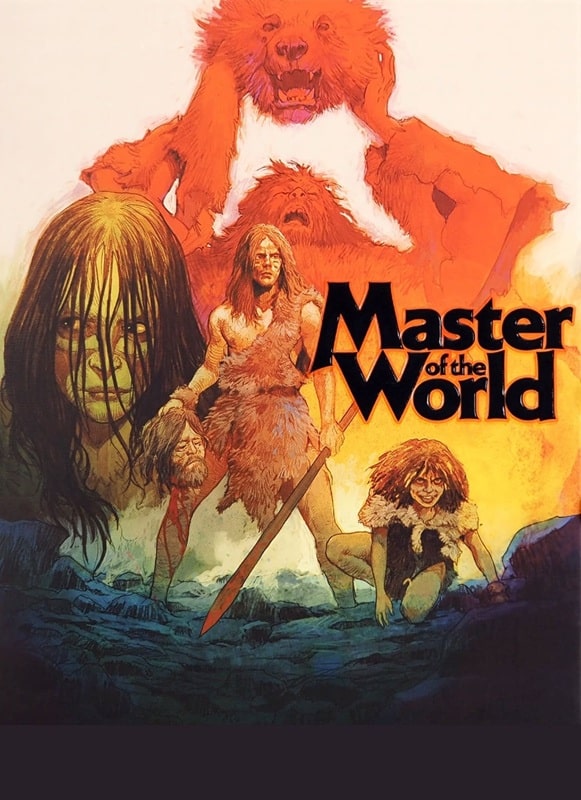 Master of the World (Falco Film, 1983)
Master of the World (Falco Film, 1983)
As usual, 20 films, all free to stream, and I’ve never seen them before. Can I really find 20 cave person films I can sit through?
EDIT: No. I’ve expanded the list to include any and all primitive cultures as there are not enough prehistoric flicks to watch.
EDIT: I’m capping this list at 10 – I can’t stomach any more f**king Italian cannibal flicks.
Master of the World (1983) TubiAgainst my better judgement, I’m starting a new list. The usual rules apply — 20 films, free to stream, based on a theme. This time, cave folk!
We kick off with this Italian offering from the early 80’s, obviously inspired by Quest for Fire and, um, possibly Caveman. It’s the old story of forbidden love, rival clans beating each other up and eating the brains of the vanquished, plus the invention of the bolas. It’s the Romeo and Juliet adaptation you never knew you needed.
The whole shebang is peppered with grainy stock footage of out-of-place animals and clouds, and there’s a man in a bear suit intercut with a real, heavily drugged bear, who beats the crap out of everyone. Actually, this semi-fake bear was a highlight.
As any nerd worth their salt will tell you, Ben Burtt used the sounds of a bear to create Chewbacca’s guttural growls. I swear to God, the filmmakers just took soundbites of Chewbacca from Star Wars and dubbed their own bear with them. Check it out — validate me!
Ultimately, a rather tedious affair, too much high-pitched grunting. I’m only one film in, and already regretting this.
3/10
 Cannibal Women in the Avocado Jungle of Death (Paramount Home Video, 1989)
Cannibal Women in the Avocado Jungle of Death (1989) Tubi
Cannibal Women in the Avocado Jungle of Death (Paramount Home Video, 1989)
Cannibal Women in the Avocado Jungle of Death (1989) Tubi
Confession: I could only find about a half dozen prehistoric cave people flicks (that I hadn’t seen or are free to stream), so I have expanded the parameters to include any ‘primitive’ cultures or groups. This opens up the doors for a wider selection, and a lot more rubbish. Case in point…
I thought I had seen this, but I was probably confusing it with Amazon Women on the Moon — anyhoo, this is a weird little affair, very cheaply made, and a bit of a mess. I’ve seen it described as a comedy horror, but there’s no horror in it, and very little in the way of good comedy. The script, written by director J.F. Lawton (who wrote Pretty Woman and Under Siege!) is really not as funny as he thinks it is, flip-flopping between absurdist schtick in the Airplane vein, to satirical monologues — all of which outstay their welcome very quickly.
Shannon Tweed is perfectly fine as the lead, but Adrienne Barbeau is wasted, and the least said about Bill Maher the better (although he does nail a couple of pratfalls). The film claims to be a commentary on feminism and toxic masculinity, but neither theme is realised due the reliance on tired tropes (the male gaze, the white male savior). Oh well.
4/10
 The Slime People (Donald J. Hansen Enterprises, 1963)
The Slime People (1963) Prime
The Slime People (Donald J. Hansen Enterprises, 1963)
The Slime People (1963) Prime
A primitive prehistoric race rises from the sewers to reclaim the planet after some misguided nuclear testing? Yes, this fits the criteria.
Is it any good though? Weeeellll…
It starts off pretty well. A lone pilot flies into a California airport, only to find the entire town deserted. It’s well set up, and would be even more effective if the film hadn’t shown us the titular monsters as soon as the film starts, before the credits. The monsters themselves are quite interesting, however it looks like they blew the budget on three full-size costumes; think Dr. Who‘s Zygons wearing gorilla pants.
The rest of the ensemble is made up of the usual suspects: lantern-jawed Clark Gable-lite, useless scientist, useless scientist’s useless daughters, useless marine (only there to say ‘gee whiz’ and kiss a useless daughter) and a nutcase who has ‘uncomfortable feelings’ for his goat. You read that right.
The whole affair is shrouded in fog (a major plot point) as mostly consists of lots of talking and running through the afore-mentioned fog. It’s a bit rubbish, but strangely compelling.
5/10
 Jungle Holocaust (Erre Cinematografica, 1977)
Jungle Holocaust (1977) Tubi
Jungle Holocaust (Erre Cinematografica, 1977)
Jungle Holocaust (1977) Tubi
Of all the horror sub-genres, jungle cannibal ones are my least favourite. There’s simply no joy to be found in any of them, and combine them with the Italian predilection for animal cruelty, and you’ve got a film I never need to see twice. This one is the first foray into the genre by the much lauded Ruggero Deodato, and it’s not as ghastly as his later offerings, but still enough to leave me questioning my life choices. I can deal with the human-on-human buffets, but the suffering of real animals turns my stomach.
Anyhoo — it’s the usual plot; white Italians enter the jungle, get eaten. Along the way there is stock footage of animals eating each other, ants in wounds, copious willy tugging (some bad, some good) and lots of ‘oo, oo, oo’ ‘aah, aah, aah’.
The leads are pretty good, Massimo Foschi really sells the whole jungle madness look, and Me Me Lai is great as the loveliest cannibal of them all. However, at the end of the day I don’t mean to be judgemental, but I have no idea how anyone can watch these for a good time.
6/10
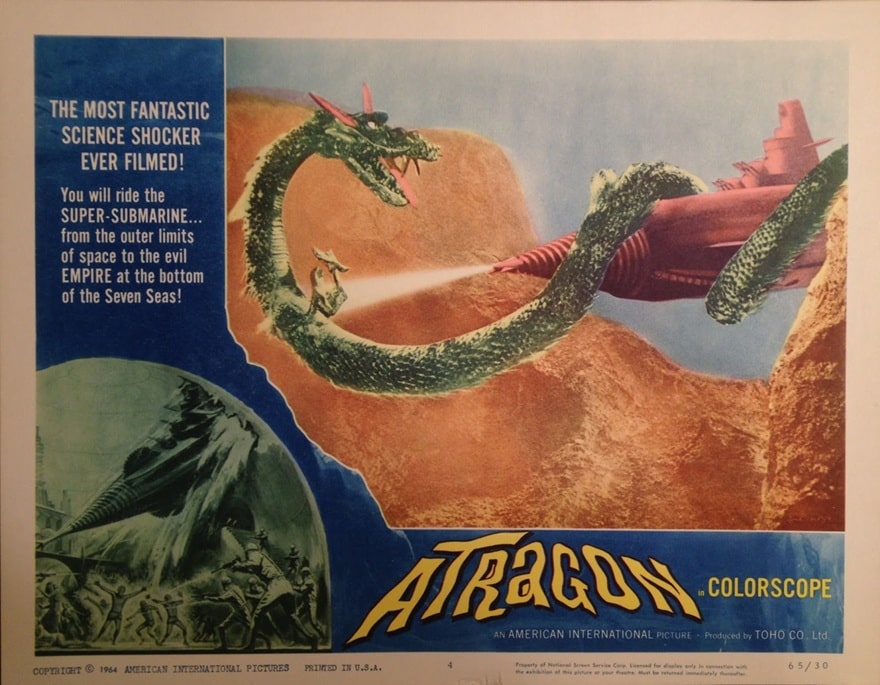 Atragon (Toho, December 22, 1963)
Atragon (1963) Prime
Atragon (Toho, December 22, 1963)
Atragon (1963) Prime
A tenuous fit for this project, Atragon features an ancient civilization (the Empire of Mu) hellbent on reclaiming their position as rulers of the world. For now, their continent lays at the bottom of the Pacific, so the film is all about Japan’s experimental submarine program, patriotism, and nefarious agents.
The entire world rallies via stock footage as the Mu Nemo themselves around the globe, sinking ships and being a general nuisance. Lots of lovely matte paintings and Thunderbirds-style models, and a bonus sea monster at the end. I had fun.
6/10
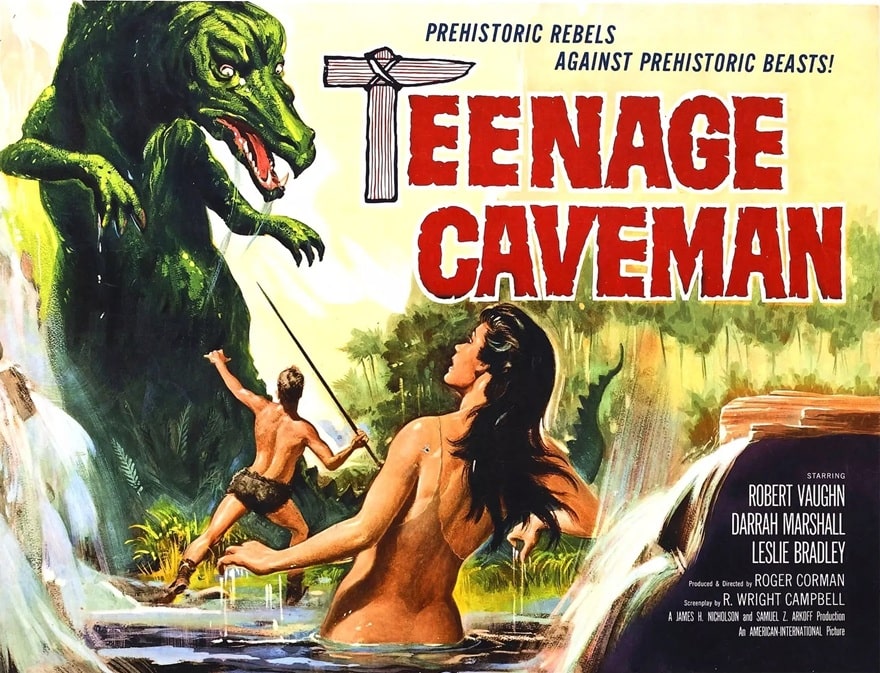 Teenage Caveman (American International Pictures, July 1, 1958)
Teenage Caveman (1958) Prime (AMC+)
Teenage Caveman (American International Pictures, July 1, 1958)
Teenage Caveman (1958) Prime (AMC+)
Yes, I started a free 30-day trial sub to AMC+ just so that I could watch this movie without the MST3K voice track. Such is my commitment to this pointless exercise in procrastination.
Anyhoo — here we have Roger Corman writing and banging out a caveman film in a couple of weeks. All shot on one California location, amply sprinkled with footage from other AIP flicks, featuring a very young Robert Vaughn as a young ‘cave person’ in the midst of an existential crisis. The clan he belongs to is the cleanest, whitest bunch of knuckle-draggers you’ve ever seen, and their hair is perfect. They all adhere to a bunch of rules attributed to Sky Gods and Monsters (TM), but Bobby Vaughn ain’t down with no rules, daddio.
He rebels, as all teens should, and while the elders sit around at camp discussing the rules, he goes out to see what’s so dangerous about the other side of the river. Here’s the thing, despite it being cheesy as hell, and somewhat laughable, Vaughn plays it straight (the right choice) and Corman clubs us around the head with a killer twist. I rather enjoyed it. Second film to feature a dude in a bear costume too, so it gains back the mark I was about to take away for the cruel real animal fighting.
6/10
 Iceman (Echo Film/Lucky Bird Pictures, 2017)
Iceman (2017) Tubi
Iceman (Echo Film/Lucky Bird Pictures, 2017)
Iceman (2017) Tubi
Based on a 5300-yr-old mummy found by hikers in 1991, this German production proceeds to tell the imagined last days of a Neanderthal man, Kaleb. It’s a simple revenge flick, told in the ancient Rhaetic language, and is beautifully shot through with a suitably grim palette.
Jürgen Vogel as Kaleb is brilliant, bringing physical and emotional heft to every scene, and it was a treat to see Franco Nero pop up. It’s solid, at times horrific, and a reminder that revenge is a dish best served hunted, skinned and roasted.
8/10
 Stone Age Sirens (Retromedia Entertainment, November 16, 2004)
Stone Age Sirens (2004) Tubi
Stone Age Sirens (Retromedia Entertainment, November 16, 2004)
Stone Age Sirens (2004) Tubi
Another Fred Olen Ray flick (credited as Nicholas Medina, his soft-core pseudonym), this one is a heavily edited version of the film Teenage Cave Girl, heavily edited to the point where there’s no actual Neanderthal nookie on display at all. By cutting out all the sex scenes, what you are left with is a rubbish comedy about a pair of cave dwellers who are transported to the future and fall in with some randy archeologists (there’s more than you knew).
Peppered with stop-mo shots stolen from Planet of the Dinosaurs and some abominable CG in all its 8-bit glory, this is the usual slice of fried shite I’ve come to expect from the once great Ray. It gets a point for only being 46 minutes long.
1/10
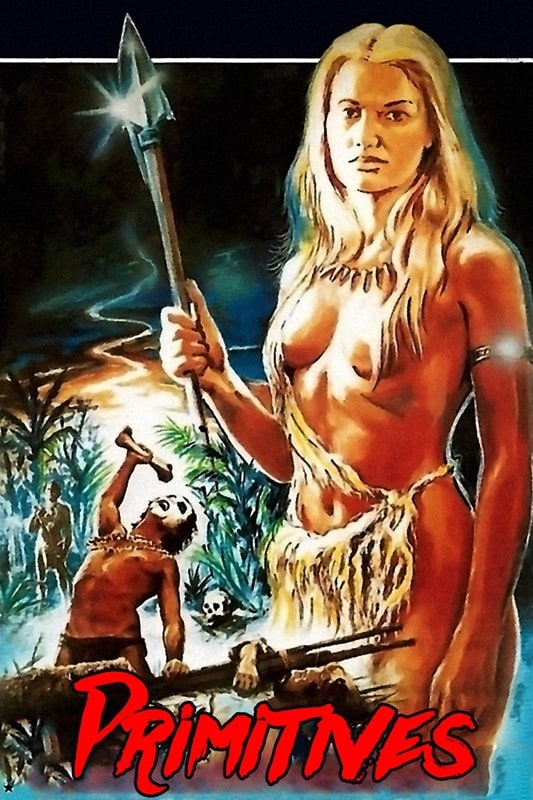
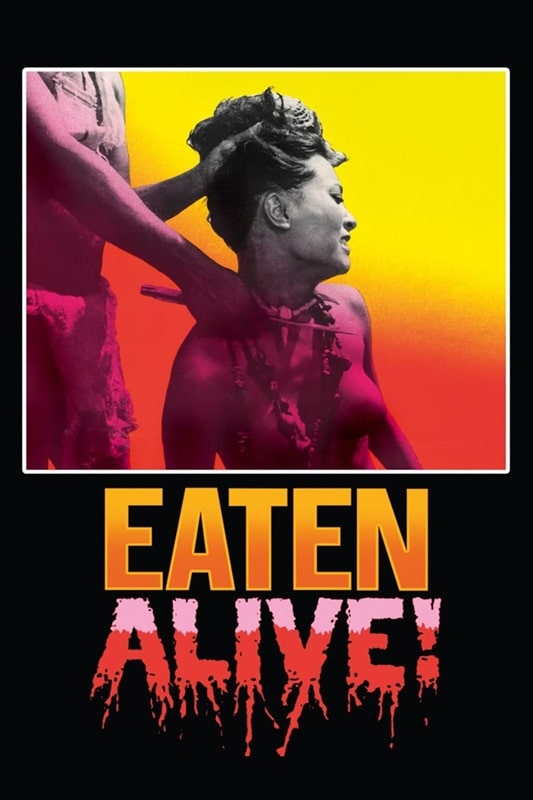
Primitives (Rapi Films, 1978) and Eaten Alive! (Dana Film, March 20, 1980)
This one is an Indonesian version of the Italian jungle exploitation flicks, and doesn’t just follow a similar plot, but lifts whole sequences directly for previous fare such as Cannibal Holocaust. In fact, it’s pretty shameless how much is ripped off from that movie, right down to locations and set pieces (although it stops short of actual tallywhacker removal). It’s full of the usual grunting and chomping, and the filmmakers seemed to double-down on the animal cruelty, using horrific footage from previous films.
It’s a miserable viewing experience, and I’m only giving it an extra mark for the shameless stealing of inappropriate music (Kraftwerk’s ‘The Robots, a trio of Jean Michel Jarre tracks and Princess Leia’s theme) and a hilarious rubber axe boomerang scene.
4/10
Eaten Alive! (1980) TubiNot to be confused with the Tobe Hooper ‘gator romp, this is another Italian cannibal flick that starts interestingly in New York, but then descends into the usual animal torture and misogyny associated with these films.
It’s held together by a flimsy ‘Jonestown’ plot, but this was the one that officially finished me off — I am totally done with this genre and never need to see another jungle cannibal film ever again. Hateful.
1/10
Previous Murkey Movie surveys from Neil Baker include:
There, Wolves
What a Croc
Prehistrionics
Jumping the Shark
Alien Overlords
Biggus Footus
I Like Big Bugs and I Cannot Lie
The Weird, Weird West
Warrior Women Watch-a-thon
Neil Baker’s last article for us was There, Wolves: Part III. Neil spends his days watching dodgy movies, most of them terrible, in the hope that you might be inspired to watch them too. He is often asked why he doesn’t watch ‘proper’ films, and he honestly doesn’t have a good answer. He is an author, illustrator, outdoor educator and owner of April Moon Books (AprilMoonBooks.com).
Rules for Mega-Dungeon Adventuring: Dragonslayer by Greg Gillespie
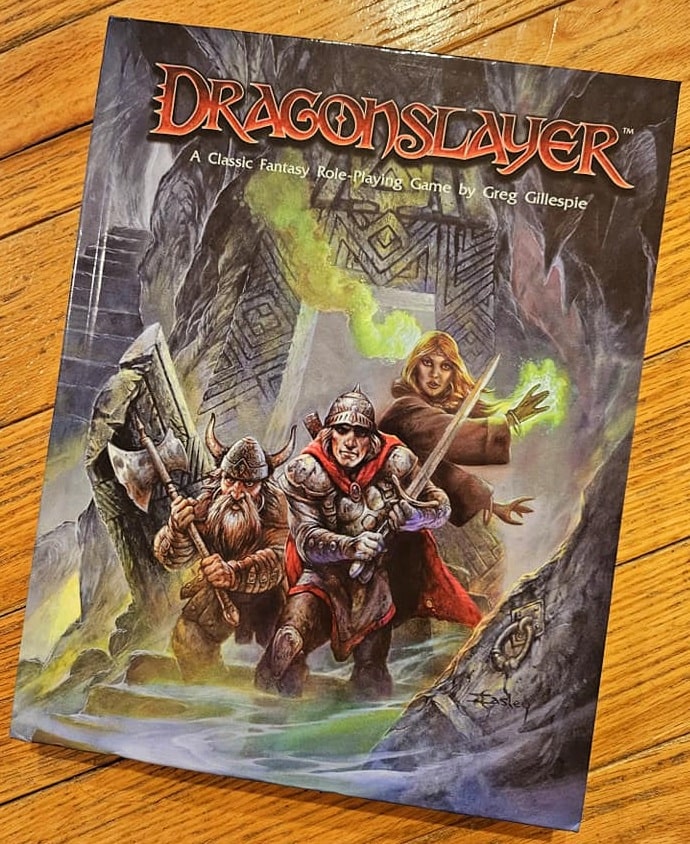
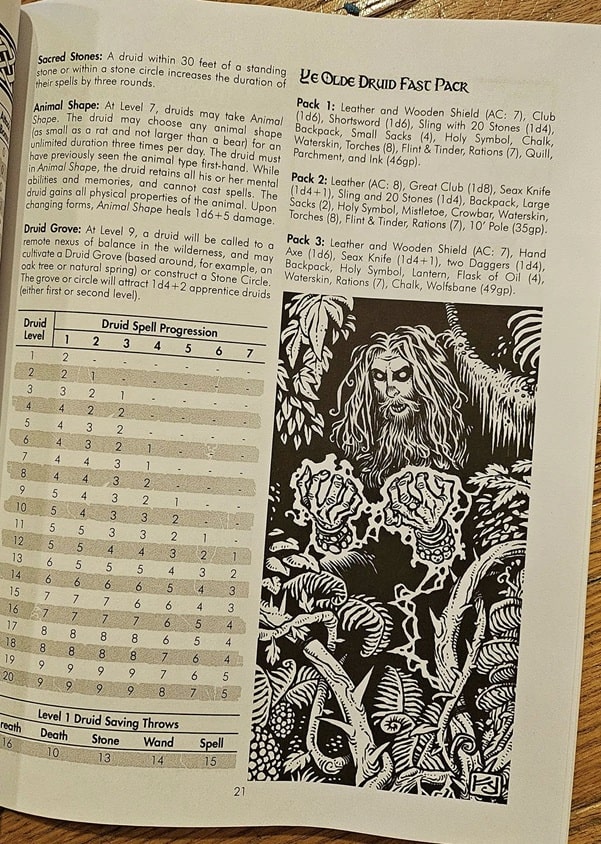
Dragonslayer (OSR Publishing, February 7, 2024). Cover by Jeff Easley
I’ve admired the mega-dungeon adventures of Greg Gillespie for several years, particularly Barrowmaze and The Forbidden Caverns of Archaia. Most recently, Greg published his own set of rules to go with those adventures. It’s called Dragonslayer, and I think it’s excellent. Here is the description from the back of the book:
Journey to a realm of myth and magic, where ancient legends and terrifying minsters come to life, and adventure awaits…
Inspired by the timeless role-playing tradition of the early 1980s, this ruleset seamlessly integrates the simplicity of B/X with the chrome if First Edition. The book has everything you need: classes, spells, monsters, and treasure, combined in a single volume.
For those who don’t know, “B/X” is the acronym for the Basic and Expert rules of Dungeons & Dragons.
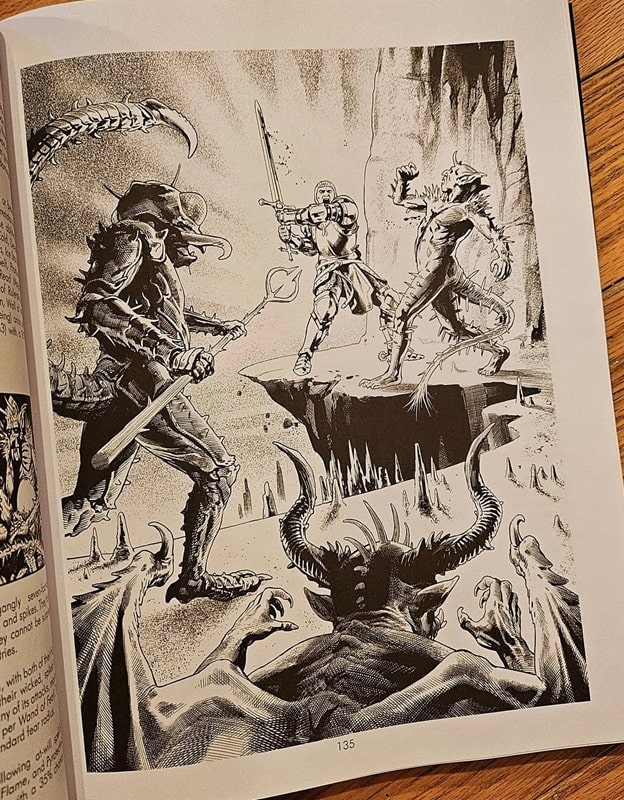
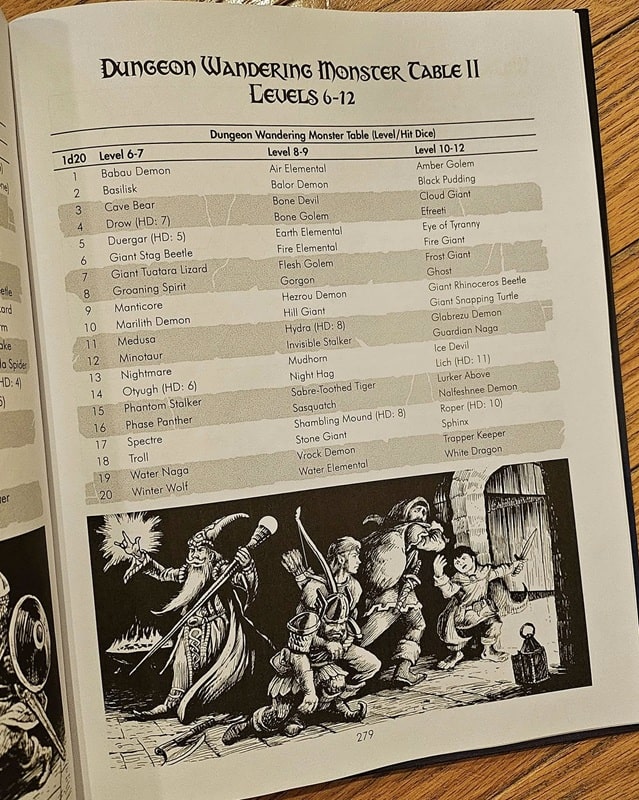
Interiors from Dragonslayer
The Basic and Expert rules were conceived by Tom Moldvay and Zeb Cook, who in turn derived their inspiration from the works of Gary Gygax and Dave Arneson — and also the previous Basic set (my personal favorite) compiled by John E. Holmes.
B/X is probably the most “cloned” version of D&D, yet Greg establishes his own flavor, quite admirably, within that framework. It’s nicely done!
Lastly, it’s really great to see art from the likes of Jeff Easley, Diesel LaForce, and Darlene Artist. All legends of the hobby whose work I have admired for decades.
Jeffrey P. Talanian’s last article for Black Gate was a review of Robert E. Howard’s “Worms of the Earth.” He is the creator and publisher of the Hyperborea sword-and-sorcery and weird science-fantasy RPG from North Wind Adventures. He was the co-author, with E. Gary Gygax, of the Castle Zagyg releases, including several Yggsburgh city supplements, Castle Zagyg: The East Mark Gazetteer, and Castle Zagyg: The Upper Works. Read Gabe Gybing’s interview with Jeffrey here, and follow his latest projects on Facebook and at www.hyperborea.tv.
We No Longer Need Aliens to Feel Alienated: State of Paradise by Laura Van Den Berg
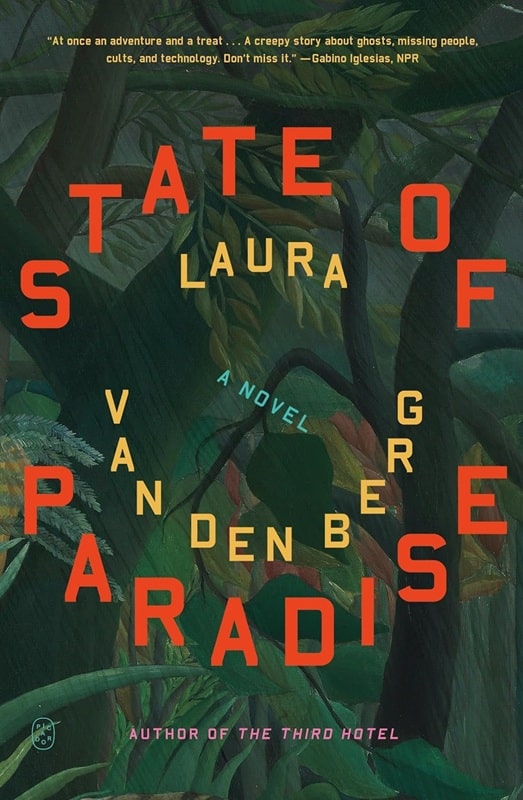

State of Paradise (Picador paperback reprint, July 8, 2025). Cover art:
detail from Tiger in a Tropical Storm by Henri Rousseau, 1891
When I was a kid there was a public service announcement on TV that went something like “Attention: Aliens. You are required by law to report by January 31st.” This was because of the Alien Act of 1940, otherwise known as the Smith Act. Basically, the legislation made it illegal to advocate the violent overthrow of the U.S. government and provided for a tracking system of non-citizens who, in the context of Nazi occupation of Eastern Europe and its then alliance with the Soviet Union, were potential suspects of espionage and sabotage. (Fun fact: prosecutions for advocating overthrow of the government have been ruled as unconstitutional violations of the First Amendment, in case you were wondering how any nitwit on social media can mouth off about doing just that.)
But as I didn’t know anything about this, the announcement always conjured an image of big headed, bug-eyed tentacled Martians registering at the local post office. Which I thought pretty funny. One thing I’ve learned over the years, and particularly these days, is that much of what adults say in all seriousness is often funny, but not in a “ha ha” way. More in a Jean Paul Sartre absurdist kind of way.
Needless to say, alien life forms are foundational science fiction, horror, and fantasy tropes. While some genre writers and filmmakers may very well have thought it just might be cool to tell stories about monsters from other worlds, the notion of aliens amongst us primarily serve as metaphors for, among other things, Communists and related usurpers of “normal” socio-political mores, fears of nuclear holocaust, technology run amok, repressed sexual desire, climate change, disease, and disembodiment.
Probably to a large extent due to the COVID-19 pandemic as well as severe climate events such as the California wildfires, today’s alienation storyline is less “aliens amongst us” and more “us alienated from the world.”
Which brings us to State of Paradise by Laura Van Den Berg.
The title is ironic, referring not only to Florida and its reputation as a refuge for the aged retired, the sunburned, and the weird, but that if the existential human condition is sometimes characterized using the Biblical metaphor of banishment from Eden, we currently find ourselves further away from Paradise than ever before.
In Florida, my husband runs. Ten miles a day seventy miles a week. a physical feat that is astonishing to me. He started running after he got stuck on a book he is trying to write, a historical account of pilgrims in medieval Europe. Back then it was not unusual for pilgrims to traverse hundreds of miles on foot… My husband is a trained historian and fascinated by journeys. He wants to understand what has become the pilgrimages in our broken modern world.
The first person narrator is
…a writer, though not a real one, I ghost for a very famous thriller writer. When I first got the job, I spent a month reading books by the famous author, to better understand the task that lay before me… the phrase everything is not as it seems appeared in nearly all the book descriptions.
Indeed, everything is not as it seems as the narrator (a kind of ghost herself) proceeds on a pilgrimage not only through actually weird Florida, where the 1930s Tarzan movies were filmed and non-native Pythons abound alongside Everglades alligators and Disney characters, but an alternate reality to which her sister and others somehow travel. Along the way are treated to torrential rain and flooding, sinkholes, virtual reality headsets, cults, and cats. And voluntary human extinction meetings. Just another day in Paradise.
With a history of being institutionalized, our narrator may be unreliable, and as a writer she is in the business of making things up. Not much cause for cognitive dissonance given the made-up unreliable narratives of our daily news cycle.
The plot, such that it is, concerns finding out what happened to her sister and others during their disappearances. And along the way what is happening to the narrator as she tries to figure out an increasingly strange world that nonetheless comes to define everyday existence. And whether she can trust what she is experiencing and what she remembers of those experiences.
Sometimes I wonder what we are supposed to do with our memories. Sometimes i wonder what our memories are for. A latch slips and the past floods in, knocking us flat. We leave places and we don’t leave places. Sometimes I imagine different versions of myself in all the different places I have ever lived, inching time in parallel.
This is a novel about the proverbial frog in boiling water, how because as the temperature only gradually rises, we don’t realize we’re being cooked. One absurdity follows another, and it is just how things are. We are now the aliens, journeying towards some unsettling destination, and we don’t have to bother to report.
One of the weirdest things about this period of time is the parts that still seem normal. Mundane and non-apocalyptical. Like how one minute we need an inflatable raft to cross the street and another we’re eating pasta at my sister’s house.
Or as Alice Cooper put it, “Welcome to my nightmare.”
David Soyka is one of the founding bloggers at Black Gate. He’s written over 200 articles for us since 2008. His most recent was a review of Polostan by Neal Stephenson.
Of Men, Monsters, and Little People
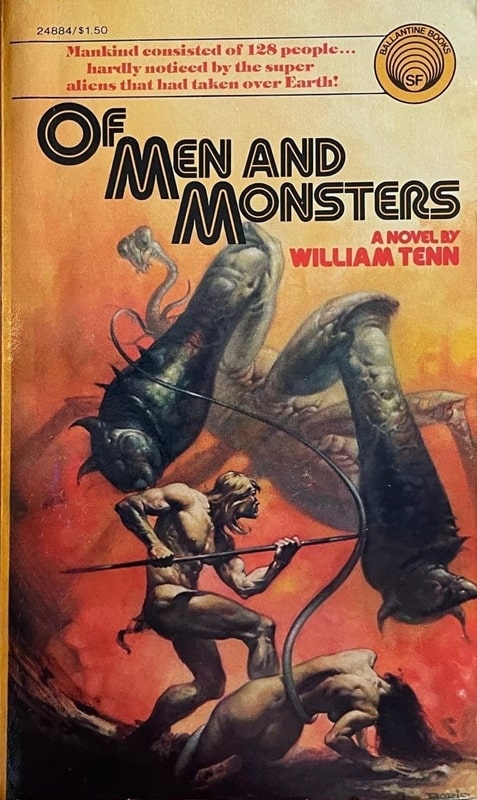
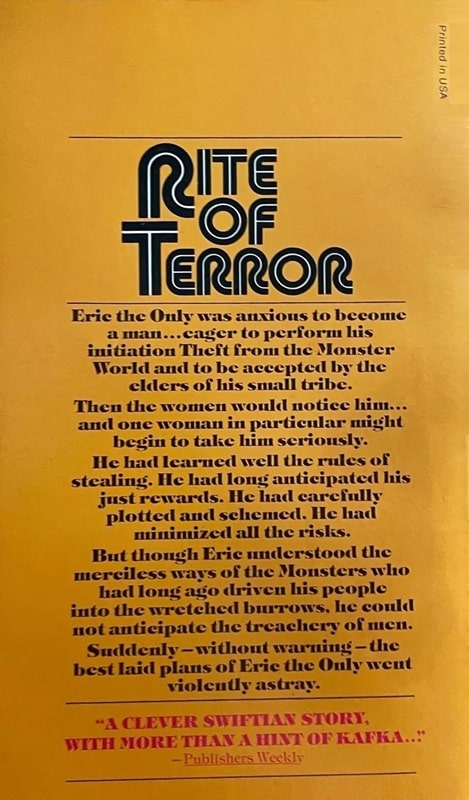
Of Men and Monsters, by William Tenn
(Ballantine Books, December 1975). Cover by Boris Vallejo
After posting about The Borrowers by British author Mary Norton (1903 -1992) last week, several people mentioned other books and movies with similar kinds of themes — little people living in the houses of big people. I thought I might take another post to discuss a few other examples from my own book collection.
First up is series by American author John Peterson (1924 – 2002). The first one was just called The Littles and was published in 1967, 15 years after The Borrowers (1952). The Littles live much like the “borrowers. They look human except for having tails. (In films they apparently look very mouselike but that’s not the case in the books.)
[Click the images for less little versions.]
 The Littles, by John Peterson (Scholastic Books, 1991-1993 editions). Covers by Jacqueline Rogers.
The Littles, by John Peterson (Scholastic Books, 1991-1993 editions). Covers by Jacqueline Rogers.
Unlike with The Borrowers, I never heard of The Littles until I was buying books for my own son, (Josh), even though many were written when I was a kid. I stopped by Josh’s school to pick him up one day and they were having the Scholastic Book fair.
When I was a kid, we never had a fair where you could actually see the books, but we did get the order forms and I bought quite a few books through them for 25 cents or so when in grade school. I had to stop by this one at my son’s school and found out about The Littles. I bought every one they had, ostensibly for my son but at least halfway for myself. I read them all, too, although I don’t think Josh read them all.
There are a bunch of these books and more were written after Peterson’s death, but here are the ones I have. All covers are by Jacqueline Rogers, with charming interior illustrations by Roberta Carter Clark. (These are written specifically for children and I don’t think the stories are as good as in The Borrowers series, but they are fun.)
The Littles, 1967
The Littles have a Wedding, 1971
The Littles and the Trash Tinies, 1977
The Littles Go Exploring, 1978
The Littles and the Lost Children, 1991
The Littles and the Terrible Tiny Kid, 1993
In my twenties I came upon another series about tiny people. This was a trilogy by Gordon Williams (1934 – 2017) that included The Micronauts (1977), The Microcolony (1979), and Revolt of the Micronauts (1981) — all from Bantam Books.
 The Micronauts by Gordon Williams (Bantam Books, August 1977, May 1979, and August 1981). Covers by Boris Vallejo, Lou Feck, and Peter Goodfellow
The Micronauts by Gordon Williams (Bantam Books, August 1977, May 1979, and August 1981). Covers by Boris Vallejo, Lou Feck, and Peter Goodfellow
These are SF novels, not to be confused with the toy series and comic book series from Marvel with the same name — which I’d never heard of until I started looking into stuff for this post. The difference here is normal sized people are cloned at 1/8th their natural size in order to deal with a catastrophic future where most natural resources have been exhausted. The experiment is set up in a controlled environment but things soon get out of control.
I liked all three very much and they had some cool covers. The Micronauts has a Boris Vallejo cover and interior illustrations. The Microcolony has a wonderful Lou Feck cover that I love. Revolt has a Peter Goodfellow cover.

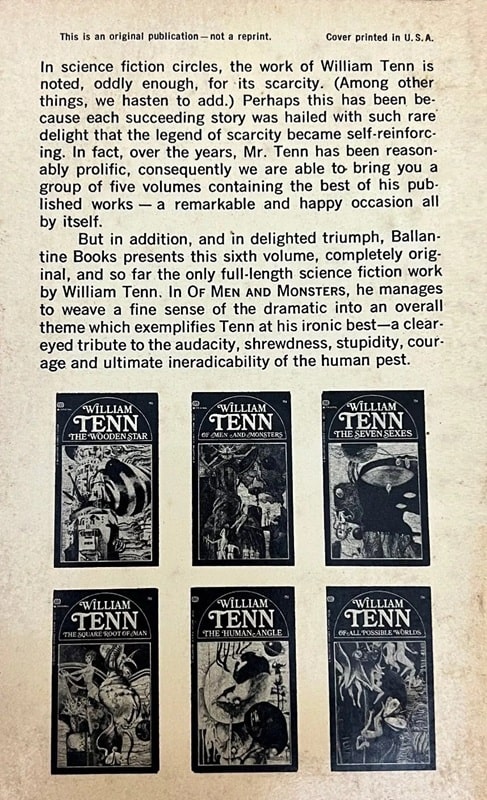
Of Men and Monsters, by William Tenn
(Ballantine Books, June 1968). Cover by Stephen Miller
The last book I’ll review today is one of the first adult SF novels I ever read, Of Men and Monsters, by William Tenn (1920 – 2010). It’s still a fond memory. Tenn was the pseudonym for a British born author named Phillip Klass, although he moved to the US before he was 2. The book was published in 1968 and I read it in a library edition, but years later I bought a Del Rey printing with a great cover by Boris Vallejo (see top).
This one has its own twist on the theme. The people are normal sized, but they are survivors of an invasion by gigantic aliens so huge that the humans can live like mice in their walls. I just loved it, and found out from Adam Tuchman on Facebook that it was originally published in a shorter version in the October 1963 issue of Galaxy, called “The Men in the Walls.”
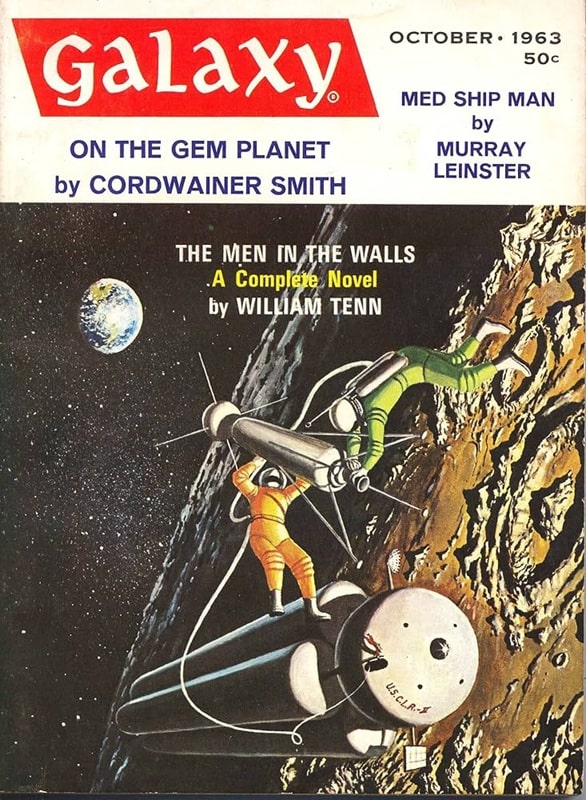
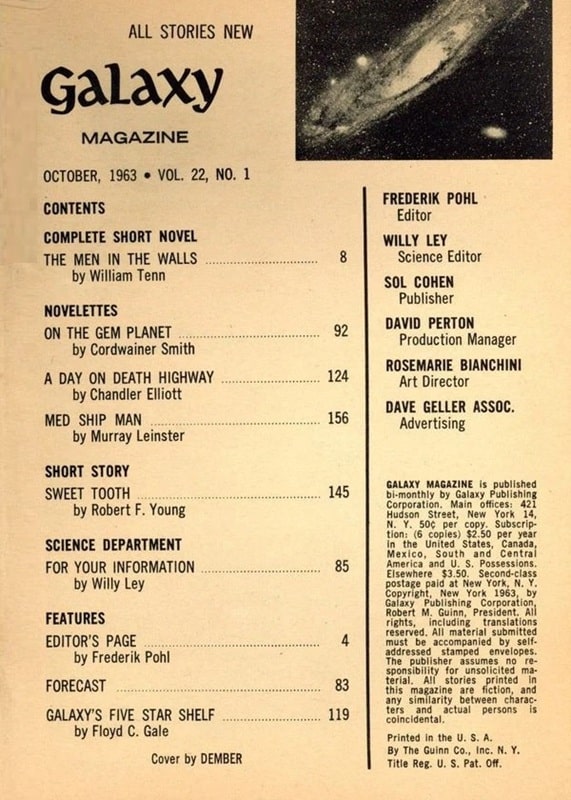
Galaxy, October 1963, containing “The Men in the Walls,” plus stories
by Cordwainer Smith, Murray Leinster, and more. Cover by McKenna
I’ll note that the ending Of Men and Monsters takes us into Sword & Planet territory.
There are plenty more I could talk about here, such as Lindsay Gutteridge’s Cold War in a Country Garden Trilogy, and Ben Sheppard reminded me of an awesome story called “Surface Tension” by James Blish, which deals with the miniaturization theme. There’s Asimov’s Fantastic Voyage, and even the movie Honey, I Shrunk the Kids, but this post is getting long as it is.
Charles Gramlich administers The Swords & Planet League group on Facebook, where this post first appeared. His last article for Black Gate was And Now For Something Completely Different: The Borrowers, by Mary Norton.
Taking the Ridiculous Seriously
 Look! It’s fun! Image by Patrycja Kwiatkowska from Pixabay
Look! It’s fun! Image by Patrycja Kwiatkowska from Pixabay
Good afterevenmorn!
I hope everyone who has to suffer through the daylight savings shift Sunday are coping with losing that hour of sleep. To those to whom that does not apply, know that I am fiercely jealous of you. But let’s not dwell on our minor hardships. Today, I want to talk about writing, and very specifically how to make situations that are absolutely ridiculous on the outside feel real and very serious.
This came to me as I walked home from work today, thinking of my serialised novel (online on my blog every Friday until it concludes… look at me dropping a plug). It has, if you were to distill it down, the silliest, most ridiculous premise you could possibly imagine: Zombies, but make them hyper-aggressive, human-sized fairies.
Yup.
It’s so dumb. On the outside of it. And to be fair, I had so much fun writing it; giggling like a twit at how silly it all actually is. I take great delight in pointing out the hilariously ridiculousness of the premise. If I managed to do it well, then it will feel a good deal more serious than it seems when you distill it. If I pulled it off, it won’t feel how ridiculous it is. Whether I did or not is not really for me to decide, but here are some things I did in an effort to make it work. Maybe they’re something you can think about if you find yourself in a similar situation.
 Image by Prawny from Pixabay
Image by Prawny from Pixabay
1. The situation might be ridiculous, but your characters don’t know that.
Let’s be honest. If you’re fighting for your life in a city that has been overtaken by a swarm of mindless winged humanoid killers, you’re probably going to be too busy trying to survive to worry about how silly it all actually is. That might come later, after you have done the surviving. If your characters treat their situation seriously (and it kinda is; they’re fighting for their lives), it’ll be much easier for your readers to suspend their disbelief while reading it. They’ll buy human-sized fairies attacking in swarms and consuming a city of millions in less than twenty-four hours.
It will probably also help to have at least one character who is familiar with really weird situations. Think of Mulder and Scully in the X-Files. They’re constantly facing things that, on the outside, are completely unbelievable, even ridiculous. But it works precisely because they take it seriously when they’re in the moment, and Mulder is a believer. However weird or out there a situation is, Mulder just accepts is as fact and rolls with it. It makes it easy for the viewer to do the same.

2. The situation is ridiculous, and your characters absolutely know it.
This isn’t an and/or situation with number one, trust me. If I found myself facing a mindless winged humanoid, I would absolutely demand of no one in particular what the actual f[redacted]. Having a character call out the idiocy of the situation they find themselves in — while taking it very seriously — is may be a way to get readers on board. This is especially true if the world you’ve built is encountering the situation for the first time.
If winged humanoids are a normal thing in the world, then having a character acknowledge how stupid that seems, will probably distance the reader and make it hard for them to suspend their own disbelief. However, if these creatures are not a part of your characters’ every day reality then having someone be absolutely incredulous at the situation they face will help your reader relate, making it easier for them to sink into the story.
It works for me, in any case. If the characters I’m reading aren’t absolute morons that question absolutely nothing, then I’m much more amenable to accept the scenarios they’re put through. Mind you, I’m not an especially critical reader, so I get sucked into stories a lot more frequently than most. It is both a blessing and a curse.
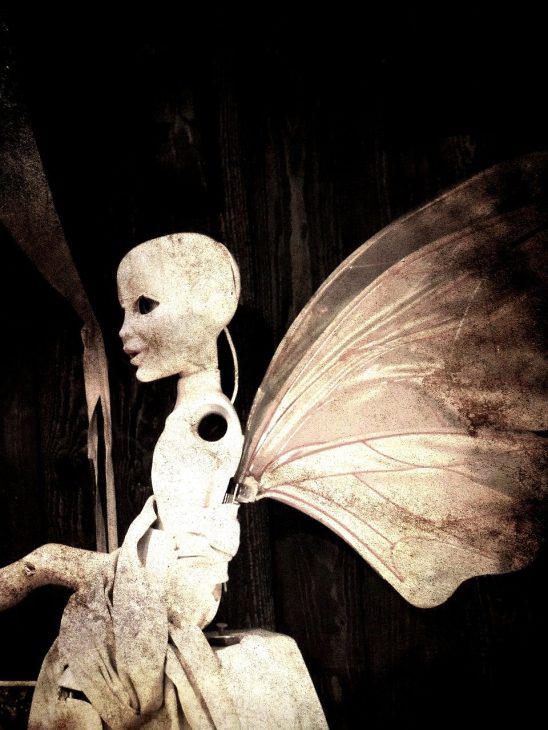 Image by Karen Nadine from Pixabay
Image by Karen Nadine from Pixabay
3. Keep it grounded
This might sound impossible, given the fantastic situation you’re trying to create, but keeping it as grounded as possible will help. There are a number of ways to do this. Providing real consequences for mistakes is one. Have people get hurt, or die. People will suffer in these situations if they ever actually happened; there will be grief, and fear, and anger. You’re already stretching incredulity with the situation. Have everyone dancing along unscathed will be pushing it much too far. This is especially important if it’s not taking place in a world that is easily relatable. I got a leg up, because the serial is set in a fictional city, but in the real world and set in 2024. There are a lot of touchstones that are easily digested for a reader.
It becomes harder if the entire world is fantastical. Finding something grounding in a world where trees talk or teleport, or whatever, is much harder. It’s not impossible, though. Find those touchstones and use them.
Did I achieve creating a story that brings people along and has them absolutely invested while also having gate silliest premise I think I could possibly conjure? No idea. But I tried, and I used these three (and other) things in the attempt. Maybe they’ll help you, too. If you’ve read books or are currently writing one which has an absolutely ridiculous premise, let me know what, and what worked (or didn’t). If you have any tips of your own for making a silly premise both believable and feel serious, also let me know in the comments below.
When S.M. Carrière isn’t brutally killing your favorite characters, she spends her time teaching martial arts, live streaming video games, and cuddling her cat. In other words, she spends her time teaching others to kill, streaming her digital kills, and a cuddling furry murderer. Her most recent titles include Daughters of Britain, Skylark and Human. Her serial The New Haven Incident is free and goes up every Friday on her blog.

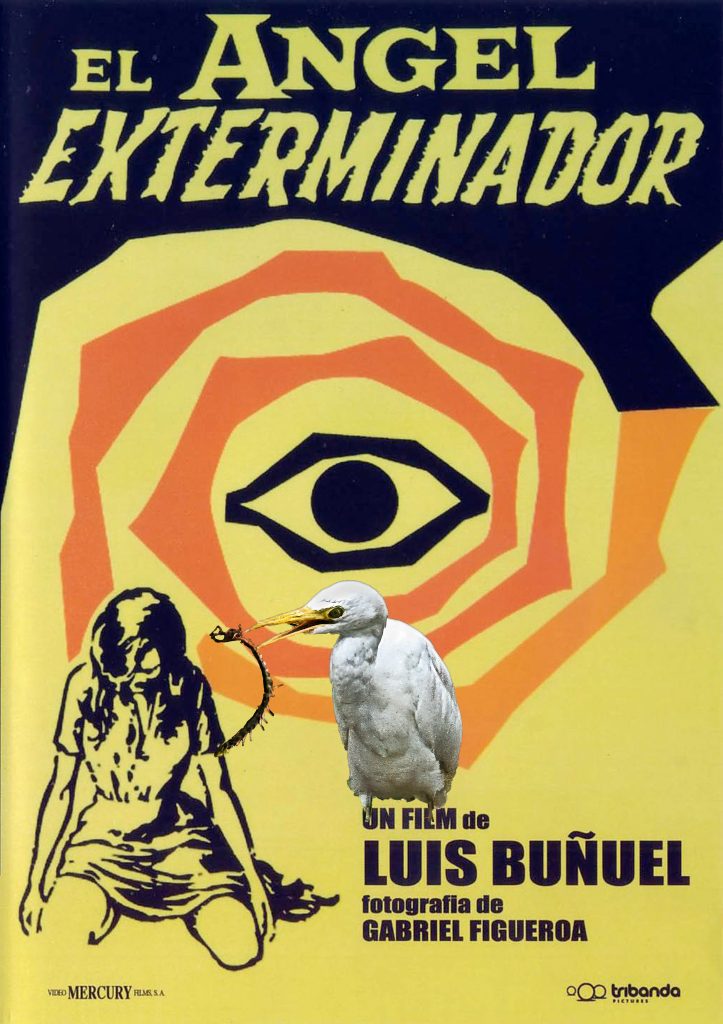



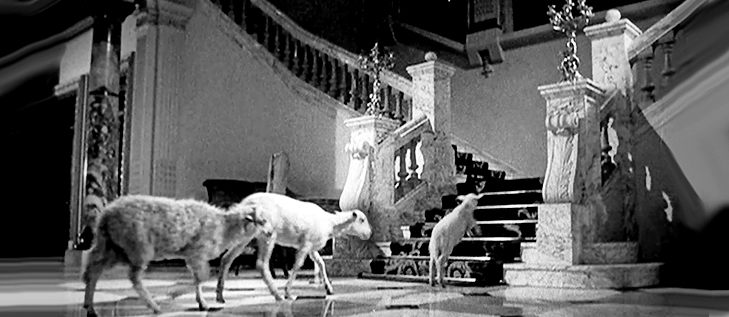








Recent comments